Physical Address
304 North Cardinal St.
Dorchester Center, MA 02124
Most of us think of our skin as a simple, durable covering for our skeleton, muscles, and internal organs. However, the skin is a complex organ, in fact the largest organ of the body, consisting of many parts and appendages ( Fig. 8.1 ). The outermost layer, the stratum corneum, is an effective barrier to irritants, toxins, and organisms, as well as a membrane that holds in body fluids. The remainder of the epidermis manufactures this protective layer. Melanocytes within the epidermis help protect us from the harmful effects of ultraviolet light, and Langerhans cells are one of the body’s first lines of immunologic defense.
The dermis, consisting largely of fibroblasts and collagen, is a tough, leathery, mechanical barrier against cuts, bites, and bruises. Its collagenous matrix also provides structural support for a number of cutaneous appendages. Hair, which grows from follicles deep within the dermis, is important for warmth and protection from sunlight and particulate matter. Sebaceous glands are part of the follicular unit. Oil produced by these glands helps to lubricate the skin and contributes to the protective epidermal barrier. The nails are specialized organs of manipulation that also protect the sensitive digits. Thermoregulation of the skin is accomplished by eccrine sweat glands and changes in cutaneous blood flow, which is regulated by glomus cells. The skin also contains specialized receptors for heat, pain, touch, and pressure. Sensory input from these structures helps to protect the skin surface against environmental trauma. Beneath the dermis, in the subcutaneous tissue, fat acts as stored energy and as a soft, protective cushion.
Defects or alterations in any component of the skin may result in serious systemic disease or death. Each and every part of the skin can be affected by congenital, inflammatory, infectious, and degenerative disorders and tumors. For example, an altered stratum corneum is seen in ichthyosis; melanocytes are selectively destroyed in vitiligo; the epidermis proliferates excessively in psoriasis; excess collagen is produced in the connective tissue nevus of tuberous sclerosis; hair follicles are focally affected in alopecia areata; and so on. In addition, the skin is affected by many systemic diseases and thus may provide visible markers for internal disorders. A skin examination may demonstrate lesions of vasculitis, explaining a child’s hematuria. The hypopigmented macules of tuberous sclerosis may give insight into the cause of a child’s seizures.
The skin is the largest, most accessible, and most easily examined organ of the body and is the organ of most frequent cosmetic concern to patients. Therefore physicians should be able to recognize basic skin diseases and dermatologic clues to systemic disease.
Optimal examination of the skin is performed in a well-lit room. The physician should inspect the entire skin surface, including hair, nails, scalp, and mucous membranes. This may be particularly challenging with infants and teenagers because it may be necessary to examine the skin in small segments to prevent cooling or embarrassment. Although no special equipment is required, a hand lens and side lighting aid in the assessment of skin texture and small, discrete lesions. For practitioners who specialize in dermatology, a handheld dermatoscope is invaluable, specifically for assessing pigmented lesions. A Wood lamp improves precision in distinguishing hypopigmented lesions, which do not enhance under Wood lamp, from depigmented patches of skin, which enhance and appear more prominent under Wood lamp exam.
Despite the myriad conditions affecting the skin, a systematic approach to the evaluation of a rash simplifies the process of developing a differential diagnosis. After assessing the patient’s general health, the practitioner should obtain a detailed history of the skin symptoms, including the date of onset, inciting factors, evolution of lesions, and presence or absence of any other systemic symptoms. Recent immunizations, infections, drugs, and allergies may be directly related to new rashes. The family history may suggest a hereditary or contagious process, and the clinician may need to examine other members of the family. Review of nursery records and photographs helps to document the presence of congenital lesions. In this modern age of technology, parental photos can be instrumental in charting the progression of a rash. Attention should then turn to the distribution and pattern of the rash. The term distribution refers to the location of the skin findings, whereas the term pattern defines a specific anatomic or physiologic arrangement (e.g., the distribution of a rash may include the extremities, face, or trunk, and the pattern could be diffuse, flexural, or intertriginous). Identification of a pattern can assist in the development of a differential diagnosis even before the detailed morphology of the skin lesions is studied. Other common patterns include photo distributed (involving sun-exposed sites), acral (involving primarily the distal extremities), and dermatomal configurations ( Fig. 8.2 ).
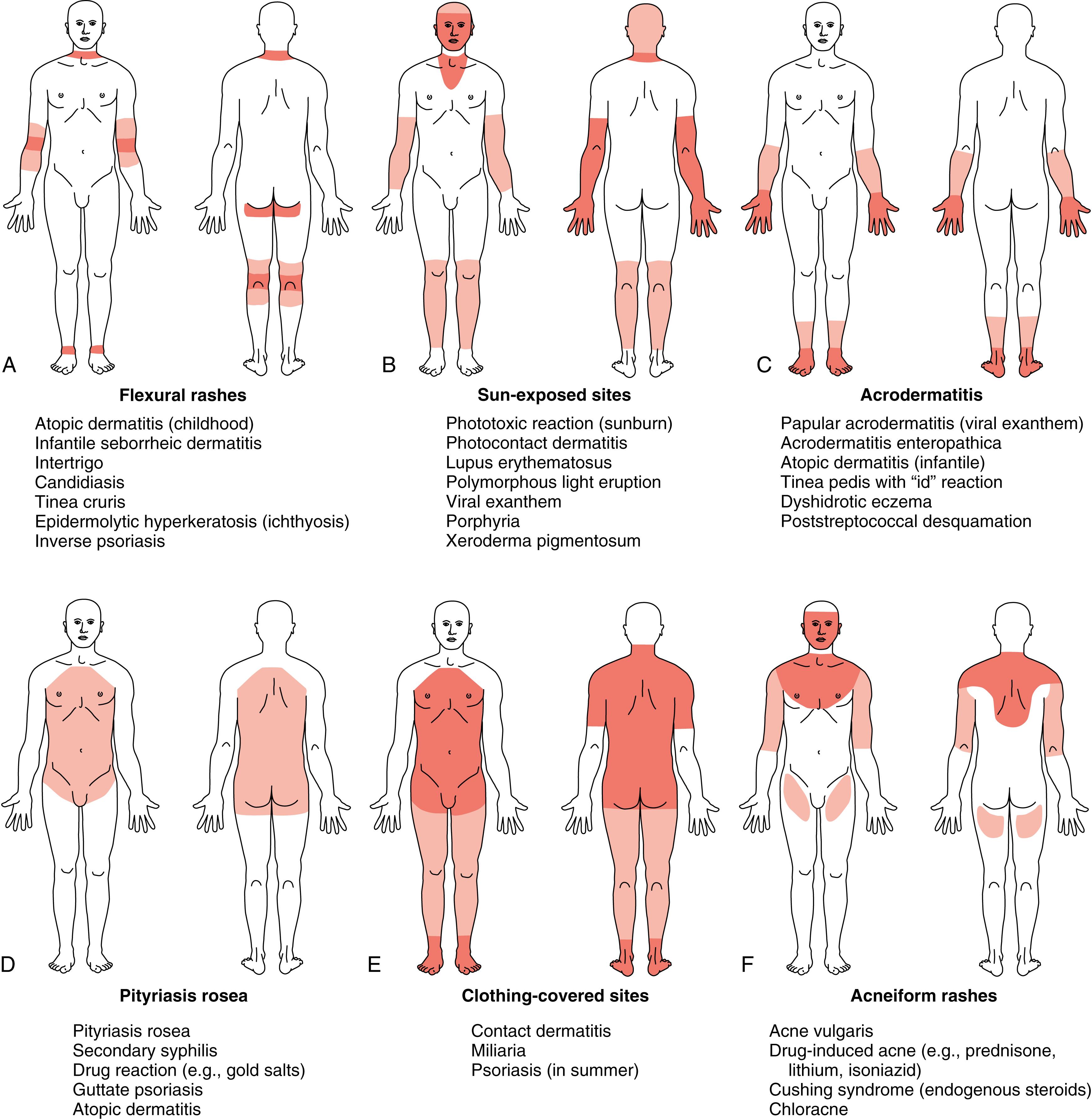
Next, the clinician should consider the local organization of the lesions, defining the relationship of primary and secondary lesions to one another in a given location. Are the lesions scattered or clustered? Are they linear, grouped, serpiginous, confluent, or discrete?
Last, the practitioner should identify the morphology of the cutaneous lesions. Primary lesions (macules, papules, pustules, wheals, plaques, vesicles, bullae, nodules, and tumors) arise de novo in the skin. Secondary lesions (erosions, ulcers, crusts, excoriations, fissures, lichenification, atrophy, and scars) evolve from primary lesions and often result from the patient’s manipulation (e.g., scratching, picking, or popping) of primary lesions. Delineation of the primary and secondary lesions allows the clinician to develop a differential diagnosis on the basis of the anatomic level of the skin lesions ( Table 8.1 ). Disorders restricted to the epidermis may be associated with macular color changes, such as in vascular telangiectasias, freckles, and vitiligo. In epidermal disorders, surface markings are commonly altered by scales, vesicles, pustules, crusts, and erosions. Bullous impetigo, atopic dermatitis, ichthyosis, and tinea corporis are primarily epidermal disorders. When the dermis is also involved, lesions usually display distinct borders because of dermal inflammation and edema. Disorders with both epidermal and dermal changes include psoriasis, lichen planus, and erythema multiforme (EM). Inflammatory disorders or tumors restricted to the dermis do not usually alter the surface markings. Lesional borders are distinct, and color changes and edema may be present. Examples of dermal disorders include granuloma annulare, intradermal nevi, and urticaria. The diagnosis of subcutaneous disorders is made by careful palpation. The surface markings are normal, and the color of the skin may be normal or red. There is altered skin firmness, and tenderness may be present. Subcutaneous lesions include lipomas, deep hemangiomas, hematomas, subcutaneous fat necrosis, and erythema nodosum.
| Cutaneous Structure | Physical Findings | Specific Skin Disorders |
|---|---|---|
| Epidermis | Altered surface markings | Impetigo |
| Scale, vesicle, crust | Café au lait spot | |
| Color changes (black, brown, white) | Atopic dermatitis | |
| Vitiligo | ||
| Freckle | ||
| Epidermis and dermis | Altered surface markings | Psoriasis |
| Scale, vesicle, crust | Atopic dermatitis | |
| Distinct borders | Contact dermatitis | |
| Color changes (black, brown, white, and/or red) | Cutaneous lupus erythematosus | |
| Edema | ||
| Dermis | Normal surface markings | Urticaria |
| Color changes | Granuloma annulare | |
| Altered dermal firmness | Hemangioma | |
| Blue nevus | ||
| Subcutaneous tissue | Normal surface markings | Hematoma |
| Normal or red skin color | Cold panniculitis | |
| Altered skin firmness | Erythema nodosum |
Because an outline of specific pediatric dermatoses defies any one scheme of organization, this text follows a clinically practical format. First, this chapter covers common papulosquamous and vesiculopustular eruptions, which account for a majority of rashes seen in children. This is followed by sections covering reactive erythema, insect bites and infestations, tumors and infiltrations of the skin, neonatal dermatology, congenital and acquired nevi, and disorders of pigmentation. The chapter concludes with a discussion of disorders of the hair and nails and complications of topical therapy. Vascular lesions and hemangiomas are addressed in Chapter 10 .
Papulosquamous eruptions share the morphologic features of papules and scales. However, the clinician must understand that the papulosquamous disorders, which are quite diverse, are produced by a variety of different mechanisms. In psoriasis, increased turnover of keratinocytes by the basal cell layer results in a markedly thickened epidermis and stratum corneum (scaly surface layer). In dermatitic processes (e.g., atopic dermatitis, contact dermatitis, seborrheic dermatitis, pityriasis rosea, and fungal infections), inflammation results in increased production and abnormal maturation of epidermal cells, with subsequent scale production. Increased adherence of cells in the stratum corneum may result in the retention hyperkeratosis characteristic of ichthyosis vulgaris, which is frequently found in association with atopic dermatitis.
Psoriasis is a common disorder characterized by erythematous, well-demarcated plaques covered with silvery scale. These have a predilection for the extensor surfaces of the extremities, the scalp, and the buttocks. In some patients, the distribution consists of large lesions over the pressure points of the knees and elbows ( Fig. 8.3A – D ). Thickening and fissuring of the skin of the palms may also be seen (see Fig. 8.3E ). In some children, numerous drop-like (guttate) lesions are found scattered over the body ( Fig. 8.4 ), often after a bout of group A β-hemolytic streptococcal infection either of the throat or perianal area (which may have been recognized or subclinical). In infants, psoriasis may present as persistent, confluent diaper dermatitis (see Fig. 8.47 ). Lesions of psoriasis are often induced at sites of local injury (e.g., friction, scratches, surgical scars, or sunburns), a response termed the Koebner phenomenon ( Fig. 8.5 ). Nail changes include reddish-brown psoriatic plaques in the nail bed (oil drop changes), surface pitting, and distal hyperkeratosis (see Fig. 8.140 ).
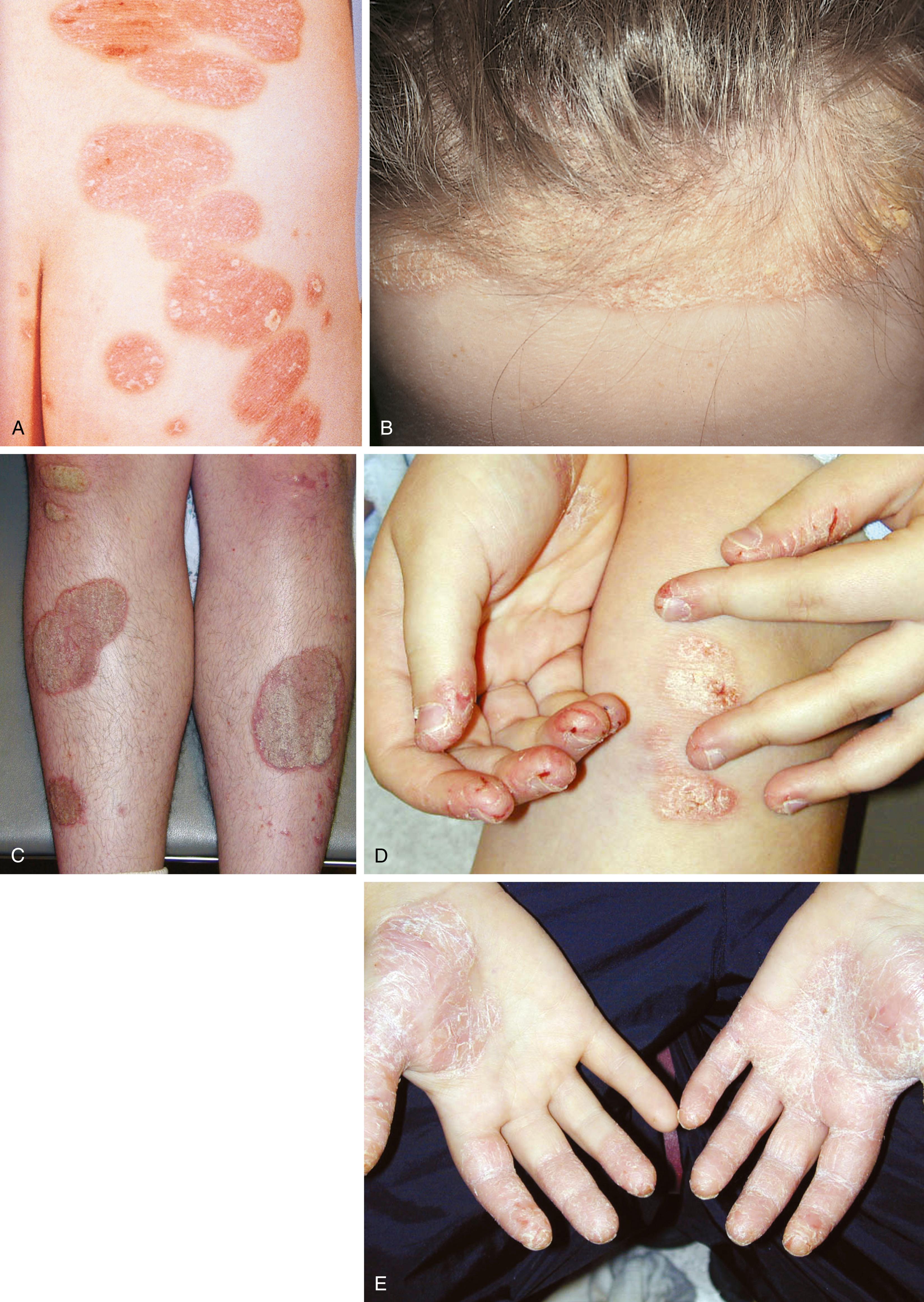
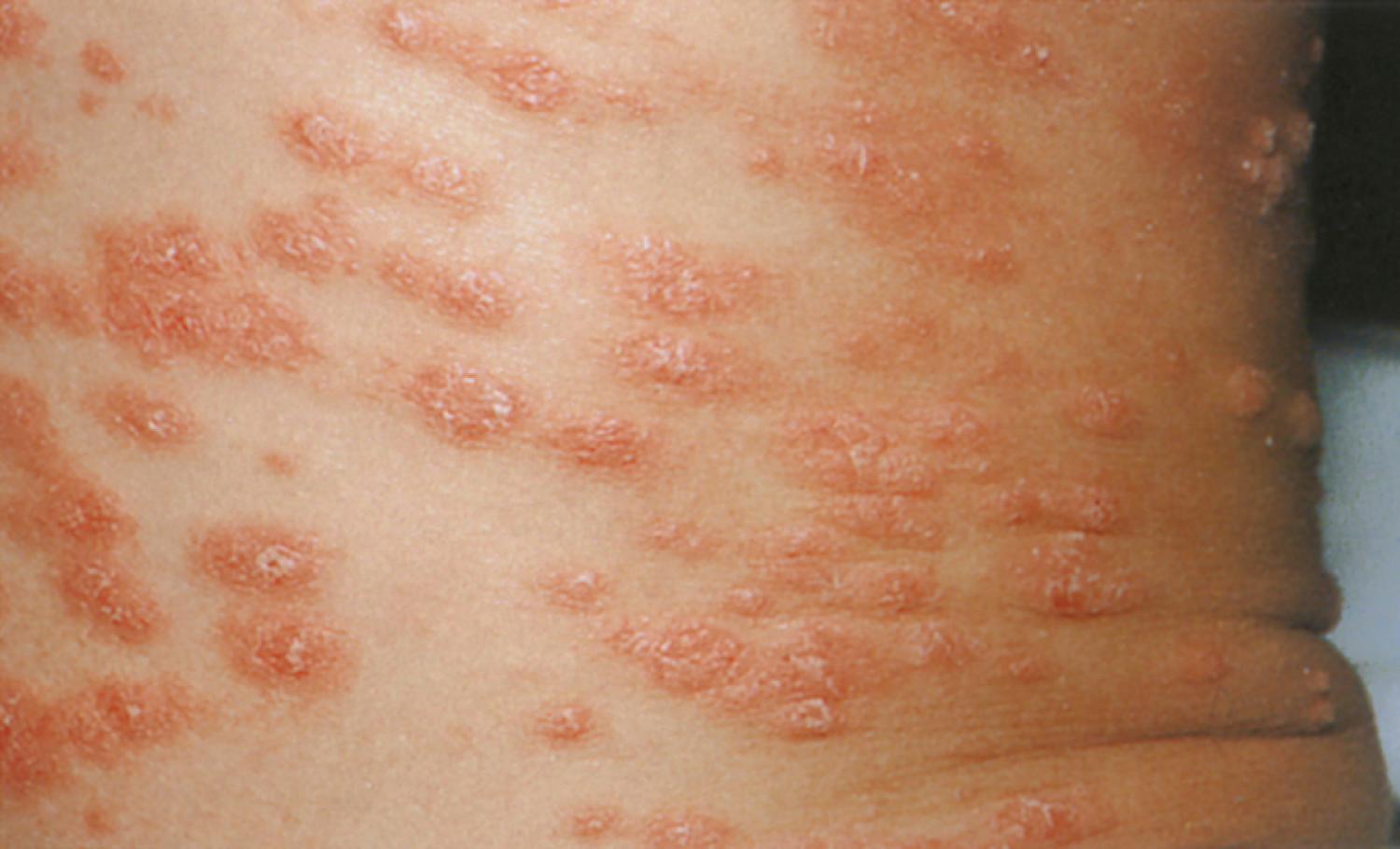
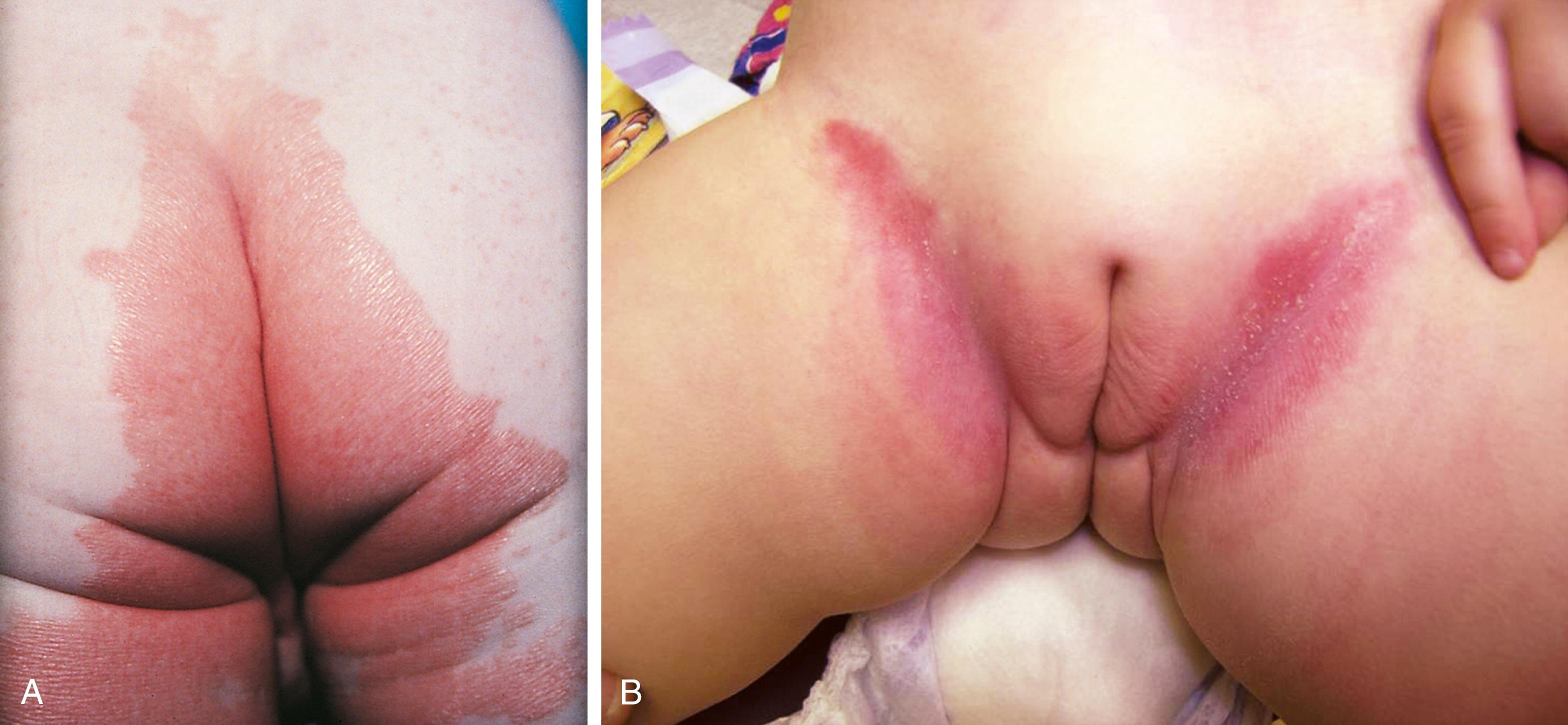

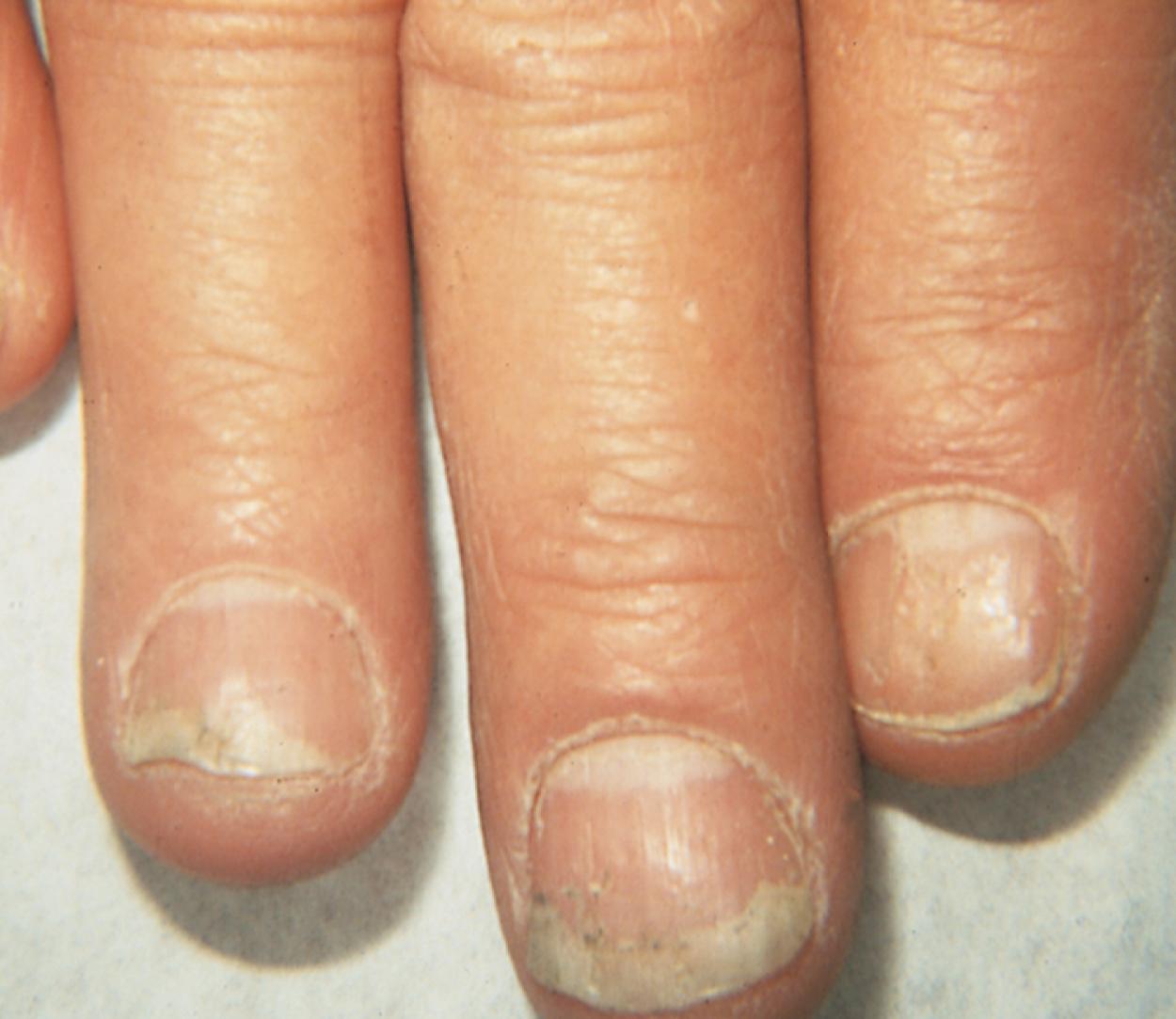
The factors that initiate the rapid turnover in epidermal cells that produce the psoriatic plaques are unknown, although an inherited predisposition is suspected and upper respiratory tract and streptococcal infections may precipitate lesions in children, especially in cases of guttate psoriasis. Although the increased epidermal growth causes a thickening of the skin in the psoriatic plaque, there are also areas between the epidermal ridges where the skin is thin and the scale is close to the subepidermal vessels. Thus, when the scale is removed, small bleeding points are often seen. This is called the Auspitz sign, and it is one of the hallmarks of psoriasis ( Fig. 8.6 ).

Except in cases of guttate psoriasis, which can sometimes be limited to one episode, the course of psoriasis tends to be more chronic and unpredictable, marked by remissions and exacerbations. Although it is less commonly seen than in their adult counterparts, children with psoriasis are also at risk for psoriatic arthritis, so a careful screening for joint symptoms is key. Of note, the severity and timing of psoriatic skin disease and joint disease do not always parallel one another, so even patients with mild or no skin disease may experience significant joint pain. Thirty-seven percent of adults with psoriasis first develop lesions in childhood.
Ichthyosis refers to a group of genodermatoses characterized by varying degrees of dry, scaly skin. Various types have been identified according to clinical course; histopathology; biochemical markers; and, in some cases, specific genetic mutations.
Ichthyosis vulgaris occurs secondary to a mutation in filaggrin, which encodes a key component of the epidermal barrier; it is transmitted as an autosomal dominant trait and affects approximately 0.5% of the population. Although the rash is not present at birth, by 3 months old excessively dry skin or thick, fishlike scales may be apparent on the shins and extensor surfaces of the arms ( Fig. 8.7 ). On occasion, scales become more generalized, involving the trunk, but the flexures are usually spared. Lesions tend to flare during the winter and improve during the summer, particularly with increasing age. Biopsy of involved skin shows retention hyperkeratosis and a thinned granular layer in the epidermis. Liberal use of topical emollients usually keeps pruritus and scaling under control.
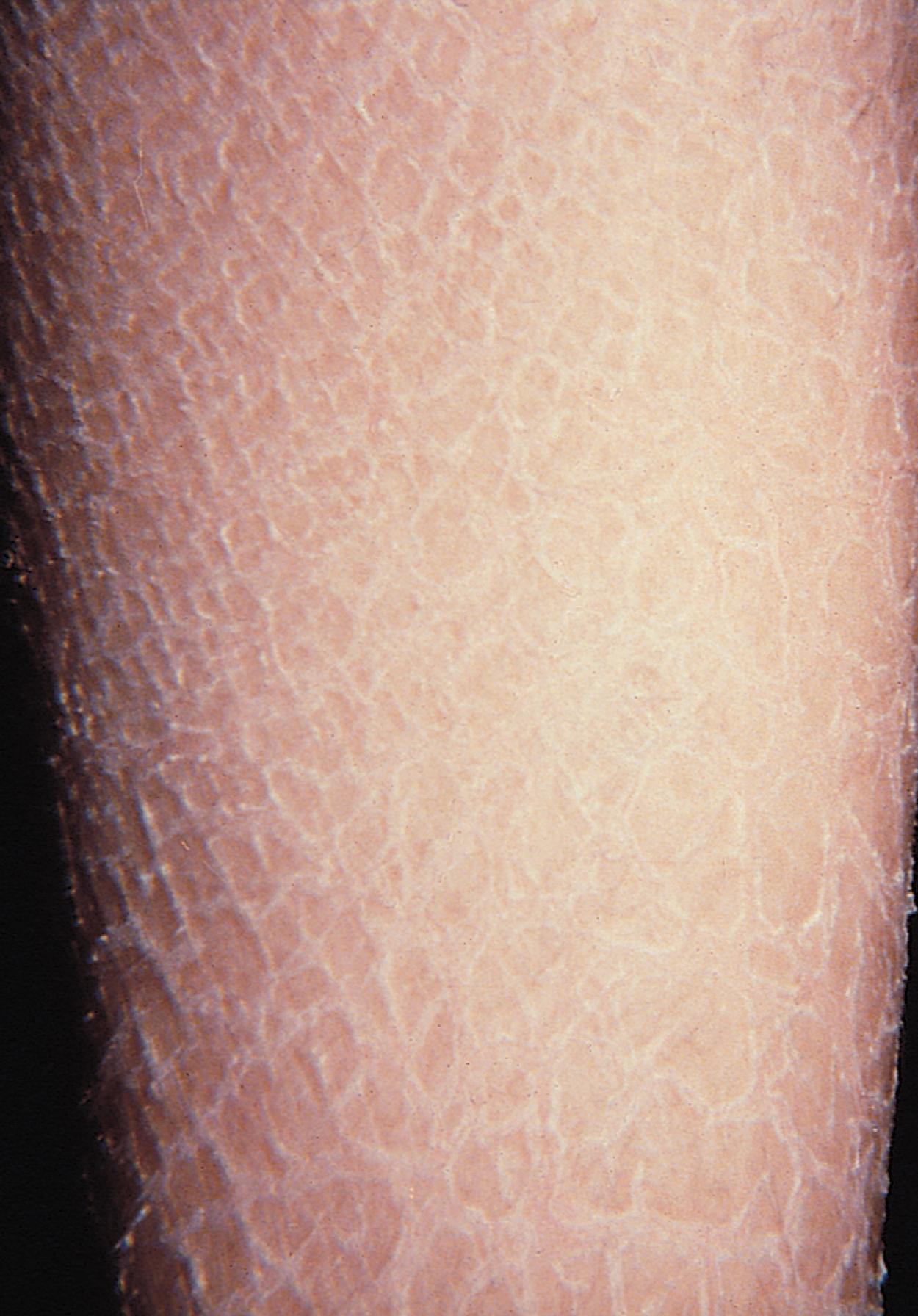
X-linked ichthyosis occurs in 1 in 6000 males as a result of a mutation in the enzyme steroid sulfatase, although findings are occasionally present in hemizygous female carriers. Affected newborns usually present between 3 and 12 months old with generalized “dirty” brown scales, particularly on the lateral neck, abdomen, back, and anterior legs and feet ( Fig. 8.8 ). The central face and flexures are spared. Skin biopsy demonstrates an increased granular layer and stratum corneum, and biochemical studies demonstrate decreased or absent steroid sulfatase in the serum and skin. Children with X-linked ichthyosis are at increased risk of undescended testes, as well as testicular cancer (even independent of this risk). Decreased or absent steroid sulfatase activity during fetal life may result in decreased placental estrogen and a delay in onset of maternal labor.
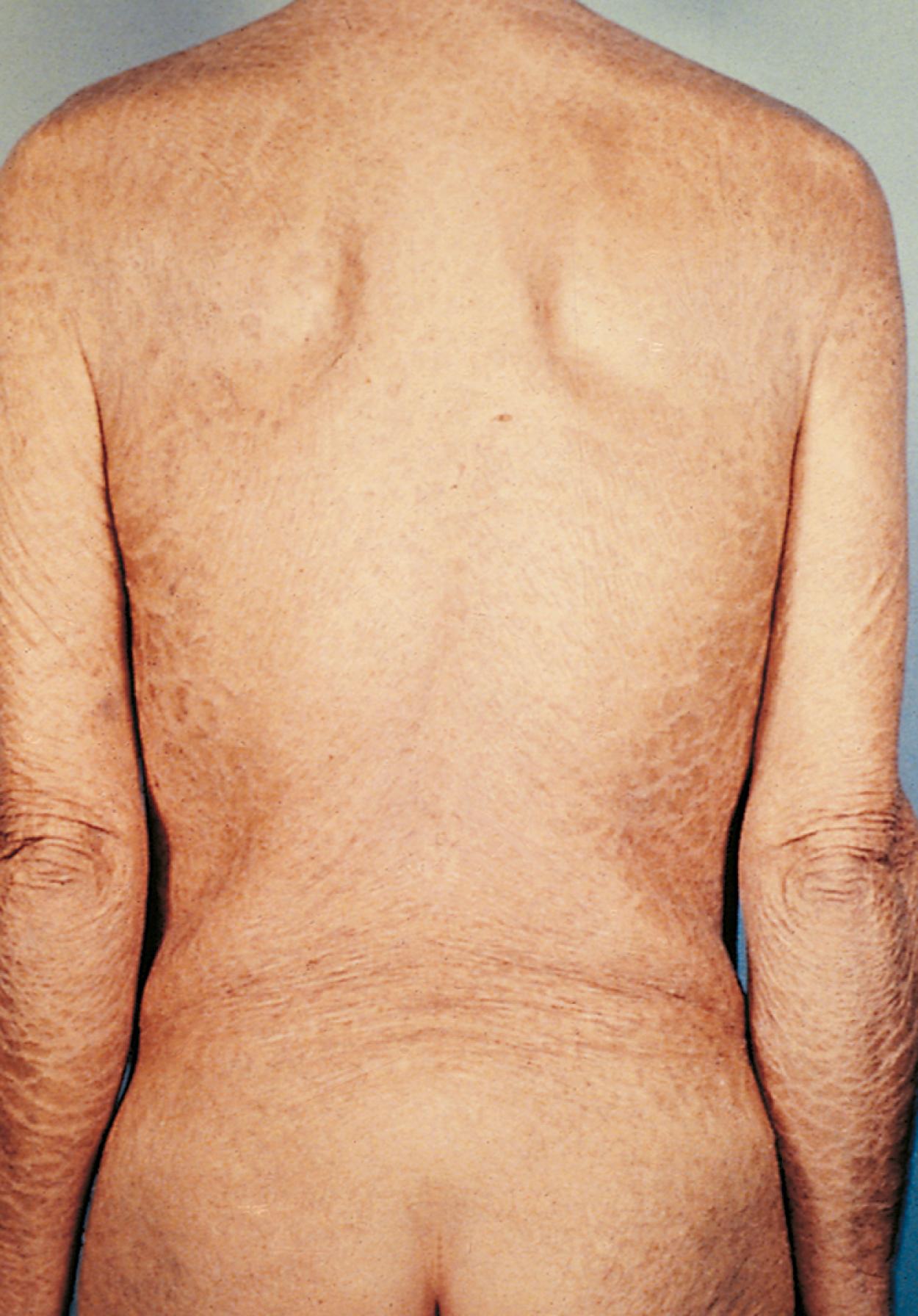
Lamellar ichthyosis is a rare autosomal dominant disorder occurring in fewer than 1 in 250,000 births as a result of a mutation in keratinocyte transglutaminase-1. Infants are usually born with a collodion membrane (see Fig. 8.96 ). During the first month of life, thick, brownish gray, sheet-like scales with raised edges appear. Scaling is prominent over the face, trunk, and extremities ( Fig. 8.9 ). In contrast to ichthyosis vulgaris, the flexural areas are involved (see Fig. 8.9B ). Eversion and fissuring of the eyelid margins (ectropion) and lips (eclabium) are common complications (see Fig. 8.9C ) and can lead to exposure keratitis, necessitating ophthalmologic consultation. The palms and soles show thick keratoderma with fissuring. Some improvement of the scaling occurs with age, and topical keratolytics (e.g., lactic acid and salicylic acid) may provide some benefit. Severe cases may respond to the administration of systemic retinoids, but it is important to note that these are known to be teratogenic and should be given only with careful monitoring by an experienced expert in ichthyosis and assurance of patient compliance with contraception.
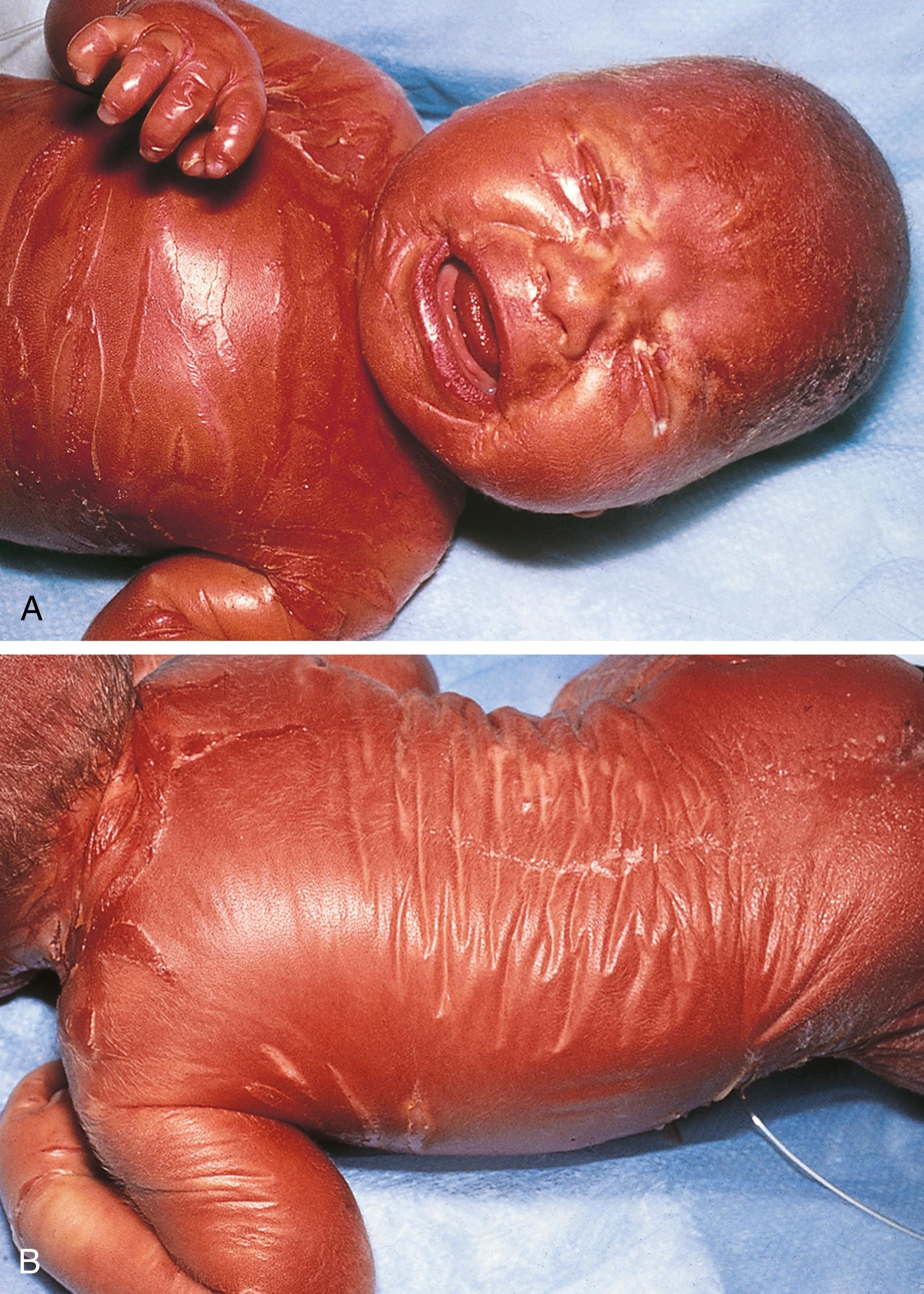

Epidermolytic hyperkeratosis is a rare autosomal dominant form of ichthyosis characterized by the development of generalized, thick, warty scales and intermittent blistering with severe involvement of the flexures ( Fig. 8.10 ). In newborns, blisters and erosions may be widespread and must be differentiated from epidermolysis bullosa (EB) or herpes simplex. Histologically, massive hyperkeratosis is associated with ballooning of squamous cells and formation of microvesicles. Epidermal turnover is also markedly increased. The mainstay of treatment includes use of keratolytics, lubricants, and antibiotics for secondary infection, which is common and usually caused by Staphylococcus aureus. Oral retinoids may also significantly decrease scaling.

Depending on duration of involvement, dermatitides can be characterized clinically by acute changes (including erythema, edema, and vesiculation) and/or chronic changes (e.g., scaling, lichenification, and dyspigmentation) in the skin. Microscopically, these disorders are characterized by infiltration of the dermis with inflammatory cells, edema, variable thickening of the epidermis, and scaling.
Atopic dermatitis is one of the most common and stressful of all chronic skin disorders in children. It is now known that mutations in filaggrin, in addition to causing ichthyosis vulgaris, cause the barrier dysfunction, which is characteristic of atopic dermatitis in approximately 50% of patients. Atopic dermatitis can be divided into three general phases on the basis of the age of the patient, but it is worth noting that these stages may overlap in any given patient.
The infantile phase of atopic dermatitis begins between birth and 6 months old and lasts approximately 2 or 3 years. Characteristically, the rash is manifest by erythematous, pruritic papules, and plaques that ooze and crust. Lesions are distributed over the cheeks, forehead, scalp, trunk, and extensor surfaces of the extremities and are typically symmetrically distributed ( Fig. 8.11 ). Many infants with atopic dermatitis have overlapping seborrheic dermatitis of the scalp and/or intertriginous areas, such as the neck folds. Several factors that were previously felt to have played a role in atopic dermatitis, including exclusive breastfeeding, the delayed introduction of solid foods, and the use of probiotics and/or fish oils each have been found to have no statistically significant effect on its development.
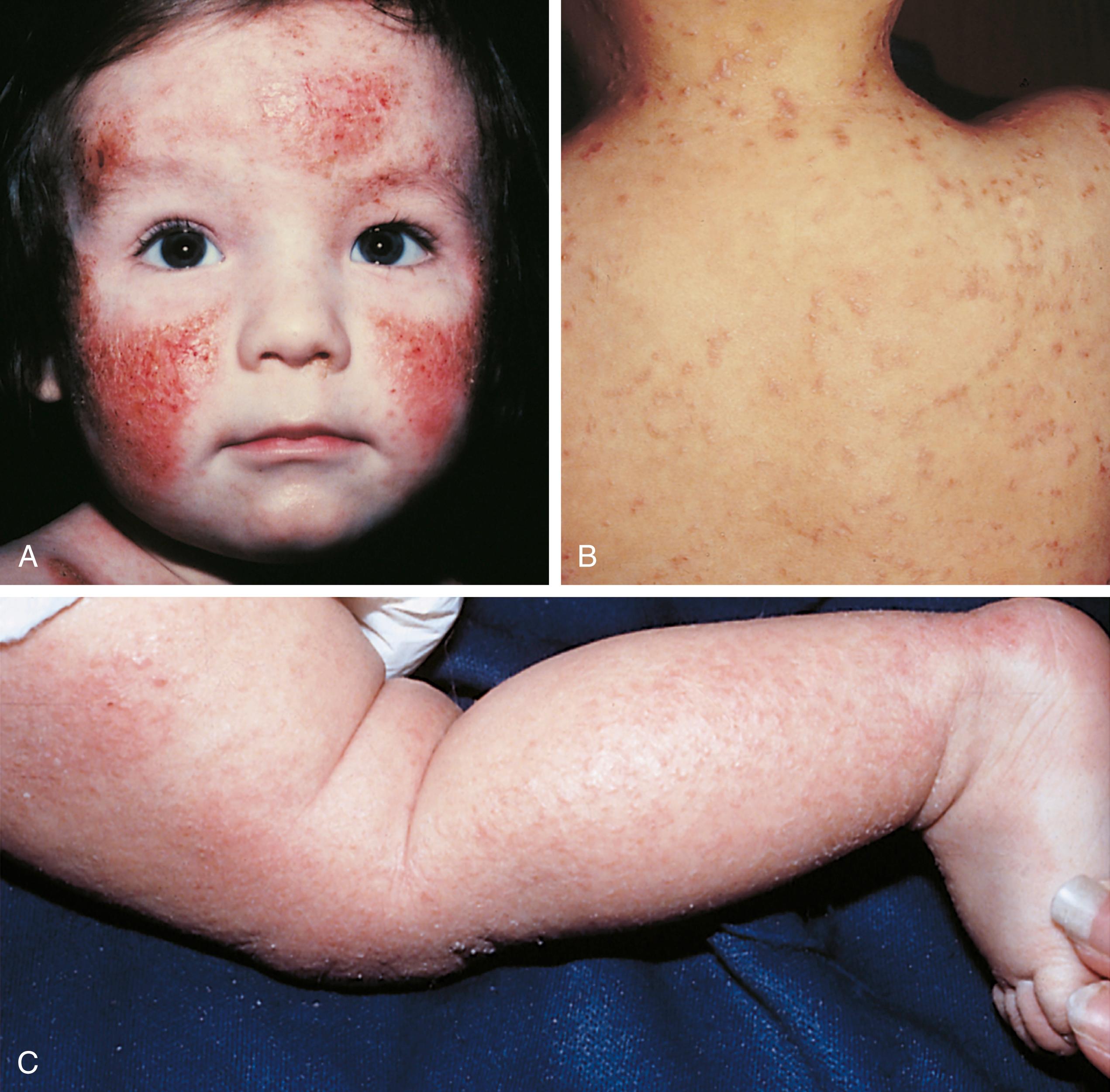
The childhood phase of atopic dermatitis occurs between ages 4 and 10 years old. The skin lesions are typically dry, papular, and intensely pruritic. Circumscribed scaly patches are distributed on the wrists, ankles, and antecubital and popliteal fossae ( Fig. 8.12 ); these patches frequently become secondarily infected, both as a result of the nonintact skin barrier, as well as from discrete immunologic differences in children with atopic dermatitis, namely a deficiency in two innate antiviral and antibacterial arms of the skin’s immune system: β-defensins and cathelicidins. More chronic areas can show lichenification. Cracking, dryness, and scaling of the palmar and plantar surfaces of the hands and feet are also common ( Fig. 8.13 ). The chronic pruritus and sleep disturbance associated with many cases of childhood atopic dermatitis may help to explain the finding that children with atopic dermatitis are more likely to have attention-deficit/hyperactivity disorder (ADHD). It also underscores the importance of comprehensively treating these patients not just for their visible skin findings but also for their systemic and behavioral comorbidities. Remission may occur at any time, or the disorder may evolve into a more chronic type of adult dermatitis. Of children with atopic dermatitis, 75% improve between the ages of 10 and 14; the remaining children may go on to develop chronic dermatitis.
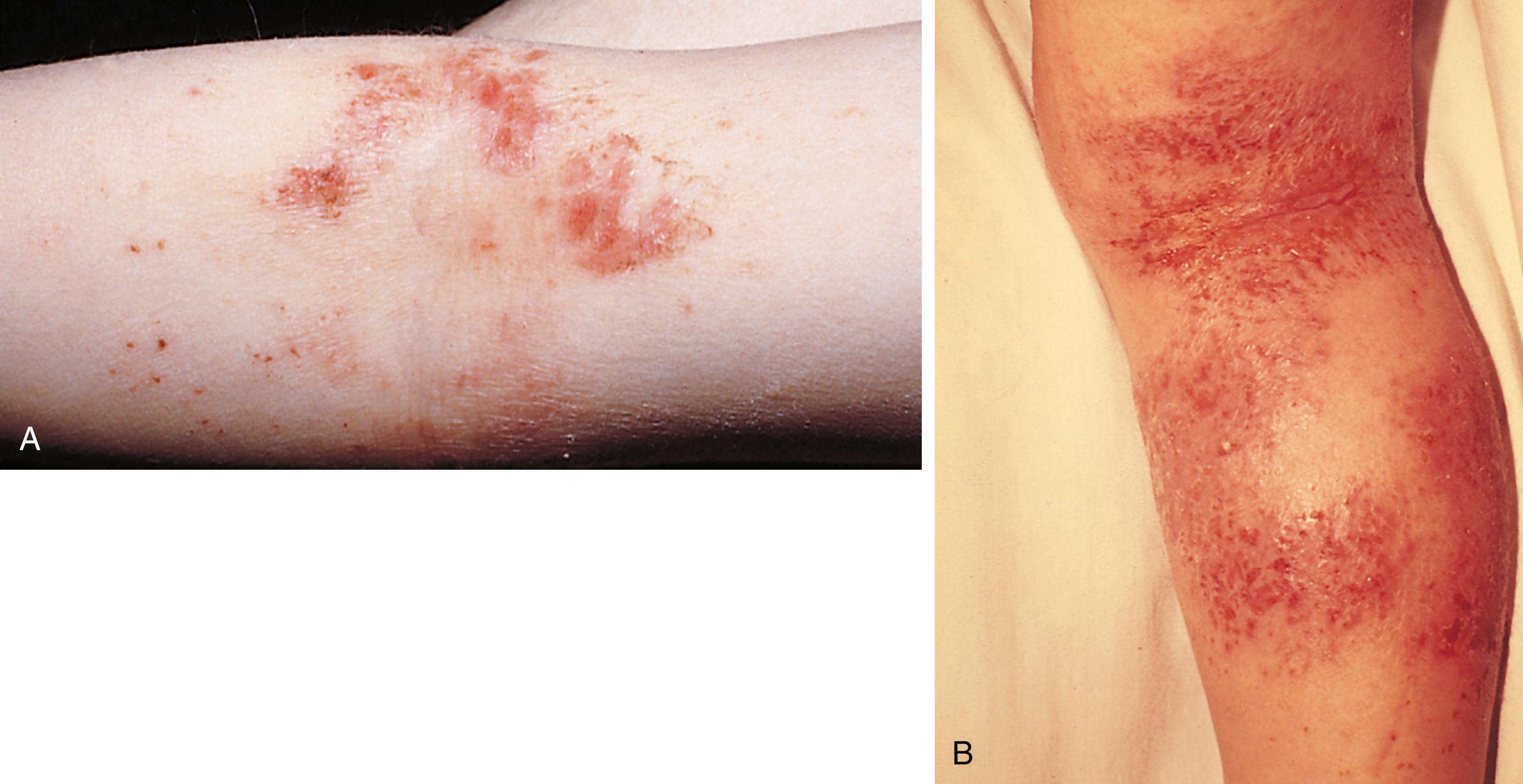

The adult phase of atopic dermatitis begins around age 12 and continues indefinitely. Major areas of involvement include the flexural areas of the arms, neck, and legs ( Fig. 8.14 ). Eruptions are sometimes seen on the dorsal surfaces of the hands and feet and between the fingers and toes. Lichenification may be marked ( Fig. 8.15 ).

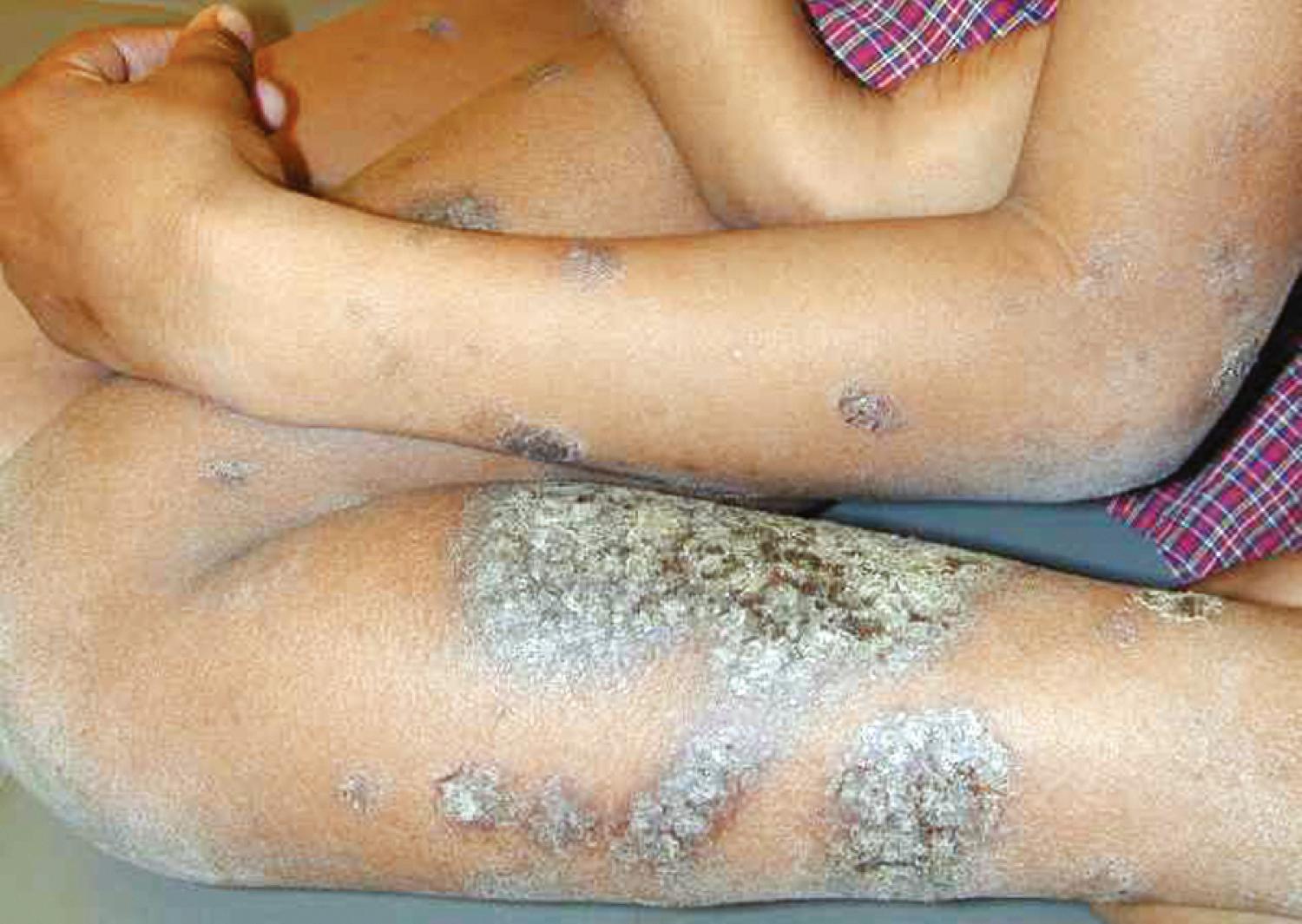
Other associated findings include xerosis (dryness); ichthyosis vulgaris (see Fig. 8.7 ); keratosis pilaris, keratin plugging of hair follicles and formation of perifollicular scales over the extensor surfaces of the extremities and sometimes the trunk and abdomen ( Fig. 8.16 ; and see also Fig. 8.25D ); hyperlinearity of the palms; Dennie-Morgan lines (double skin creases under the lower eyelid [see Chapter 4 ]); and both hyperpigmentation and hypopigmentation, which may be marked and at times may be the predominant findings. As a result of their altered immunity in the skin, more than 90% of patients with atopic dermatitis are colonized with S. aureus at the time of a flare; for the same cellular reason, these patients are also unusually susceptible to cutaneous viral infections, including warts, herpes simplex, and molluscum contagiosum. Patients with eczema should be warned to avoid direct contact with individuals who have cold sores, because they are at great risk for developing eczema herpeticum (see Chapter 13 ). Parents of children with eczema who themselves have recurrent herpes simplex lesions should be taught hygienic techniques that reduce the risk of transmitting the virus, even when asymptomatic, because shedding can still occur to their children. Consideration can be given to daily suppressive therapy for parents of children with severe atopic dermatitis.
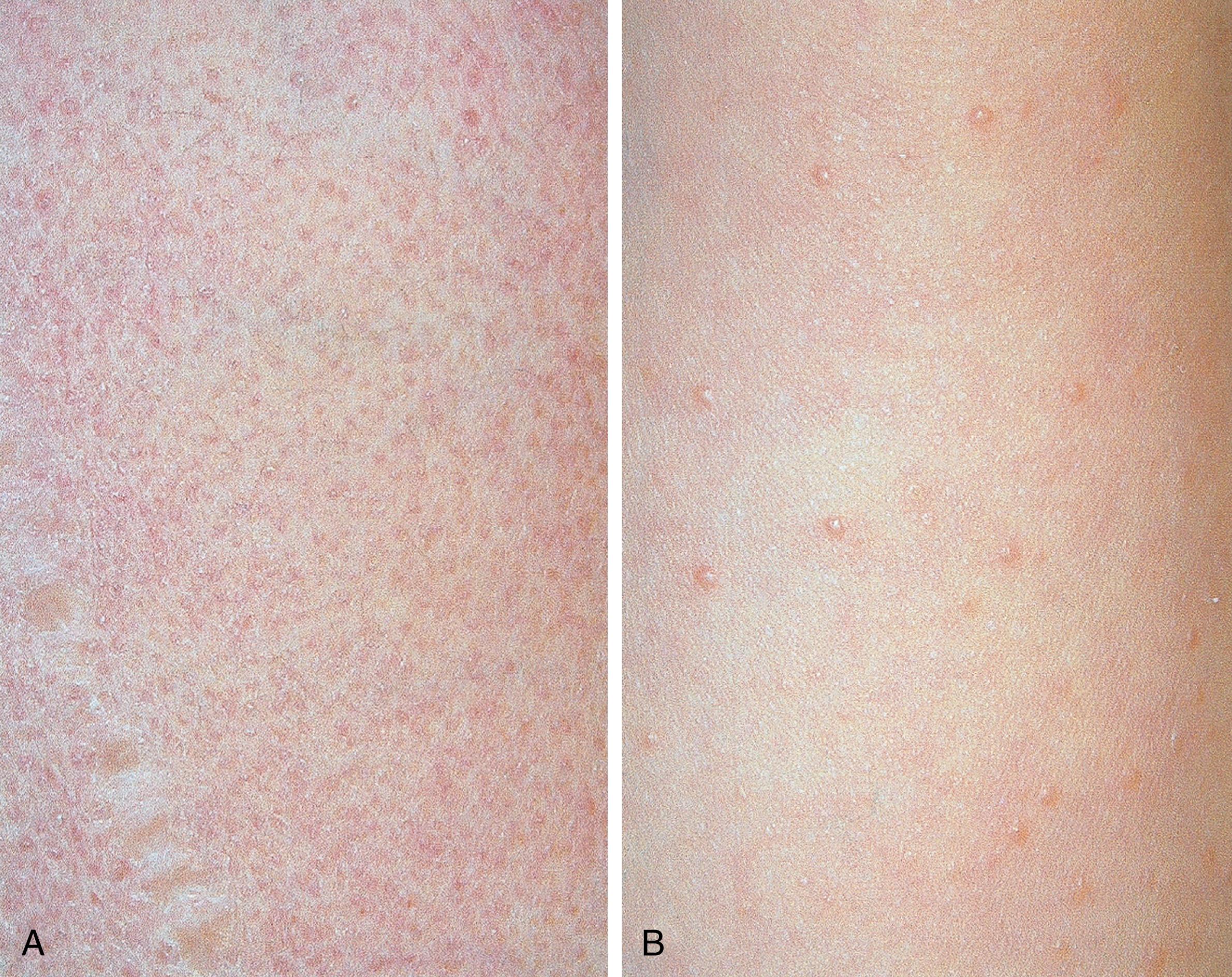
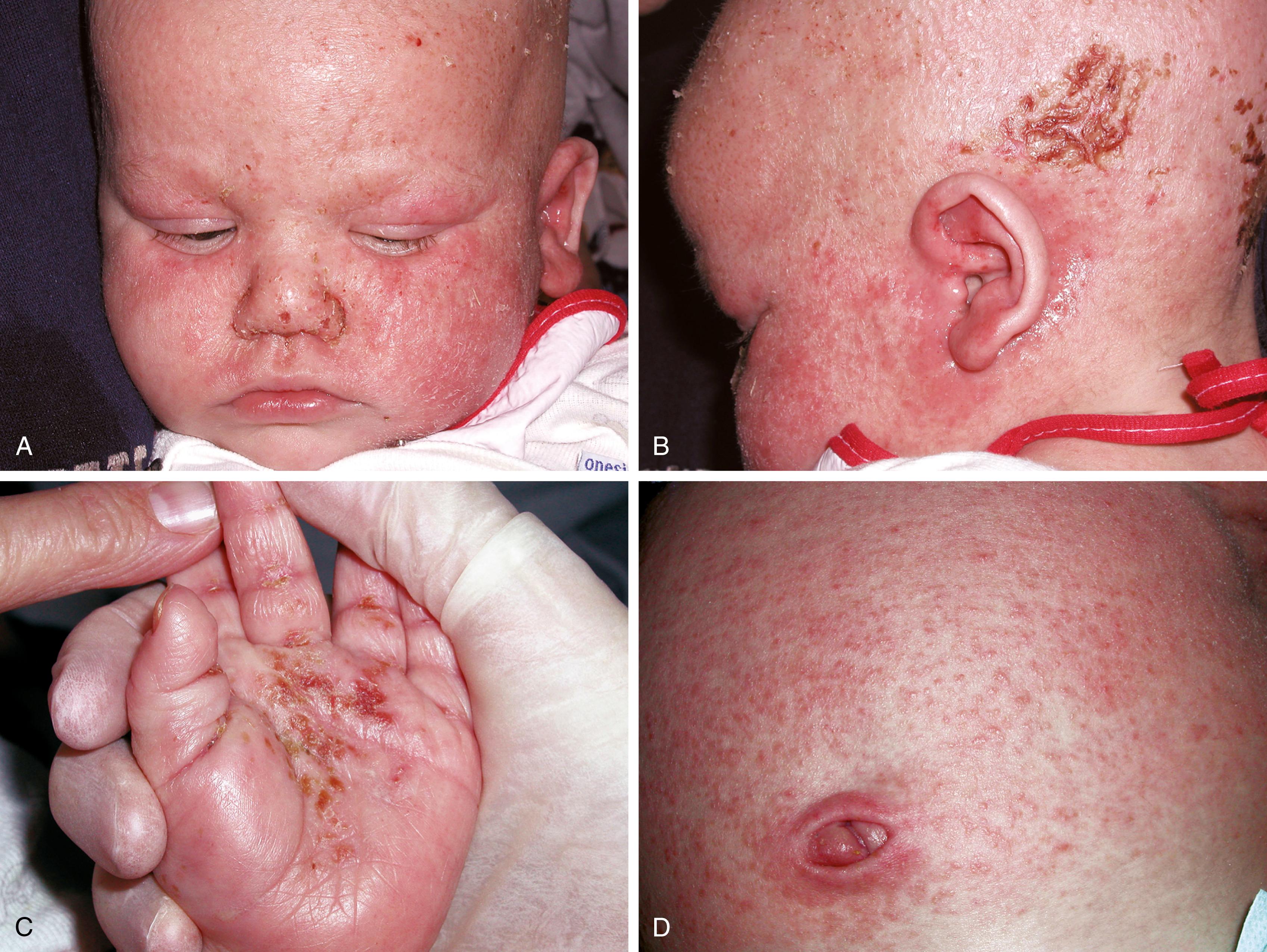
In the rash of pityriasis alba, which is common in patients with atopic dermatitis, inflammatory changes are minimal. Poorly defined, hypopigmented, round or oval scaly patches measuring 2 to 4 cm in diameter are noted most commonly on the face and extremities ( Fig. 8.17 ), although they may involve the trunk as well. These patches fail to enhance with Wood lamp examination, which distinguishes them from vitiligo. Lesions are more prominent in children with dark skin and are more noticeable during spring and summer because they do not tan like surrounding skin after sun exposure. Surface scaling is more evident when the skin is dry (especially in winter). The etiology is unknown, but it is clearly more common in children with an atopic diathesis. Because the disorder is usually asymptomatic and spontaneously resolves in several months to a few years, treatment is usually unnecessary, although moisturizers may help reduce surface scaling. Often parents are most concerned cosmetically with the hypopigmentation; so if the condition does not resolve with emollients alone, then it can be helpful to add a prescription topical immunomodulatory, such as pimecrolimus cream or tacrolimus ointment.
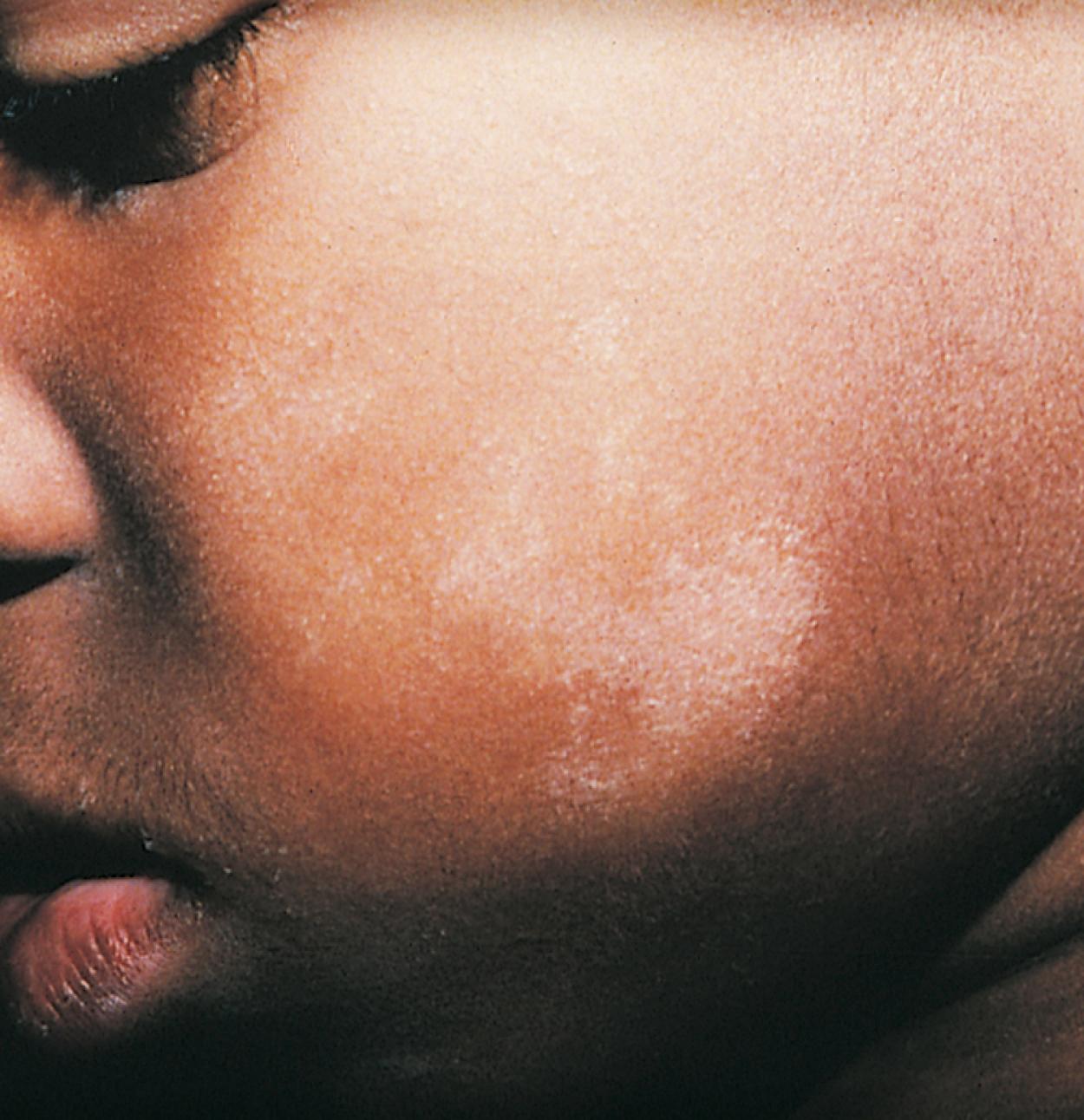
The cause of atopic dermatitis remains elusive. An immunologic etiology is suggested by the chronic elevation of immunoglobulin E (IgE) seen in a majority of patients. Atopic dermatitis does occur in families in association with other atopic conditions in the atopic triad, including asthma, allergic rhinitis, and food allergies, as well as eosinophilic esophagitis, suggesting some degree of genetic predisposition. Pathophysiologically, a number of external factors including dry skin, fragranced skin care products, wool fabrics, foods, infectious agents, and environmental antigens may act individually or in concert to produce pruritus, which is almost universal in atopic individuals. The resultant scratching leads to the acute and chronic changes typical of atopic dermatitis.
The differential diagnosis of atopic dermatitis includes seborrheic dermatitis, contact dermatitis, pityriasis rosea, psoriasis, fungal infections, Langerhans cell histiocytosis, and acrodermatitis enteropathica. It can be distinguished from seborrheic dermatitis on the basis of the distribution of lesions and associated pruritus; atopic dermatitis tends to spare moist, intertriginous areas (such as the axillae and perineum), where seborrheic dermatitis is more prominent in these locations. Exposure history and distribution help differentiate it from contact dermatitis, as does the discreteness of lesions and their distribution in pityriasis rosea. The thick, silvery scale and Koebner phenomenon help distinguish psoriasis, and central clearing with an active border of red papules, vesicles, and/or pustules helps differentiate tinea corporis. The rash of histiocytosis is crusted and atrophic and may favor the groin or scalp, or it may be more generalized. It is associated with petechiae and is often accompanied by chronically draining ears, hepatosplenomegaly, and lymphadenopathy (see Fig. 8.88 and Chapter 12 ). The acral and periorificial distribution of lesions and gastrointestinal symptoms help in distinguishing eczema from acrodermatitis enteropathica.
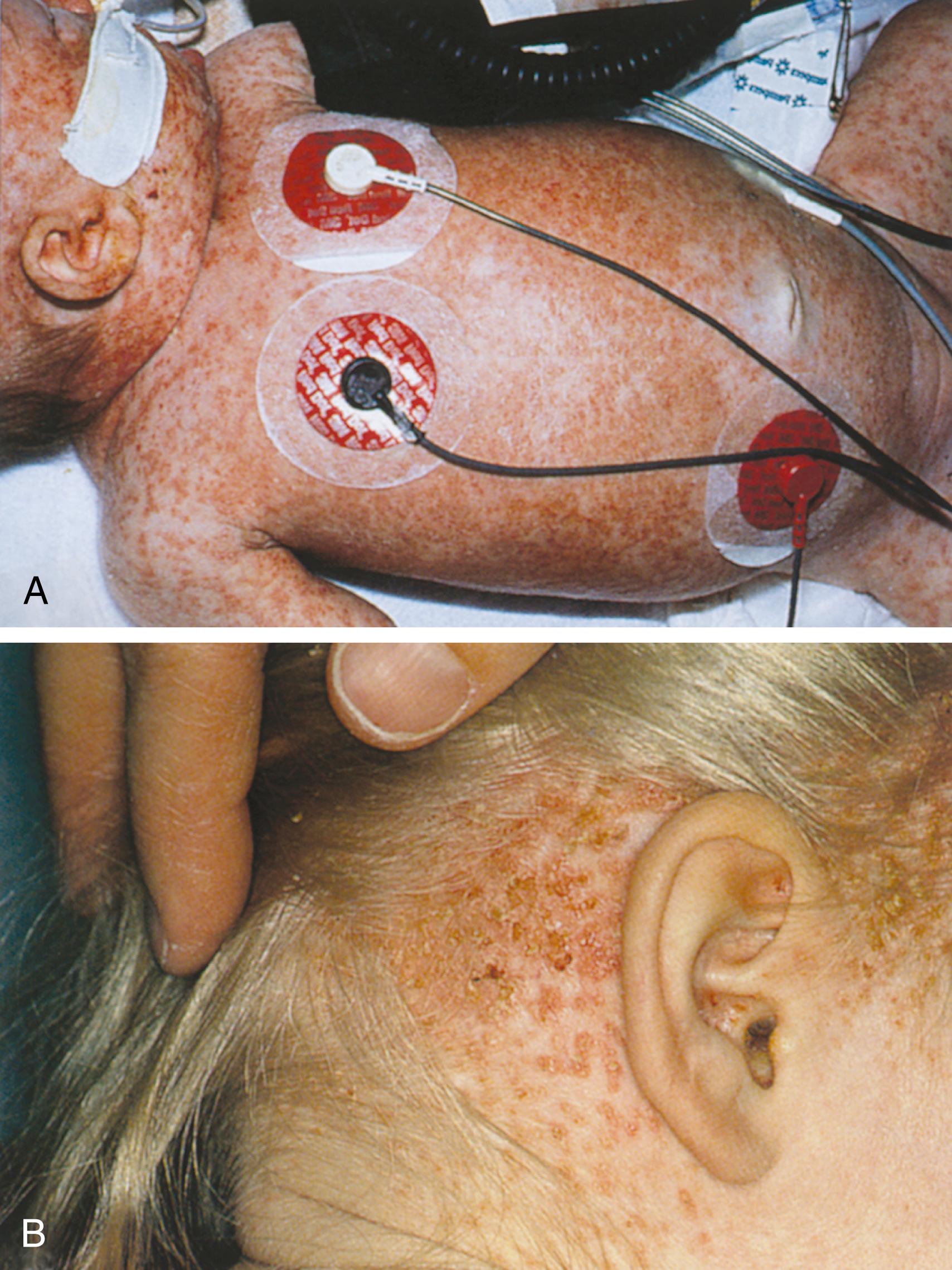
The mainstays of atopic dermatitis treatment are elimination or avoidance of predisposing factors; hydration and lubrication of the skin; the use of antipruritic agents to relieve itching, break the itch/scratch cycle, and normalize sleep patterns; and the intermittent use of topical steroids to further relieve itching and decrease inflammation. Pimecrolimus cream and tacrolimus ointment are two agents in the class of nonsteroidal topical immunomodulators that may also dramatically interrupt the itch/scratch cycle. They have been approved as second-line therapy for the management of atopic dermatitis in children older than 2 years. Use of these agents should be accompanied by an explanation of the boxed warning regarding the theoretical risk of lymphoma and skin cancer. However, these tumors have been seen only with prolonged systemic use at very high doses, and true risk has not been associated with the use of the topical preparations in otherwise healthy children.
All children with atopic dermatitis should be monitored closely for secondary bacterial infection, which must be treated promptly with topical or systemic antibiotics to prevent progression to cellulitis. The use of a hyperdiluted bleach (1 to 2 ounces in a 30-gallon tub of water) bath several times per week is a cost-effective way of preventing infection in patients with atopic dermatitis. Herpes simplex can also occur as a secondary infection over atopic dermatitis and can rapidly disseminate in patients with active atopic dermatitis, resulting in the severe disorder known as eczema herpeticum (see Chapter 13 ). Hence patients’ families should be warned to have their children avoid direct contact with people with cold sores, and if parents have recurrent herpes labialis, they should be instructed in strict handwashing precautions. Furthermore, patients should be treated with antiviral agents at the first sign of infection with herpes simplex.
Dyshidrotic eczema and nummular eczema are clinical patterns of atopic dermatitis, and juvenile palmoplantar dermatosis and lip-licking and thumb-sucking eczema represent irritant dermatitides that may be associated with atopic dermatitis.
Dyshidrotic eczema is a severely pruritic, chronic, recurrent, vesicular eruption affecting the palms, soles, and lateral aspects of the fingers and toes. Characteristically, the vesicles are symmetric, multilocular, and 1 to 3 mm in diameter and have been described as “tapioca” papules, likening them to the lumps in tapioca pudding. These lesions rupture, leaving scales and crust on an erythematous base ( Fig. 8.18 ). Pathologically, this eruption demonstrates spongiotic vesicles and normal eccrine sweat glands. The cause is unknown; however, frequent exposure to water, wet or sweat-soaked shoes, or chemicals (on the hands) may trigger or exacerbate the condition. Hyperhidrosis, or excessive sweating of the palms and soles, may also play a role. Treatment is similar to that for acute atopic dermatitis, although often a higher potency topical steroid may be needed to abort the flare of dyshidrotic eczema.
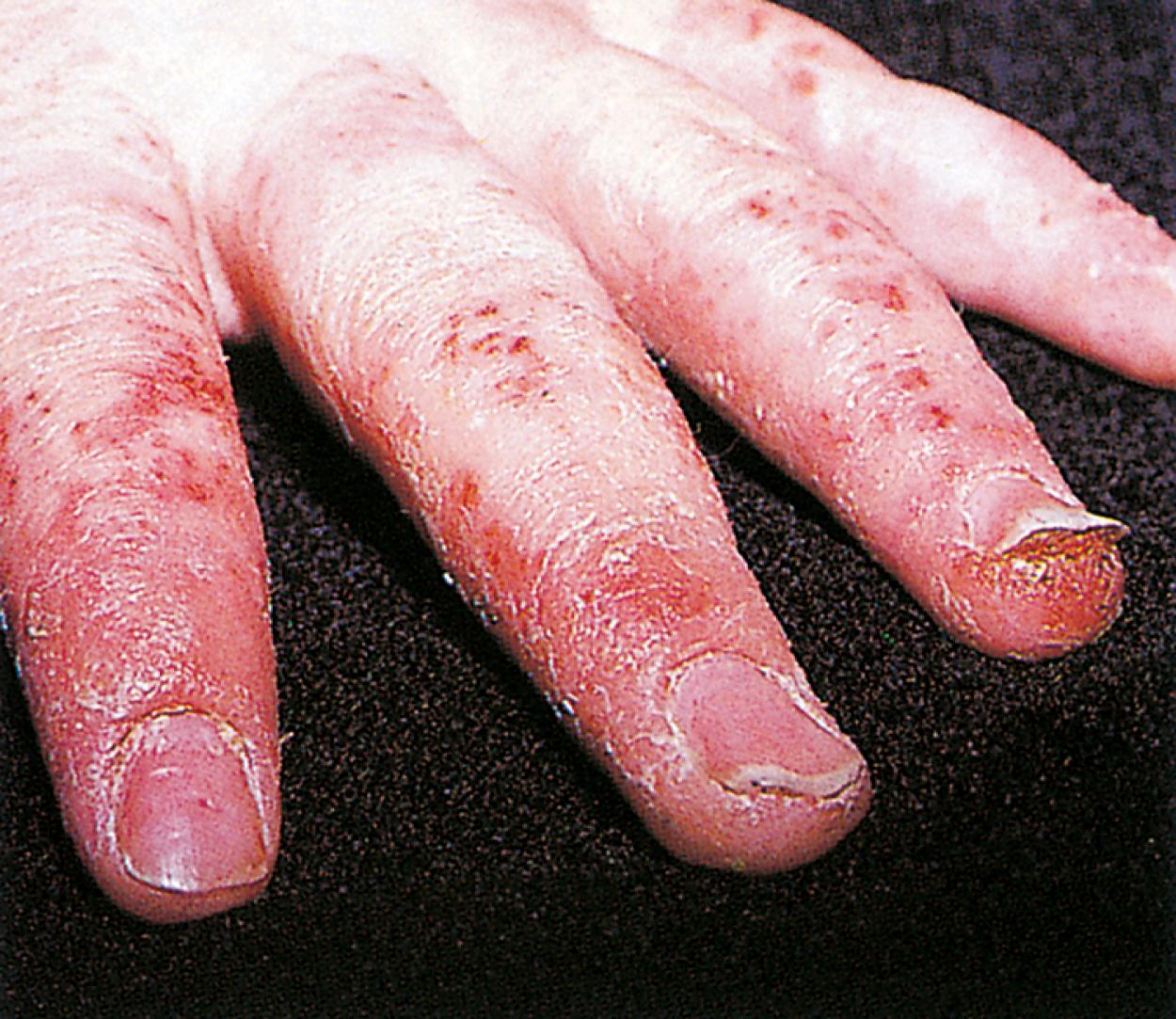
Nummular eczema is an acute papulovesicular eruption named for its annular or coin-shaped configuration and probably also represents another clinical pattern found in atopic individuals. Lesions are intensely pruritic, fairly well-circumscribed, round to oval, red, scaly patches studded with 1- to 3-mm vesicles ( Fig. 8.19A ). They are usually located on the extensor thighs or abdomen of children who also may have atopic dermatitis. Vigorous scratching causes excoriation and crusting (see Fig. 8.19B ). Lack of central clearing helps to distinguish these lesions from tinea corporis (see Fig. 8.36 ). Although the rash is often resistant to therapy, it may respond to the treatment for acute dermatitis outlined previously.
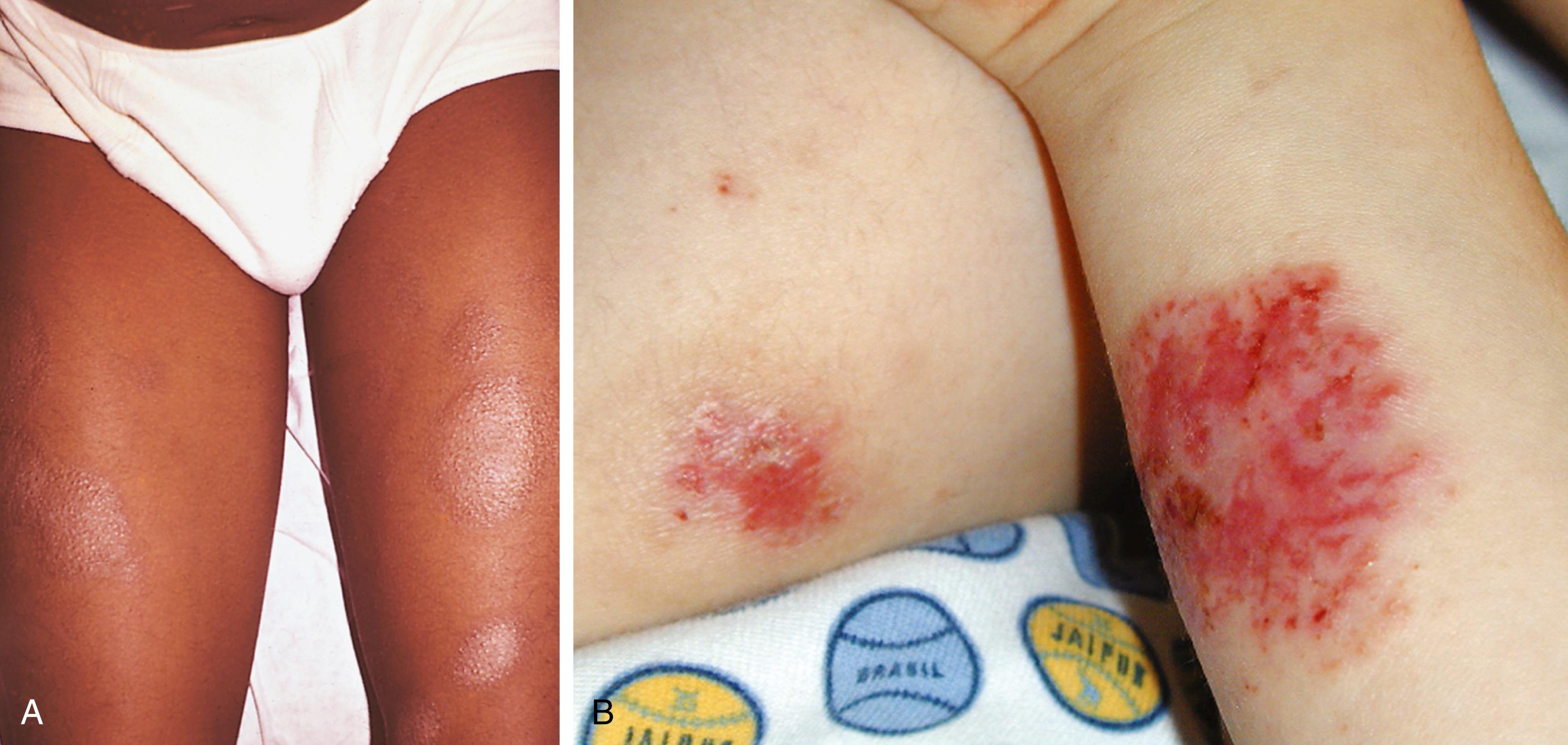

Juvenile plantar/palmar dermatosis (“sweaty sock syndrome”) is common in toddlers and school-age children. Chronic, red scaly patches with cracking and fissuring typically begin on the balls of the feet and big toes ( Fig. 8.20 ). The pads of the fingertips and palms may be involved as well, although less severely. Although the cause is unknown, the condition is triggered by excessive sweating and/or repeated wetting of the skin inside the child’s shoes (especially those made of synthetic materials that do not breathe), followed by drying or evaporation of the moisture, which leads to a net dehydration of the skin. Some children experience flares in the summer, whereas in others the flares occur in winter. Consequently, the mainstay of treatment consists of emollients for prevention and occasional application of topical steroids when intense inflammation is present during flares.
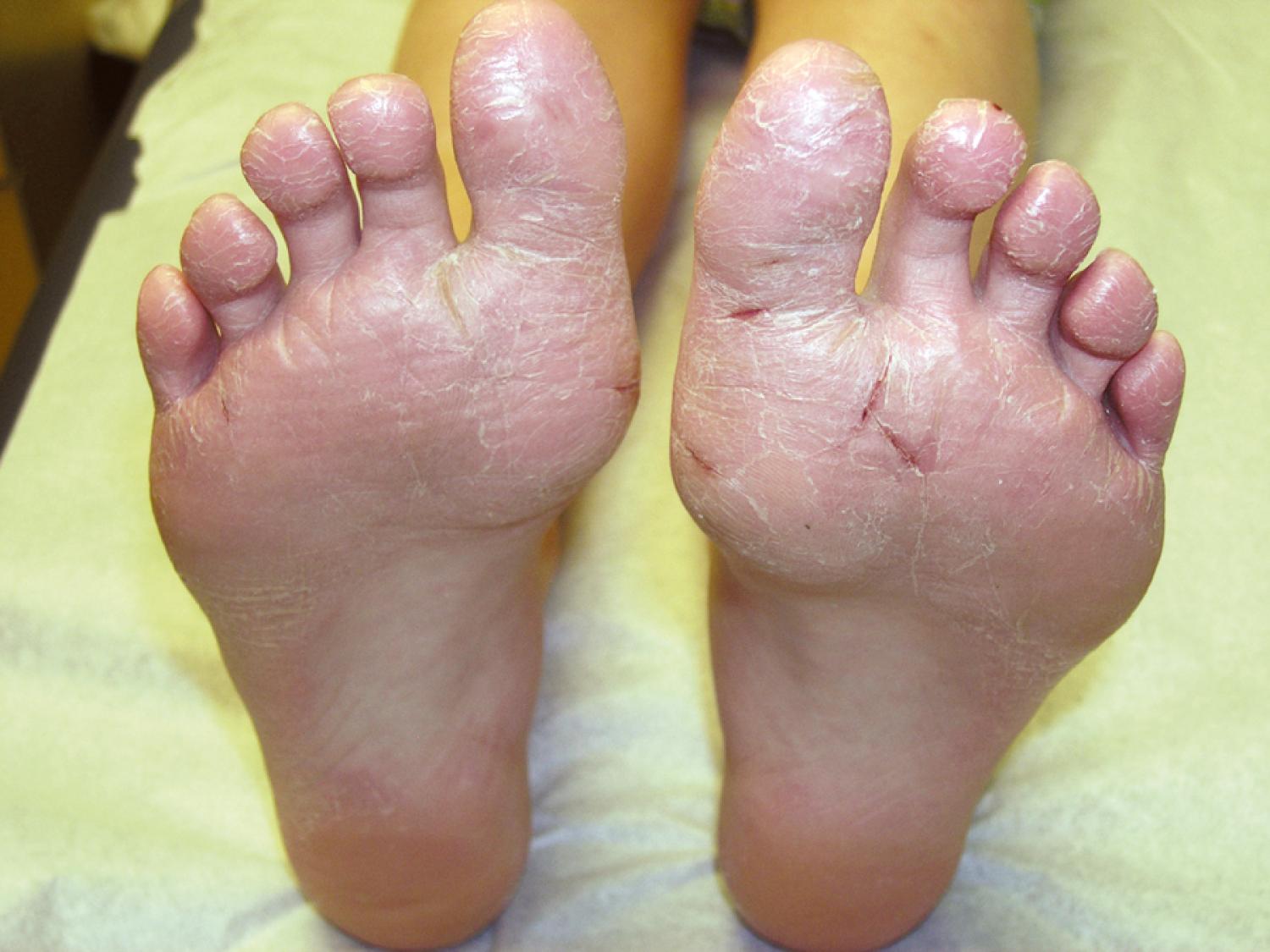
The repeated wetting and drying from persistent lip licking (especially in winter) or thumb sucking can produce eczematoid changes of the perioral skin ( Fig. 8.21 ) or the skin of the involved thumb ( Fig. 8.22 ). Lip-licking eczema can be the result of a habit or can be a manifestation of anxiety, and sources of stress should be explored on history taking. Once the process begins, it can become a vicious cycle as the child licks with increasing frequency to moisten the dry skin.
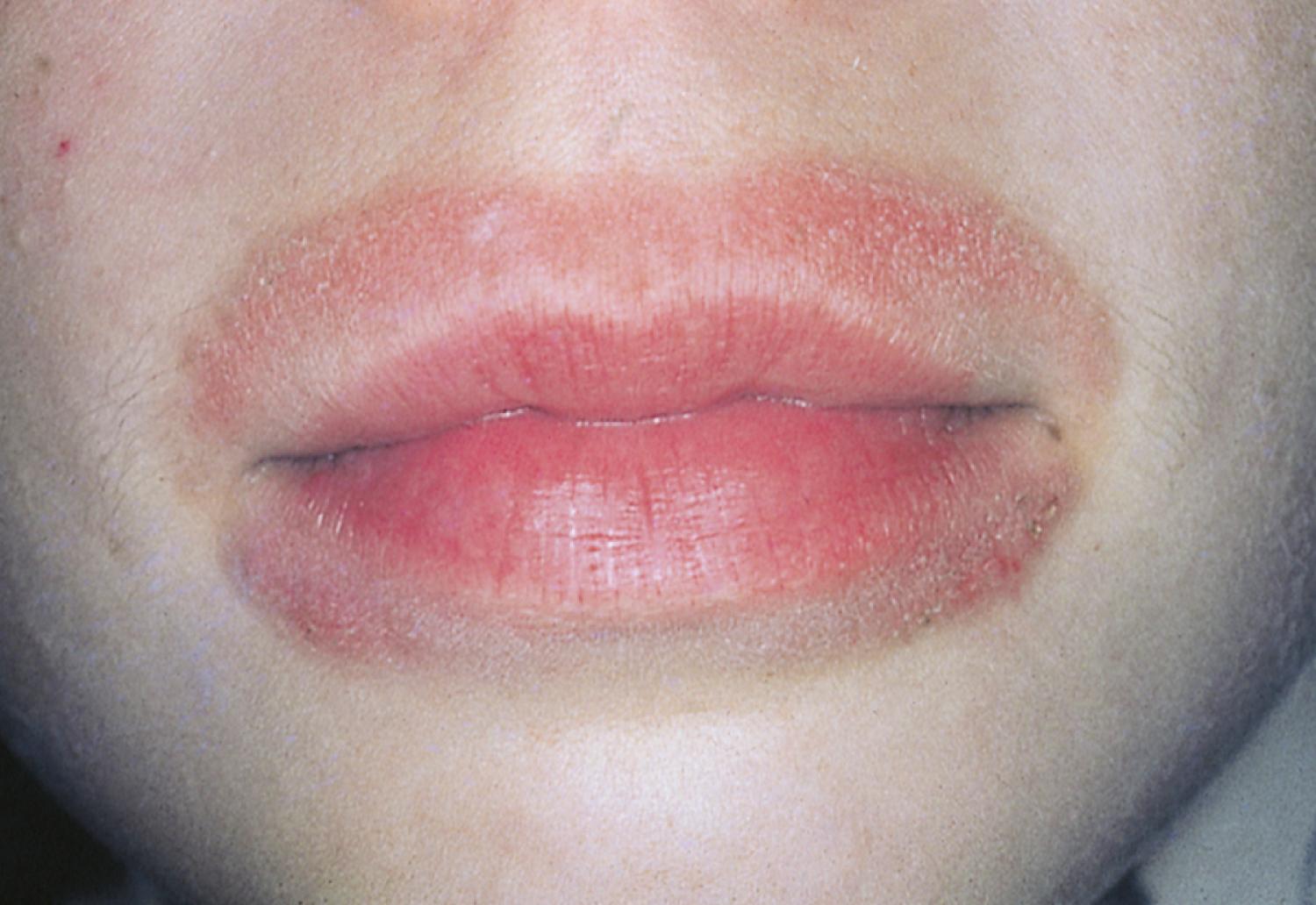
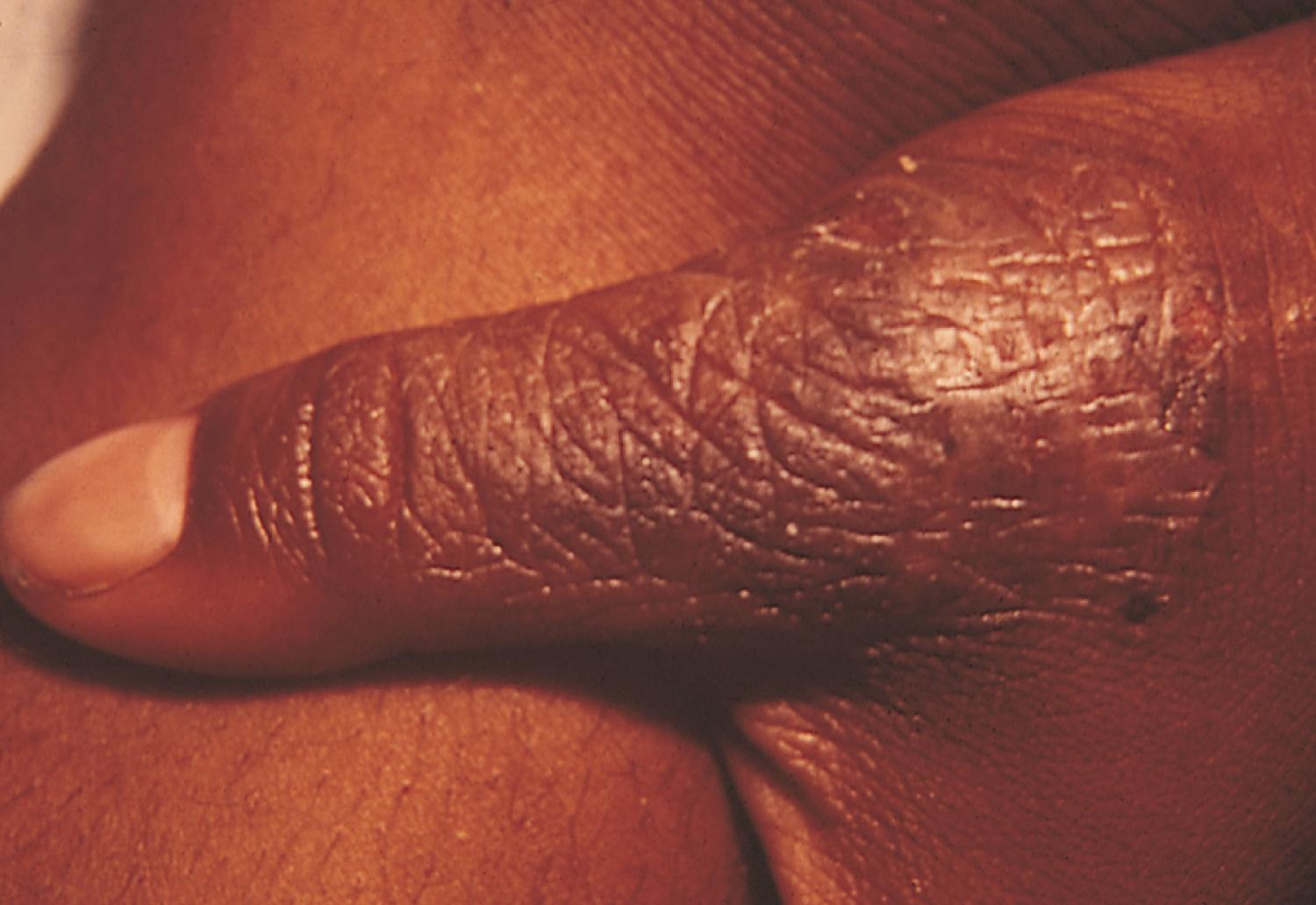
Seborrheic dermatitis is characterized by erythema and scaling predominantly on hair-bearing and intertriginous areas, such as the scalp; eyebrows; eyelashes; perinasal, presternal, and, postauricular areas; and the neck, axillae, and groin. Lesions often involve the intertriginous areas of the arms, legs, neck, and trunk and occasionally become generalized ( Fig. 8.23 ). In affected infants, scalp lesions consist of a thick, tenacious, scaly dermatitis that is often salmon colored and is commonly known as cradle cap ( Fig. 8.24 ). In adolescents, the dermatitis may manifest as dandruff or flaking of the eyebrows, postauricular areas, or flexural areas.
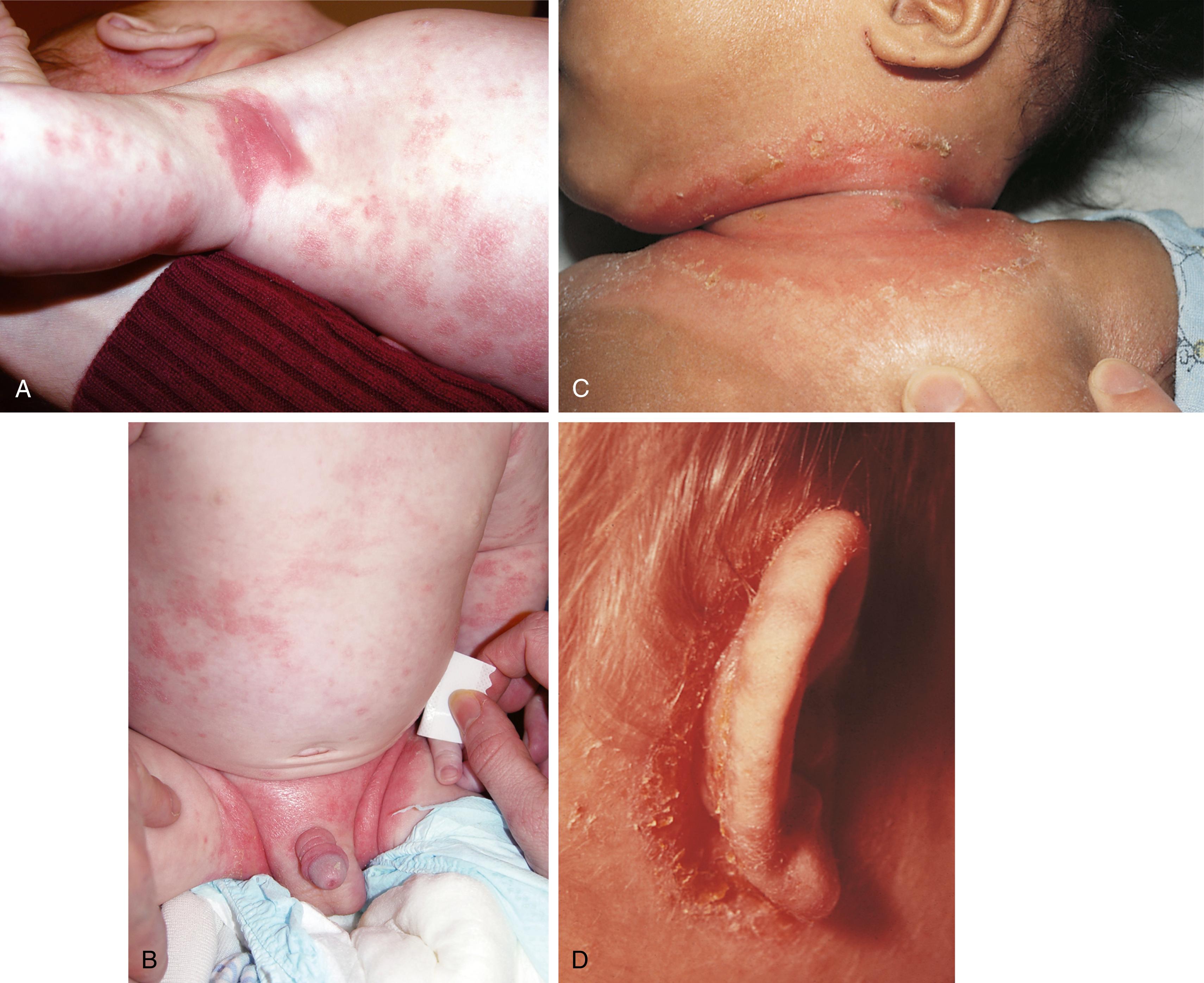
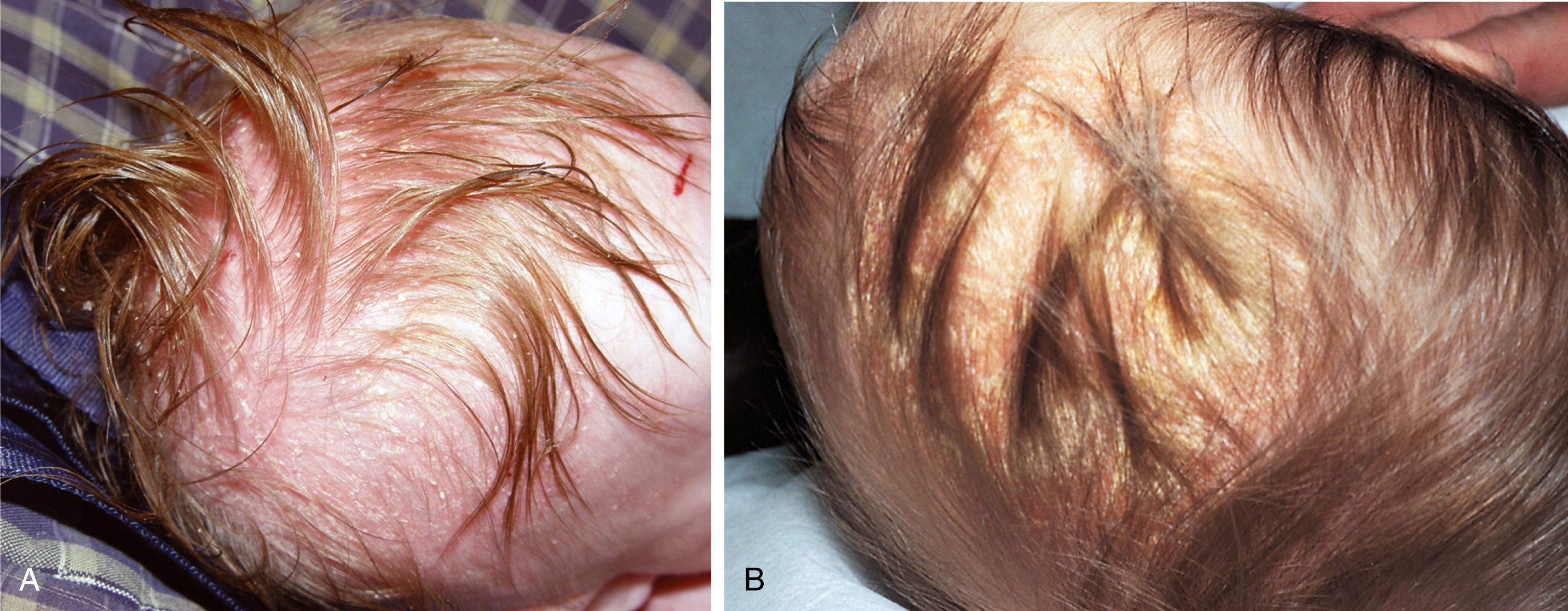
Although the pathogenesis of seborrheic dermatitis is unknown, Pityrosporum and Candida species have been implicated as causative agents. A role for neurologic dysfunction is suggested by the increased incidence and severity in neurologically impaired individuals.
The dermatitis of seborrhea is usually nonpruritic and mild in nature. Most cases respond to topical steroids, and many clear spontaneously, although residual postinflammatory hypopigmentation may persist for weeks or months thereafter (see Fig. 8.117 ). Some practitioners find that use of a topical antifungal cream or wash, in addition to a low-potency topical steroid, hastens resolution, but the topical steroid should not be part of long-term management. In infants and young children, atopic dermatitis can have a greasy, scaly appearance and can have overlapping features with seborrhea. However, infantile atopic dermatitis produces intense pruritus and invariably spares moist sites, such as the diaper area and axillae. The two are often present simultaneously in the same patient. The differential diagnosis of seborrhea includes Langerhans cell histiocytosis (in which the rash is more generalized, in part petechial, and can be associated with chronic draining ears and hepatosplenomegaly) and tinea corporis (in which lesions usually are more circumscribed, with an active border and central clearing). Scalp lesions may be difficult to differentiate from psoriasis, and in fact there seems to be a spectrum of presentation from mild scaling in seborrhea to moderate scaling in what is termed sebopsoriasis to much more thick and resistant scaling in full-fledged psoriasis.
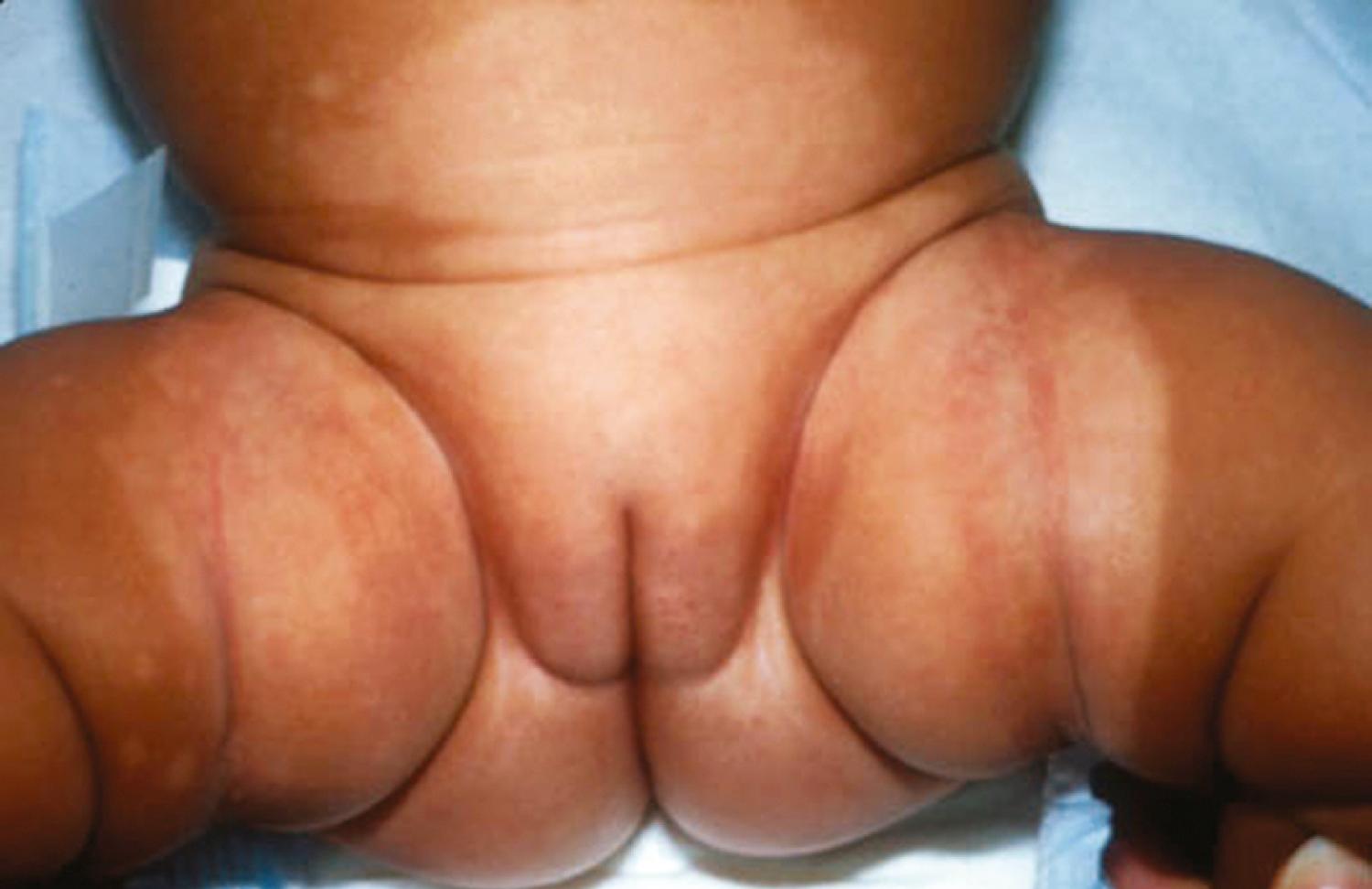
Job syndrome, or hyper-IgE syndrome, is a rare genetic disorder with prominent cutaneous manifestations. It has been linked to a mutation on the signal transducer and activator of transcription-3 (STAT3) gene on chromosome 17 and is inherited as an autosomal dominant trait with variable severity of expression. Affected patients have chronic eczema, recurrent staphylococcal infections, retained primary teeth, hyperextensible joints, fractures, and coarse facial features, including a broad nose. They also have variably but significantly elevated levels of serum IgE and circulating eosinophils.
Dermatologic features include a pruritic dermatitic rash that shares features with both atopic dermatitis and seborrhea, which tends to develop shortly after birth (earlier than seborrhea and atopic dermatitis). It rapidly becomes superinfected with S. aureus, which results in the formation of weeping, crusting, and folliculotic lesions, as well as cutaneous abscesses ( Fig. 8.25 ). In contrast to furuncles in patients with a normal immune response, the abscesses in children with Job syndrome are termed “cold,” meaning they cause little pain and show few signs of inflammation. Development of mucocutaneous candidiasis is also common. Other clinical manifestations include recurrent/chronic infections, such as bronchitis, pneumonia (with pneumatoceles), sinusitis, otitis, gingivitis, dental abscesses, septic arthritis, and osteomyelitis. Decreased bone density is the source of multiple fractures, which cause remarkably little pain. With age and growth, facial features tend to coarsen (see Chapter 4 ) and scoliosis is common.
Treatment is aimed at controlling infections and ameliorating symptoms. The major differential diagnostic consideration is Langerhans histiocytosis (see Fig. 8.88 ).
Pityriasis rosea is a benign, self-limited disorder that can occur at any age but is more common in adolescents and young adults. A prodrome of malaise, headache, and mild constitutional symptoms occasionally precedes the rash but is not necessary for diagnosis. The typical eruption begins with the appearance of one or multiple “herald patches” ( Fig. 8.26A ), which are large, isolated, oval lesions, usually pink in color and slightly scaly; they may occur anywhere on the body. On occasion, the herald patch clears centrally, mimicking tinea corporis. From 5 to 10 days later, other smaller oval lesions appear on the body, frequently concentrated over the trunk but also seen on the proximal extremities, especially the thighs (see Fig. 8.26B – G ). On occasion, lesions predominate on the face, groin, and/or distal extremities, including the palms and soles, a phenomenon known as inverse pityriasis, which is more common in African American patients. Pityriasis lesions begin as small, oval to round papules that enlarge to oval plaques up to 1 to 2 cm in size, with a scaly surface. They are usually somewhat raised but can be macular, and they can be erythematous, hyperpigmented, or hypopigmented. The long axes of the ovals tend to run parallel to the lines of the cleavage of the skin, creating a “Christmas tree” pattern over the thorax (see Fig. 8.26C and D ). The rash reaches its peak in several weeks and then slowly fades over 4 to 8 weeks. The average total duration is 2 to 3 months. Oral erythromycin or doxycycline and small doses of ultraviolet light may hasten the disappearance of the eruption. Although the cause is unknown, the peak incidence in late winter and the low recurrence rate favor an infectious etiology.
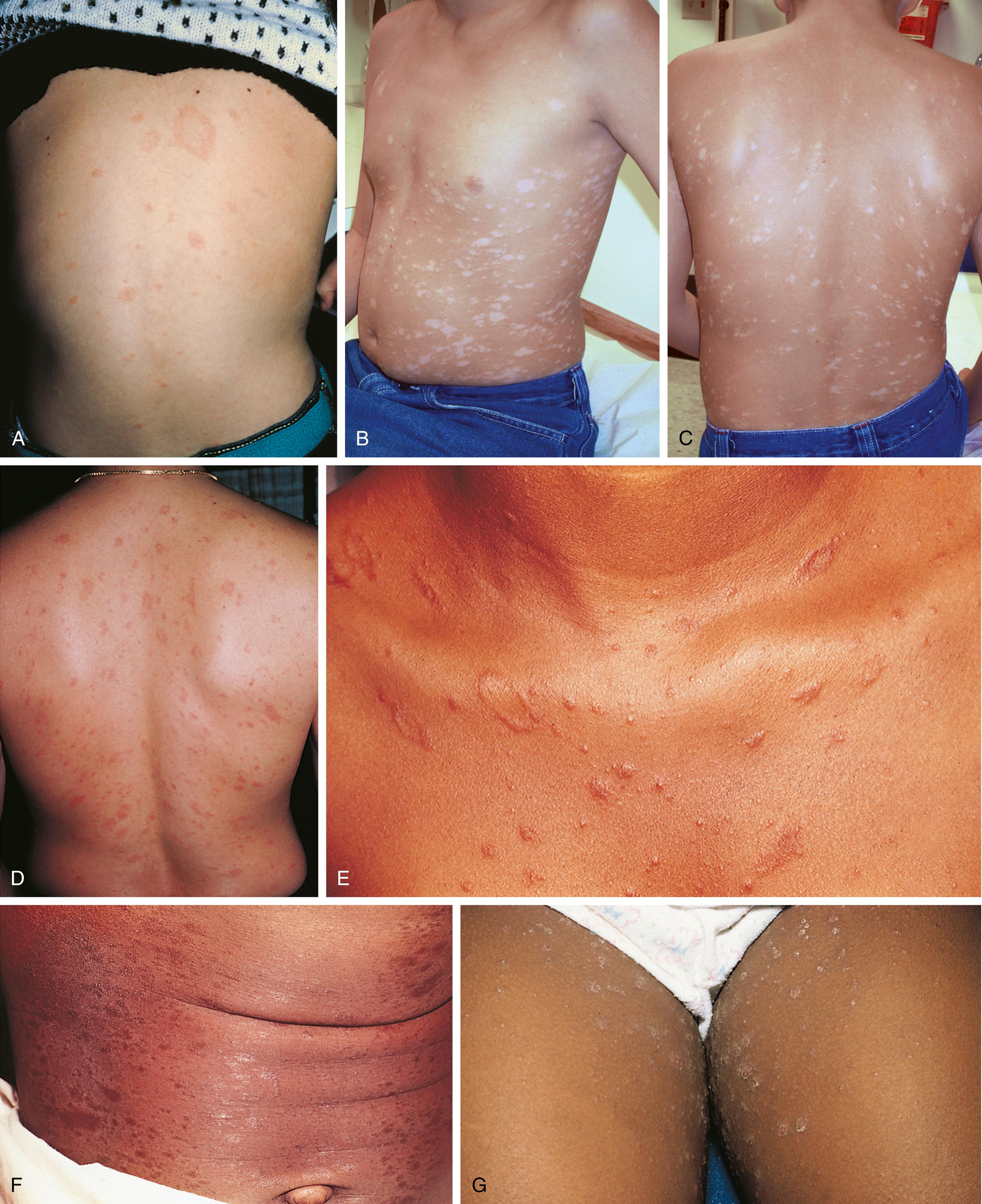
Other eruptions that can resemble pityriasis rosea include guttate psoriasis, benign parapsoriasis, viral exanthems, measles-like (morbilliform) drug eruptions, and secondary syphilis (see Chapter 19 ). Secondary syphilis should specifically be considered when a patient presents with a rash resembling pityriasis rosea and the palms and soles are involved. As noted earlier, the appearance of the herald patch may simulate tinea corporis, but a potassium hydroxide (KOH) preparation is negative.
Pityriasis lichenoides is a spectrum of disorders characterized by recurrent crops of spontaneously regressing erythematous papules. It is more prevalent in the pediatric and young adult population. The acute form pityriasis lichenoides et varioliformis acuta (PLEVA) and the chronic form pityriasis lichenoides chronica (PLC) exist on two ends of the disease continuum, although there can be overlap.
In patients with PLEVA, individual lesions develop crusts, ulcers, and occasionally vesicles or pustules ( Fig. 8.27A ), which may heal with scars. These lesions typically resolve within weeks. PLC has a more indolent course. The papules are usually reddish-brown and scaly ( Fig. 8.27B ). They regress over weeks to months, usually leaving residual hypopigmented macules.
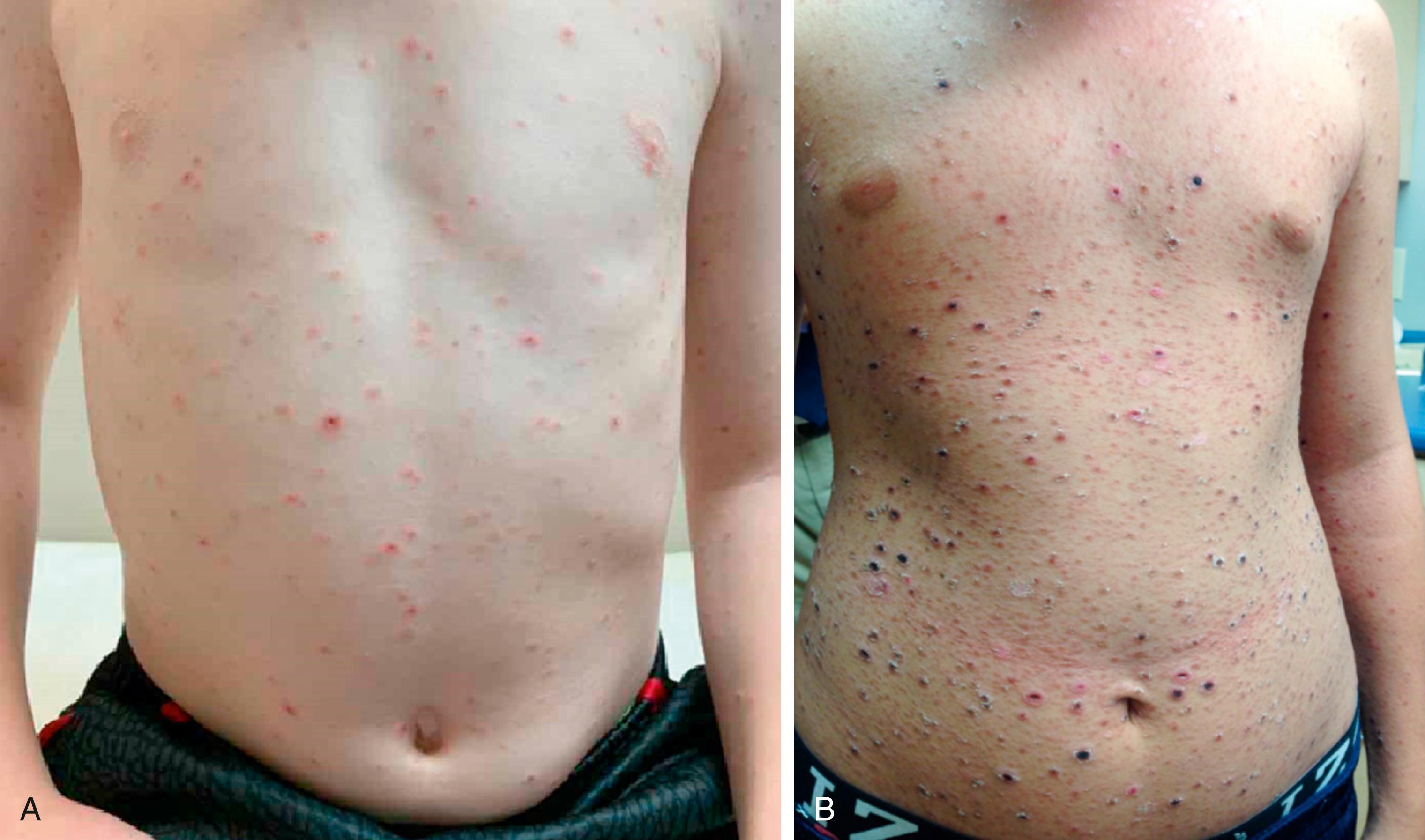
First-line therapy includes topical corticosteroids, oral tetracyclines, oral erythromycin, and phototherapy.
Contact dermatitis refers to a group of conditions in which an inflammatory reaction in the skin is triggered by direct contact with environmental agents. In the most common form, irritant contact dermatitis, changes in the skin are induced by caustic agents, such as acids and alkalis, hydrocarbons, and other primary irritants. Anyone exposed to these agents in a high enough concentration for a long enough period will ultimately develop dermatitis. The rash is usually acute, with well-demarcated erythema, crusting, and/or blister formation.
In contrast, allergic contact dermatitis is a T lymphocyte–mediated immune reaction to an antigen coming into contact with the skin. Although patients typically present with acute onset of erythema, vesiculation, and pruritus, in some cases they delay seeking care until after the rash has become chronic with scaling, lichenification, and pigmentary changes. Often, the allergen is obvious, as is the case with poison ivy or nickel jewelry. However, in other cases, careful questioning or more formal patch testing may be required to detect the inciting agent.
The initial reaction occurs after a 7- to 14-day period of sensitization in susceptible individuals. Once sensitization has occurred, reexposure to the allergen provokes a more immediate reaction, sometimes within hours. This is a classic example of type IV (delayed) hypersensitivity (see Chapter 4 ).
The most common type of allergic contact dermatitis in the United States is poison ivy, or rhus dermatitis. This typically presents with linear streaks of erythematous papules and vesicles ( Fig. 8.28A ); however, with heavy exposure, the rash may appear in relatively large or confluent patches (see Fig. 8.28B and C ). When lesions involve the skin of the face or genitalia, impressive swelling can occur (see Fig. 8.28D ).
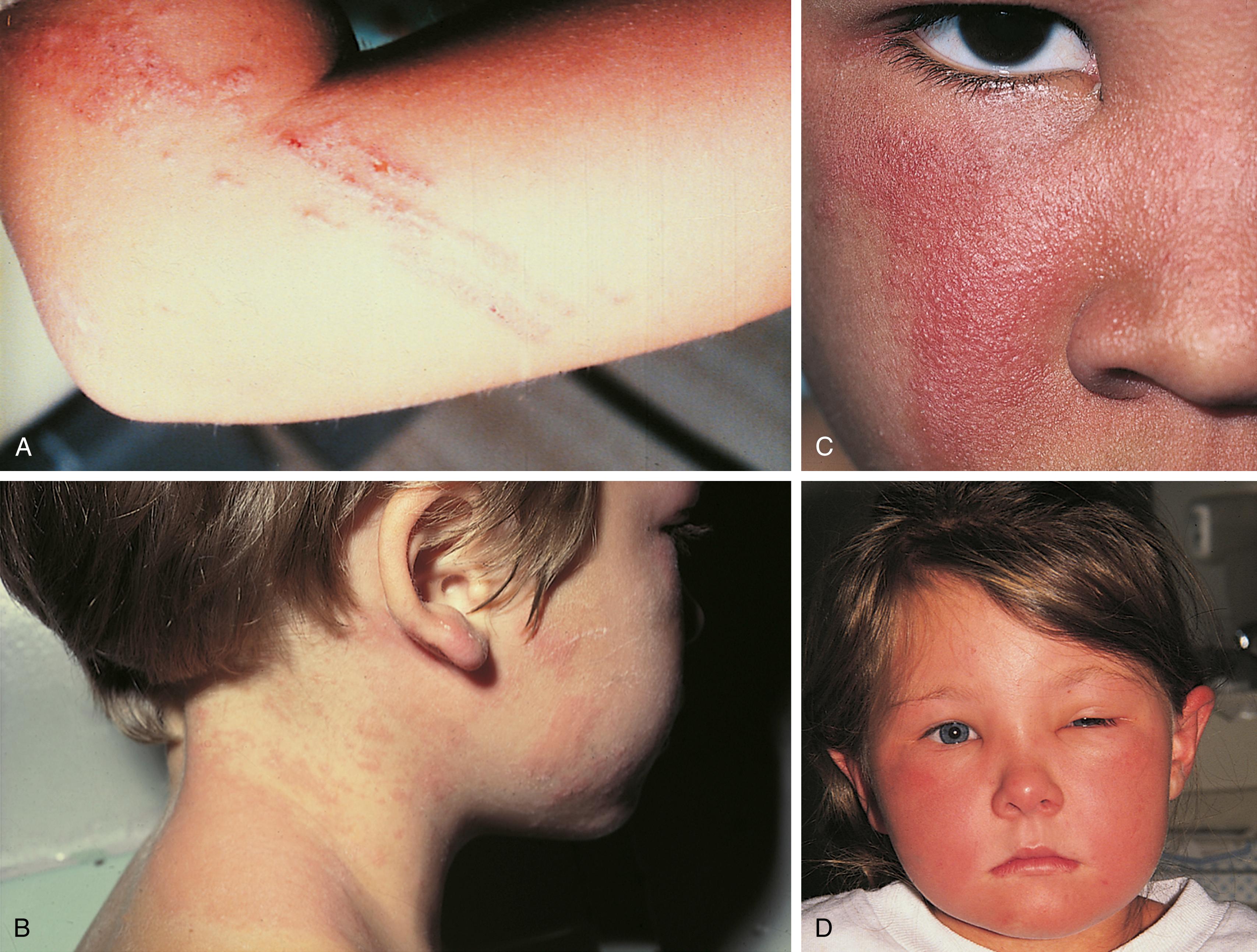
Direct contact with the sap of poison ivy, poison oak, or poison sumac from leaves, stems, or roots (whether the plant is alive or dead) produces the dermatitis ( Fig. 8.29 ). Contact with clothing that has brushed against the plant, with logs or railroad ties on which the vine has been growing, or with smoke from a fire in which the plant is being burned are other means of exposure. Areas of skin exposed to the highest concentration of plant oil develop changes first. Other sites that received lower doses then vesiculate in succession, giving the illusion of spreading. However, this is not the case because, within approximately 20 minutes of initial contact, the rhus oil becomes tissue-fixed to the epithelial cells and cannot be spread farther. Thorough washing within minutes of exposure can prevent fixation and hence the eruption. On occasion the oil can oxidize, leaving a black discoloration superimposed on the contact dermatitis; this is known as black dot or urushiol dermatitis.
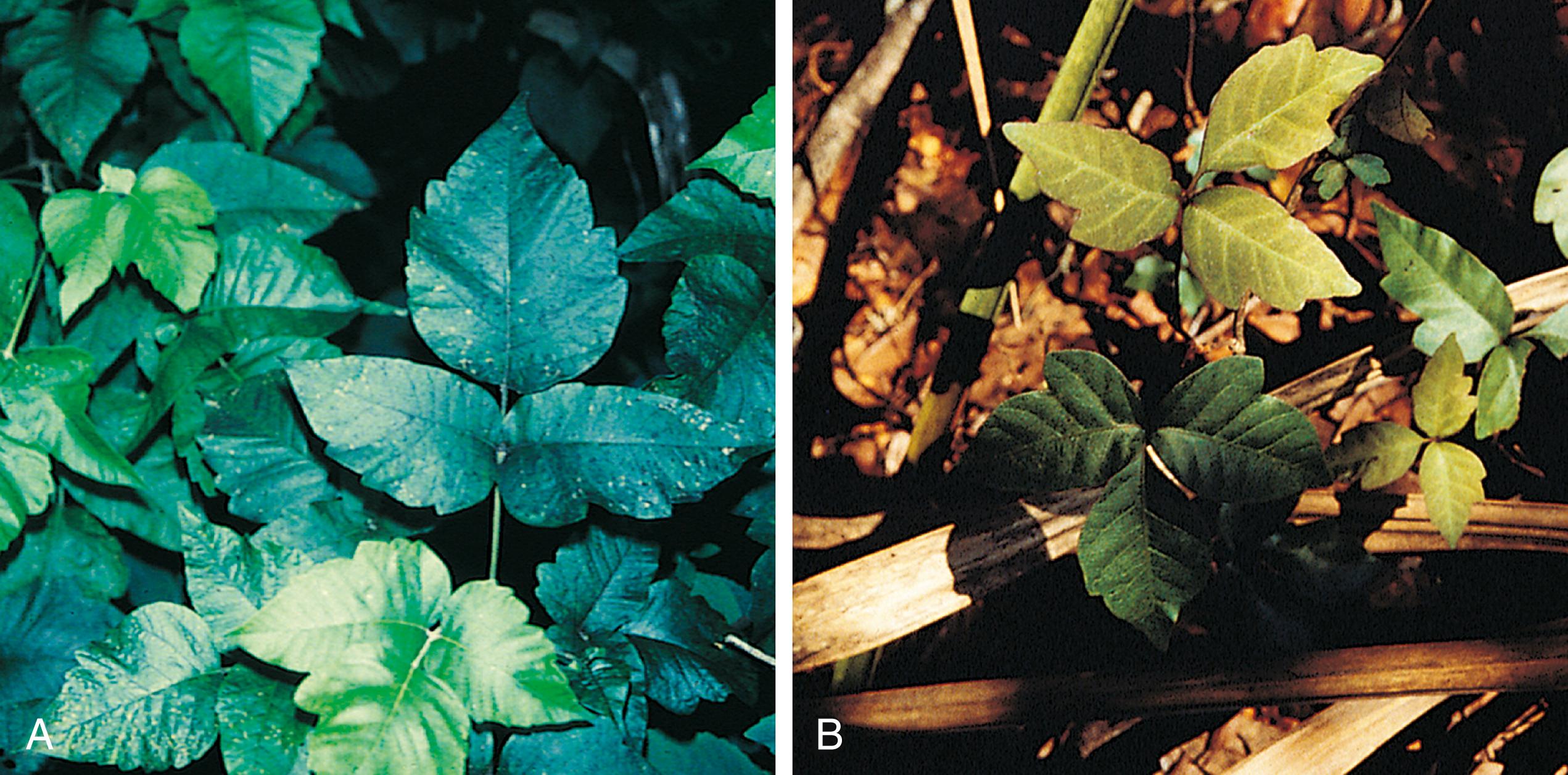
Other common contact allergens are nickel ( Fig. 8.30 ), rubber ( Fig. 8.31 ), glues and/or dyes in shoes or diapers ( Fig. 8.32 ), ethylenediamine in topical lotions, cocamidopropyl betaine in shampoos and cosmetics, neomycin, and topical anesthetics ( Fig. 8.33 ). Paraphenylenediamine dye used in amateur henna tattoos is an increasingly common cause of contact dermatitis among adolescents, and the pattern reflects the image of the original tattoo ( Fig. 8.34 ). Methylchloroisothiazolinone/methylisothiazolinone (MCI/MI) or MI alone are emerging common cause of contact dermatitis from moist wipes and personal care products.
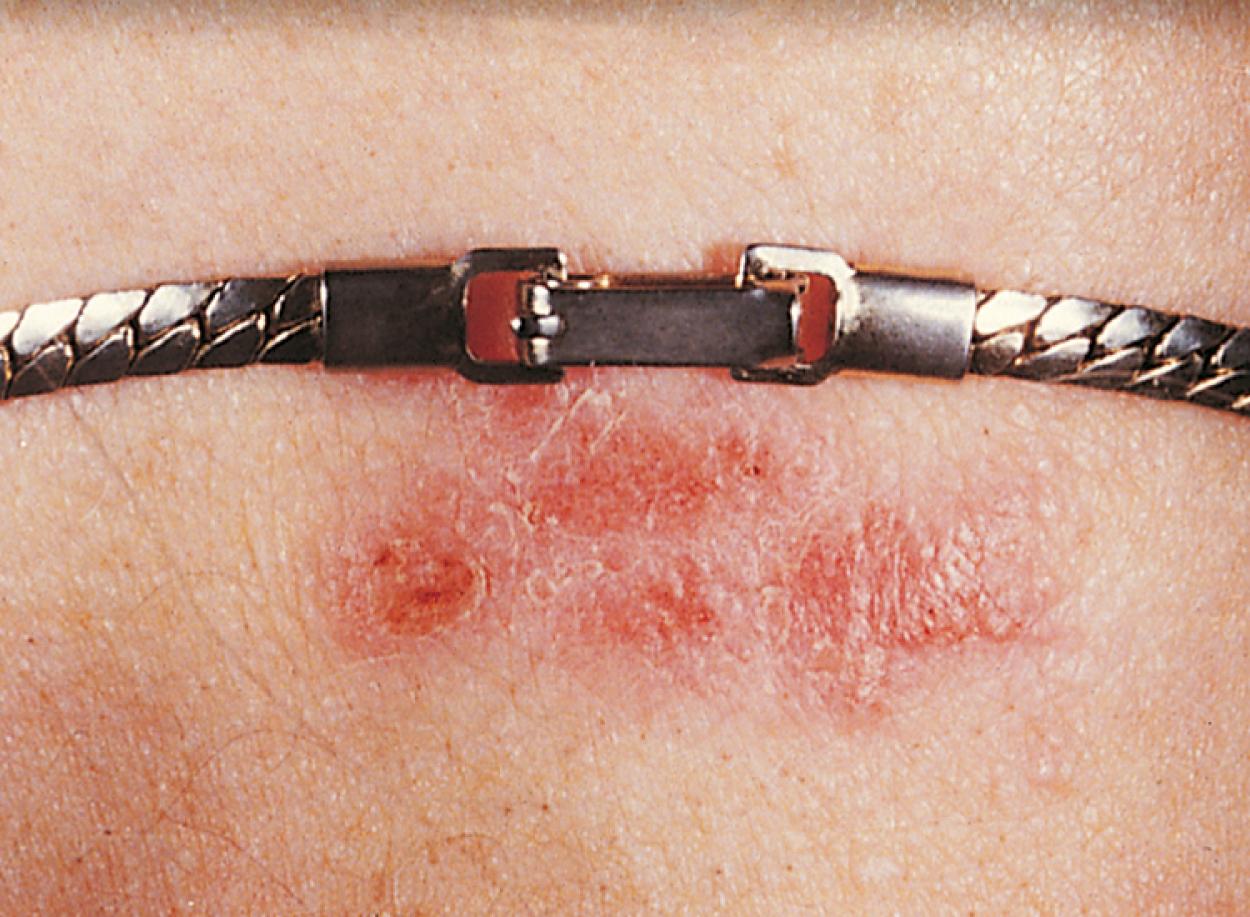
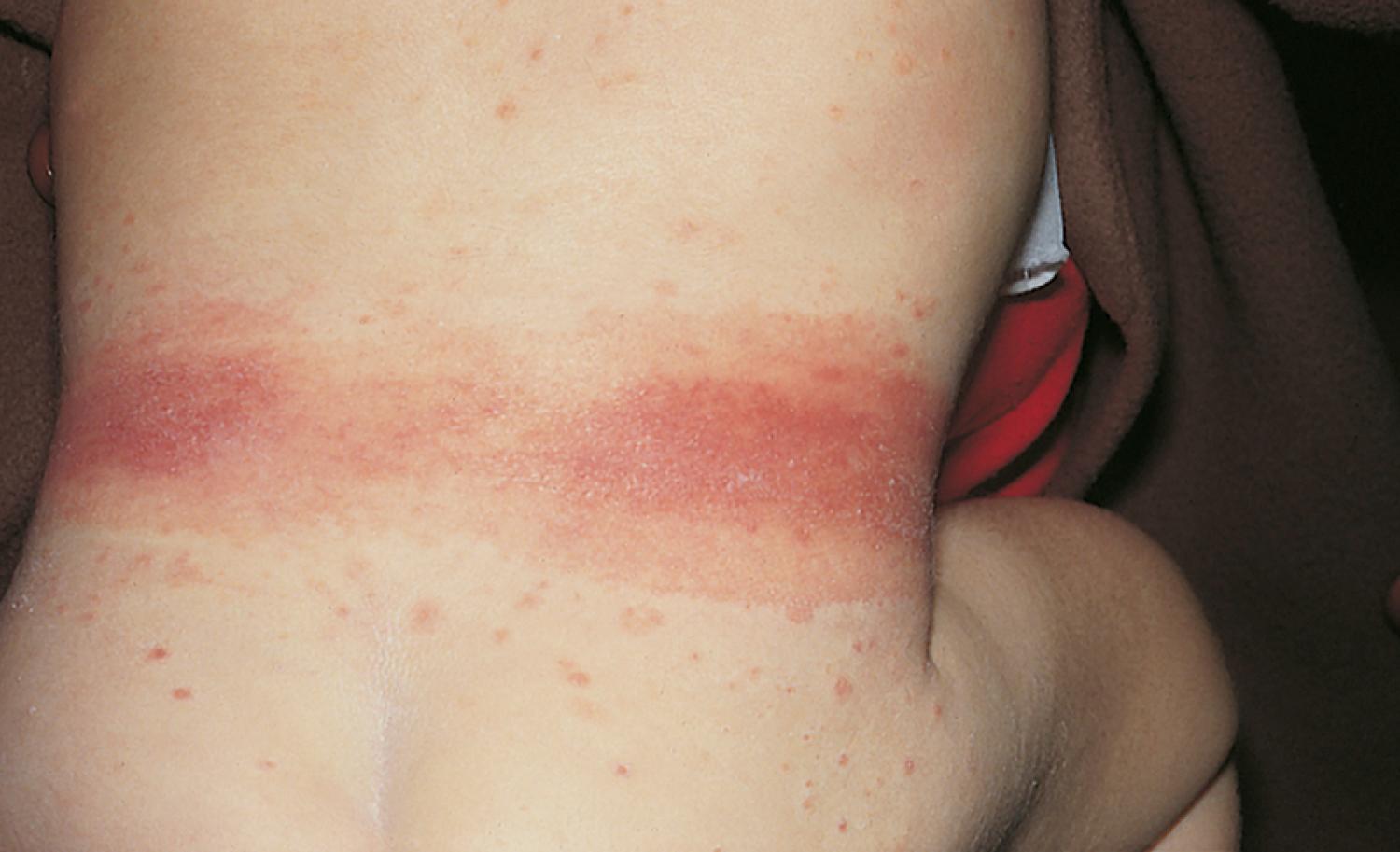
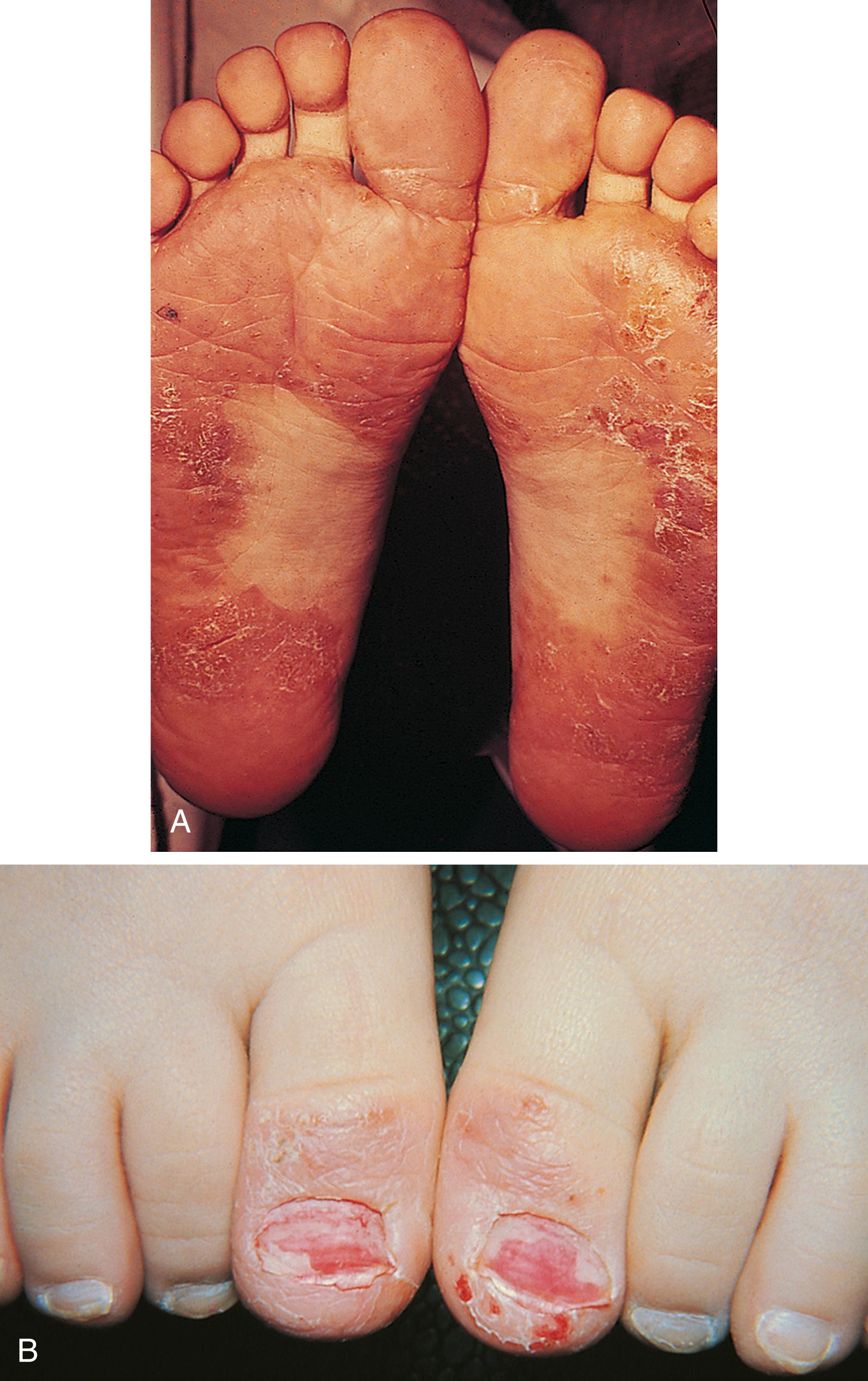
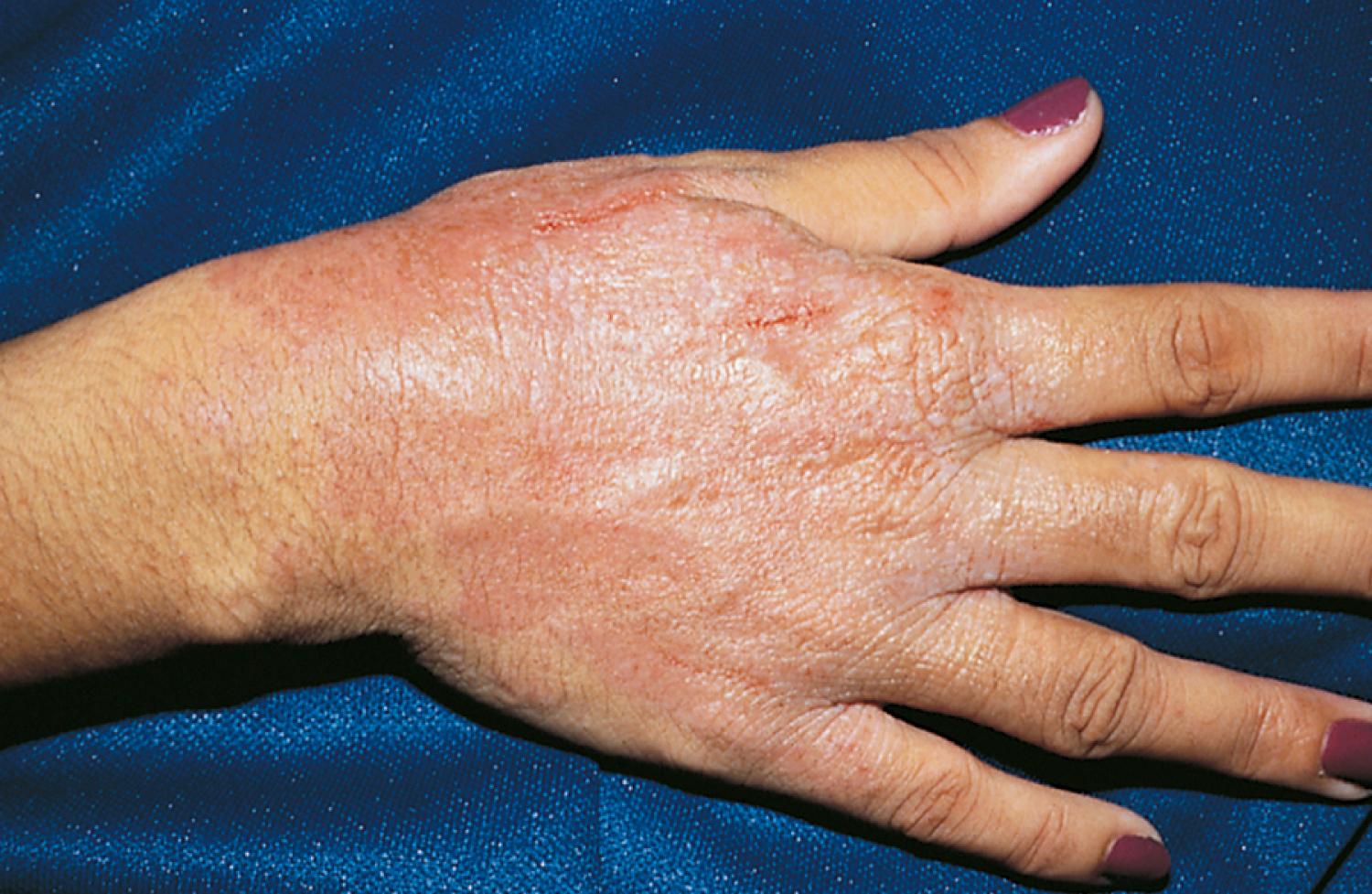
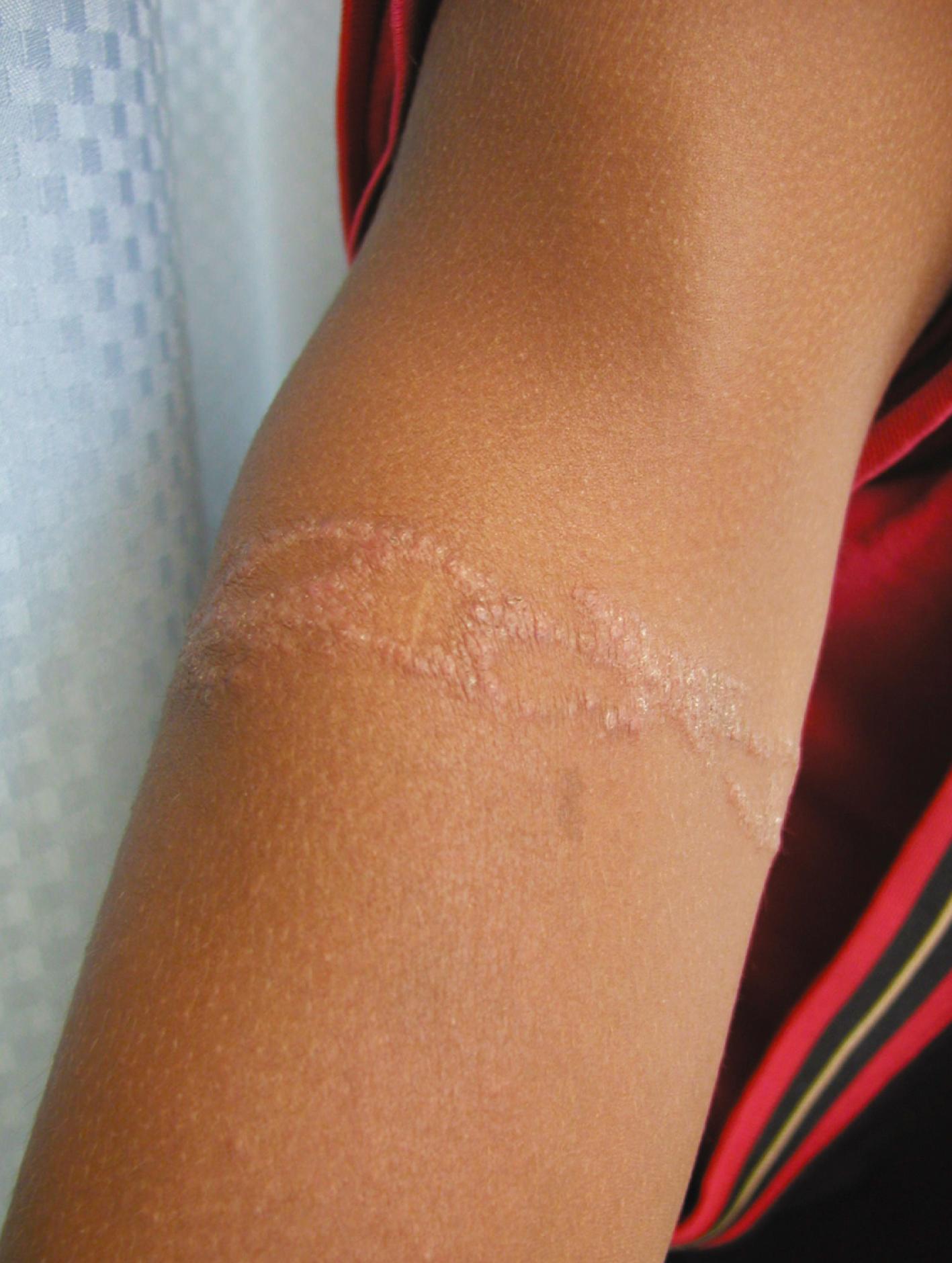
Phototoxic reactions occur when a topical or systemic drug is used in conjunction with sun exposure and it intensifies the reaction to the sun. In the systemic reaction, it characteristically erupts in a symmetric distribution on the face, the V of the neck, and the arms and legs distal to the end of shirt sleeves and shorts. Photo-onycholysis, or separation of the nail plate from the nail bed, can also occur as a manifestation of a phototoxic drug eruption. Common causative agents include the tetracyclines (especially doxycycline), isotretinoin, sulfonylureas, thiazides, nonsteroidal anti-inflammatory drugs (NSAIDs), fluoroquinolones, and griseofulvin. Phototoxins, when applied to the skin, are the source of a nonimmunologic exaggerated sunburn reaction in which the initial erythema progresses to hyperpigmentation. Topical photosensitizers include fragrances in cosmetics and furocoumarins. Of these, phytophotodermatitis reactions from furocoumarins are the most common. In this form, plant-derived photosensitizers, psoralens, which are found in the juices of lemons, limes, figs, dill, parsley, parsnips, carrots, and celery, are responsible for the reaction. A child may either come into direct contact with one of these agents or be exposed by a parent who has been cutting the fruit, herbs, or vegetables, thereby getting the juice on the child’s skin. Subsequent exposure to sunlight then results in the appearance of erythematous macules, with or without accompanying bullae, which then go on to become hyperpigmented. These patches often have bizarre or hand/finger-shaped patterns that can mimic child abuse (see Chapter 6 ).
Photocontact or photoallergic dermatitis, on the other hand, is a true T-cell-mediated delayed hypersensitivity reaction that necessitates an initial period of sensitization, after which time continued or future contact with the allergen only in combination with sun exposure may precipitate development of a contact dermatitis. Common photocontact allergens include oxybenzone and avobenzone, which are ironically the most common active ingredients in chemical sunscreen ( Fig. 8.35 ).
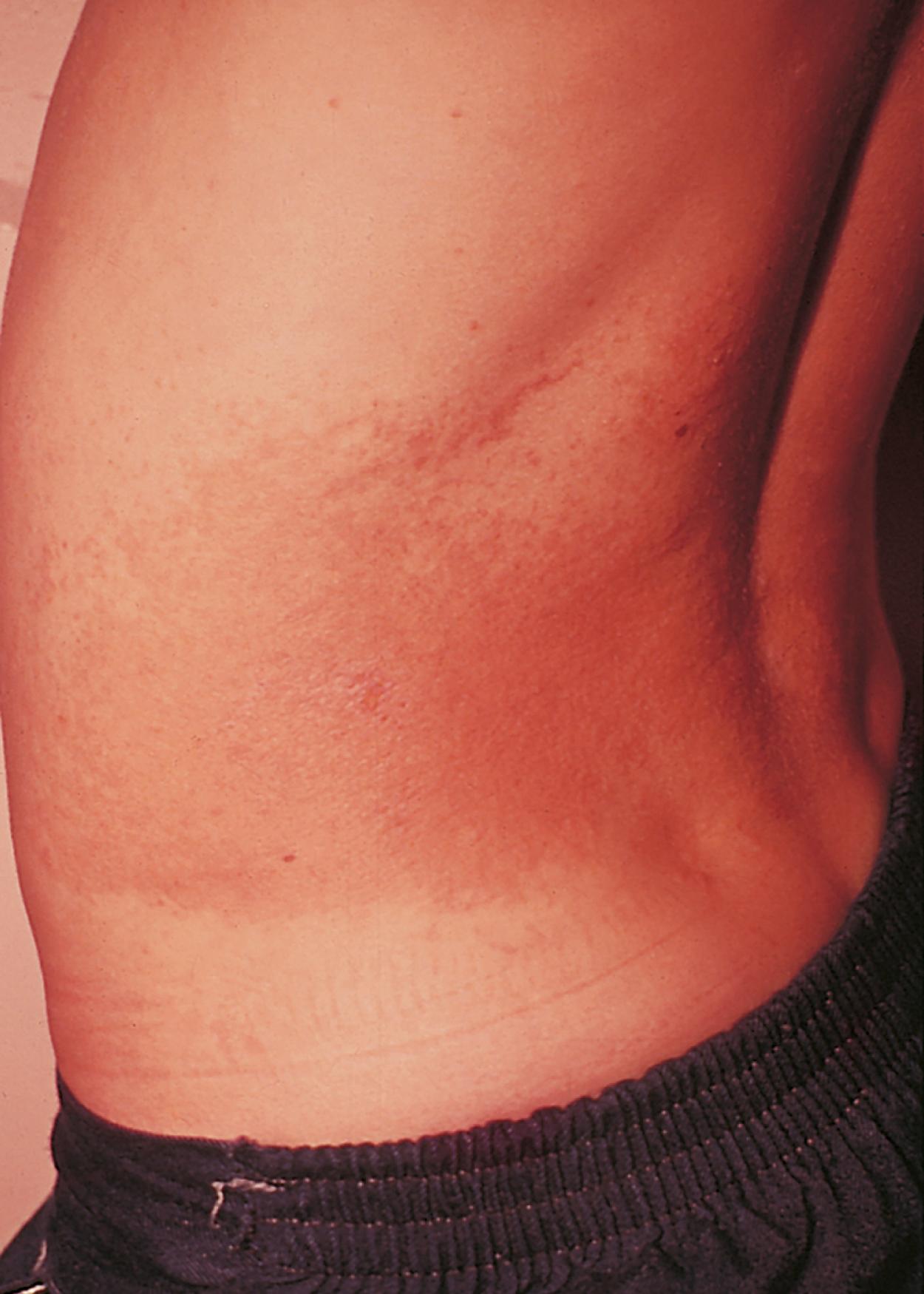
On occasion, the local reaction of a contact dermatitis can be so severe that the patient develops a more widespread secondary eczematous dermatitis. When the dermatitis appears at sites that have not been in contact with the offending agent, the reaction is referred to as autoeczematization or an “id” reaction. Id reactions can also occur in patients with tinea, especially coincident with the start of oral therapy.
Although localized patches of contact dermatitis are best treated topically, widespread reactions require a 2-week tapering course of systemic corticosteroids beginning at 0.5 to 1 mg/kg/day. Patients may experience rebound of the rash if treated with a shorter course. Response usually occurs within 48 hours. Oral steroids may also be indicated in localized reactions involving the eyelids, extensive areas of the face, genitals, and/or hands, where swelling and pruritus may become incapacitating.
Prevention requires identification of the offending agent and then its avoidance. Children with rhus dermatitis should be shown pictures of the causative plants and taught where they are commonly found. Patients sensitive to nickel must ensure that jewelry, particularly earring posts, is made of 24-karat gold, stainless steel, or sterling silver. However, in some patients painting watchband buckles with clear nail polish every several weeks can obviate the difficult task of trying to find watchbands with pure gold or silver buckles.
Two types of fungal organisms produce clinical cutaneous disease: dermatophytes and yeasts. Dermatophytes include the tinea or ringworm fungi, and yeasts include Candida species, which are associated with diaper dermatitis and Pityrosporum species, which cause tinea versicolor. Both Candida and Pityrosporum have been implicated as contributing to seborrhea.
Tinea corporis is a superficial fungal infection of the non-hairy or glabrous skin. It has been labeled “ringworm” because of its characteristic configuration consisting of pruritic, annular lesions with central clearing and an active border made up of microvesicles that rupture and then scale ( Fig. 8.36A–C ). Lesions, which may be single or multiple, typically begin as pruritic red papules or pustules that rupture and evolve to form papulosquamous lesions, which are also pruritic. These then spread out from the periphery as new papulovesicles form at their outer margins and at the same time begin to clear centrally (see Fig. 8.36D and E ). Over a period of several weeks, the patches may expand up to 5 cm in diameter. Tinea corporis can be found in any age group and is usually acquired through direct human contact (Trichophyton tonsurans) or from an infected pet, such as a kitten.
Clinically, tinea may be differentiated from atopic dermatitis by its propensity for autoinoculation from the primary patch to other sites on the patient’s skin, by the spread to close contacts, and by the central clearing noted in many lesions. Moreover, the rash of atopic dermatitis tends to be symmetric, chronic, and recurrent in a flexural distribution. Unlike tinea, patches of nummular eczema are self-limited and do not clear centrally. The herald patch of pityriasis rosea is often mistaken for tinea. However, it is KOH negative, and the subsequent development of the generalized rash with its characteristic symmetric truncal distribution is distinctive (see Fig. 8.26 ). The clinical pattern, findings, and chronic nature of psoriasis and seborrhea help differentiate them from tinea. Although granuloma annulare produces a characteristic ringed eruption, on palpation the lesions are dermal, not epidermal, so they do not classically exhibit scaling as tinea does (see Fig. 8.89 ).
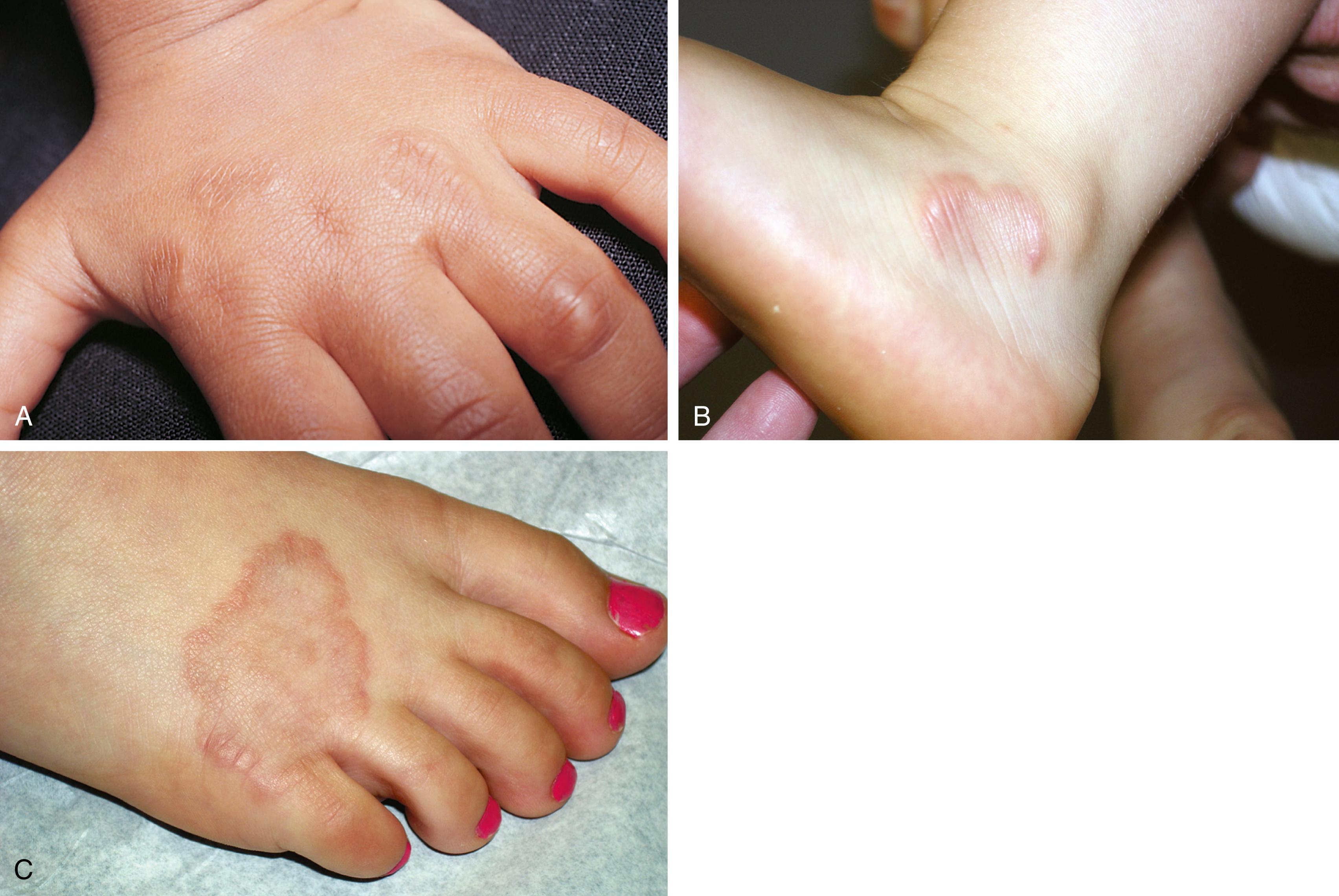
The diagnosis of tinea corporis is confirmed by KOH examination of skin scrapings. The first step is to obtain material by scraping the loose scales at the margin of a lesion ( Fig. 8.37A ). These should be mounted onto the center of a glass slide, with one or two drops of 20% KOH solution added. Next, a glass coverslip is applied and gently pressed down with the eraser end of a pencil to crush the scales (see Fig. 8.37B ). The clinician then gently heats the slide, taking care not to boil the KOH solution, and again the coverslip is pressed down. When viewing the slide under the microscope, the clinician sets the condenser and light source at low levels to maximize contrast, with the objective at ×10. On focusing up and down, true hyphae are seen as long, branching, often septate rods of uniform width that cross the borders of epidermal cells ( Fig. 8.38 ). Cotton fibers, cell borders, or other artifacts may be falsely interpreted as positive findings.

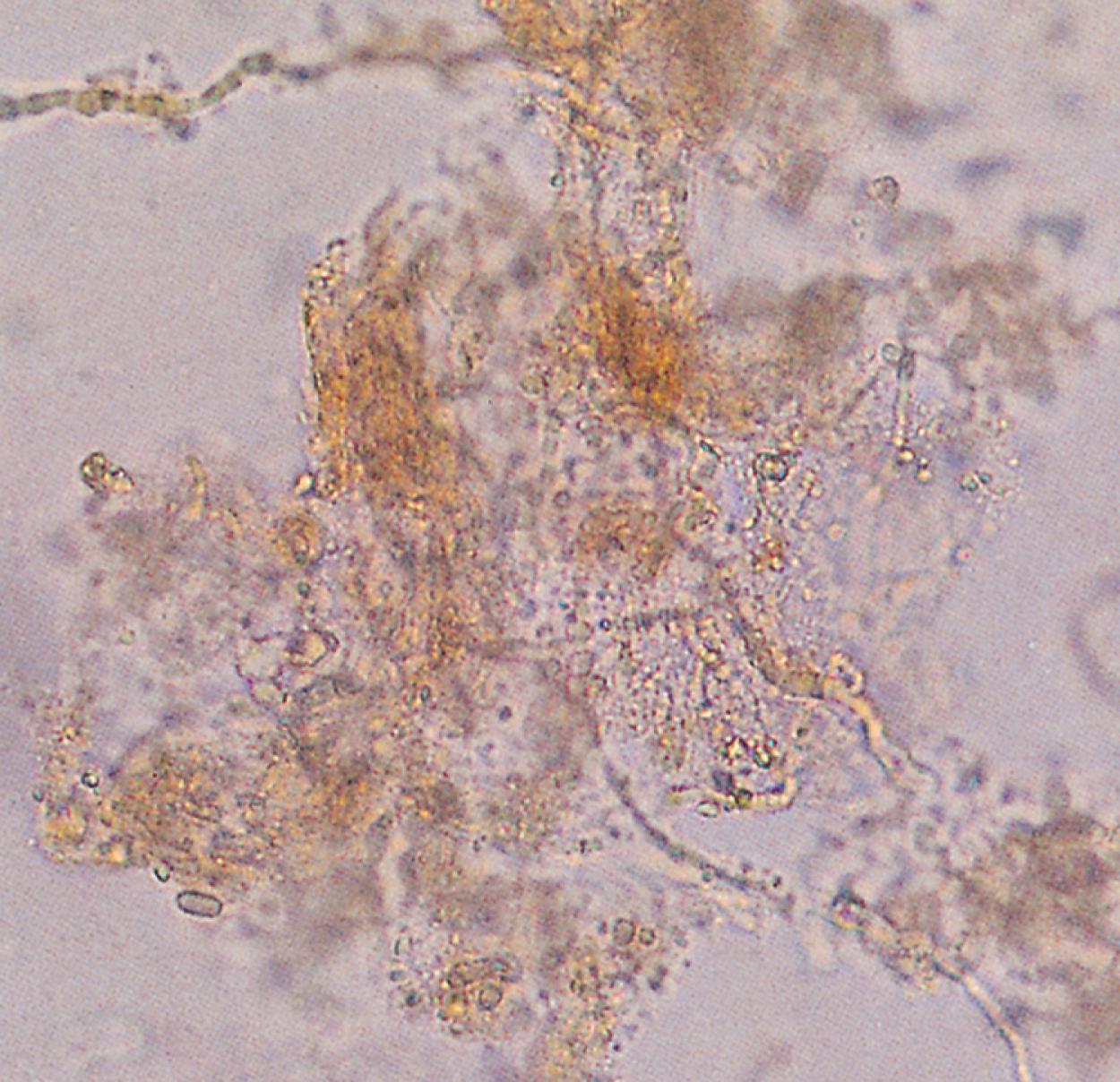
Tinea infections on glabrous skin readily respond to topical antifungal creams, such as miconazole, clotrimazole, econazole, naftifine, ketoconazole, and ciclopirox. When lesions are multiple or widespread, oral therapy with griseofulvin is indicated. Itraconazole, terbinafine, and fluconazole are good alternatives for systemic antifungal therapy. Like griseofulvin, they are effective against most ringworm organisms, but unlike griseofulvin, these medications are concentrated in skin, hair, and nails for weeks to months after they are discontinued. Tinea infections should never be treated with the topical products that combine an azole antifungal with a medium or high-potency topical steroid. Paradoxically, these agents increase the likelihood that the fungal infection will spread deeper within the skin and be more resistant to topical therapy, a process called tinea incognito or Majocchi granuloma. At this stage, oral therapy often becomes necessary to clear the infection.
Commonly referred to as athlete’s foot, tinea pedis is a fungal infection of the feet with a predilection for the web spaces between the toes. Tinea pedis is quite common in adolescence, somewhat less so in prepubertal children. The infecting organisms are acquired from contaminated shower, bathroom, locker room, and gym floors, and their growth is fostered by the warm, moist environment of shoes.
In some cases, scaling and fissuring predominate; in others, vesiculopustular lesions and maceration are found, especially in the web spaces between the third, fourth, and fifth toes. The infection begins between and along the sides of the toes, where it may remain ( Fig. 8.39A ). However, lesions can extend over the dorsum of the foot (see Fig. 8.39B ) and may involve the plantar surface as well, particularly the instep and ball of the foot. Patients complain of a combination of burning and itching, which is frequently intense.
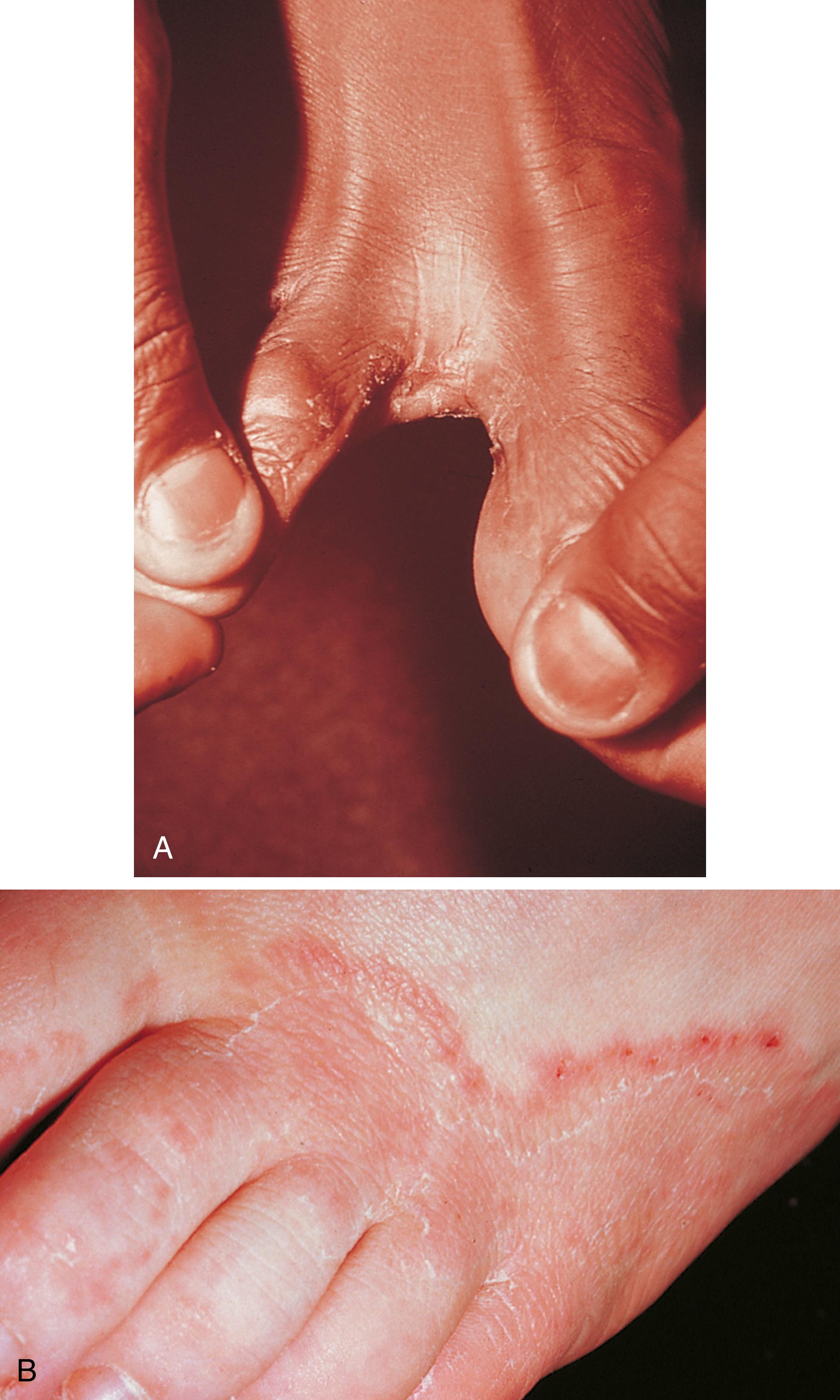
This diagnosis often can be made on clinical grounds and is confirmed by KOH preparation of skin scrapings. The mainstays of treatment are topical antifungal creams or powders, as well as measures designed to reduce foot moisture. The latter include careful drying of the feet after bathing, wearing cotton rather than synthetic socks, and wearing shoes that do not promote sweating or, better still, sandals. In patients with severe inflammatory lesions, oral antifungal agents may be required. Onychomycosis (see Fig. 8.136 ) responds well only to oral agents and requires treatment for 12 weeks, occasionally longer (see Disorders Affecting the Nails, later). Secondary bacterial infection (particularly with gram-negative organisms) may be a problem.
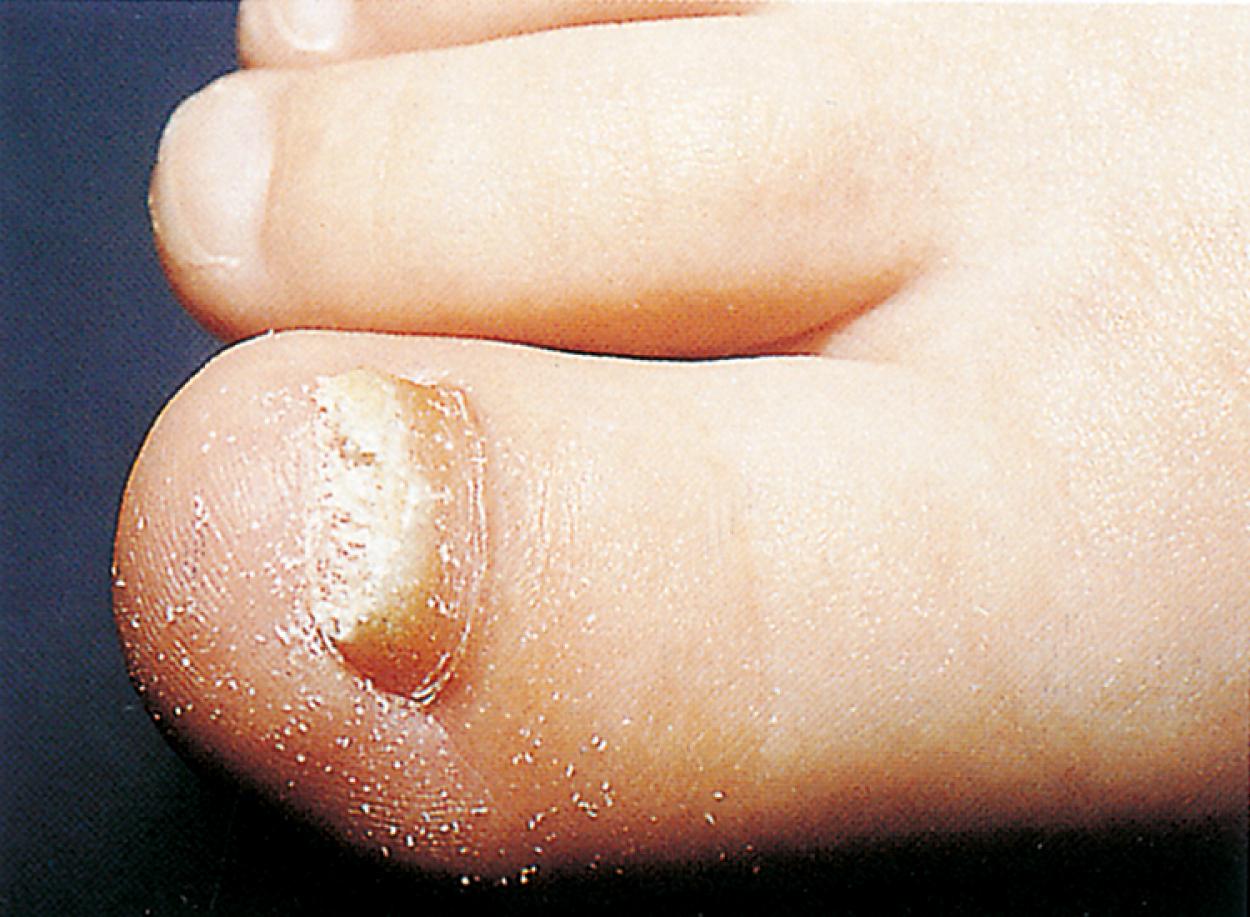
Tinea pedis is distinguished from contact dermatitis of the feet by virtue of the fact that the latter spares the interdigital web spaces (see Fig. 8.32 ). Dyshidrosis can have a similar distribution, but the KOH preparation is negative (see Fig. 8.18 ).
Tinea versicolor is a common dermatosis characterized by multiple small, oval, scaly patches measuring 1 to 3 cm in diameter, usually located in a guttate or raindrop pattern on the upper chest, back, and proximal portions of the upper extremities of adolescents and young adults ( Fig. 8.40A and B ). Facial involvement occurs occasionally. The eruption is caused by a dimorphous form of Pityrosporum. Warm, moist climates, pregnancy, immunodeficiency, and genetic factors predispose people to the development of infection.
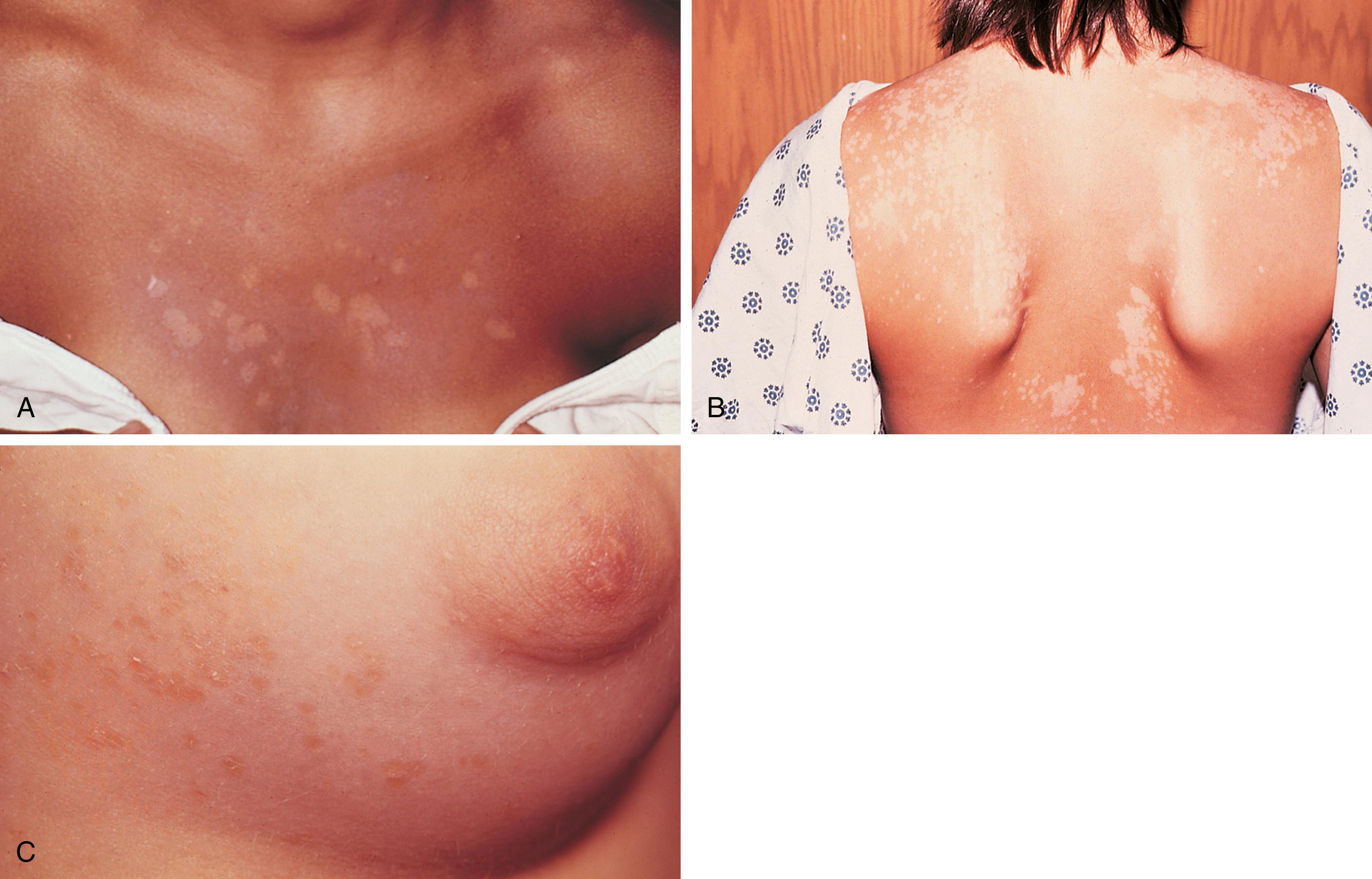
The rash is usually asymptomatic, although some patients complain of mild pruritus. Typically, patients seek treatment because they are bothered by the cosmetic appearance of the lesions. Lesions may be light tan, reddish, or lightly discolored, giving rise to the term versicolor. They are darker than surrounding skin in non–sun-exposed areas (see Fig. 8.40C ) and lighter in areas that have tanned on exposure to sunlight (see Fig. 8.40A and B ).
The diagnosis of tinea versicolor can generally be made on the basis of the clinical appearance of lesions and their distribution. It can be confirmed by examining the lesions under a Wood lamp, which reveals a characteristic tan to salmon-pink glow but no enhancement of the discoloration as in vitiligo. Although pathogenesis of the color change under a Wood lamp is not fully understood, the fungus is known to produce a substance that interferes with tyrosinase activity and subsequent melanin synthesis. A KOH preparation of the surface scale demonstrates short hyphal and yeast forms that resemble spaghetti and meatballs ( Fig. 8.41 ).
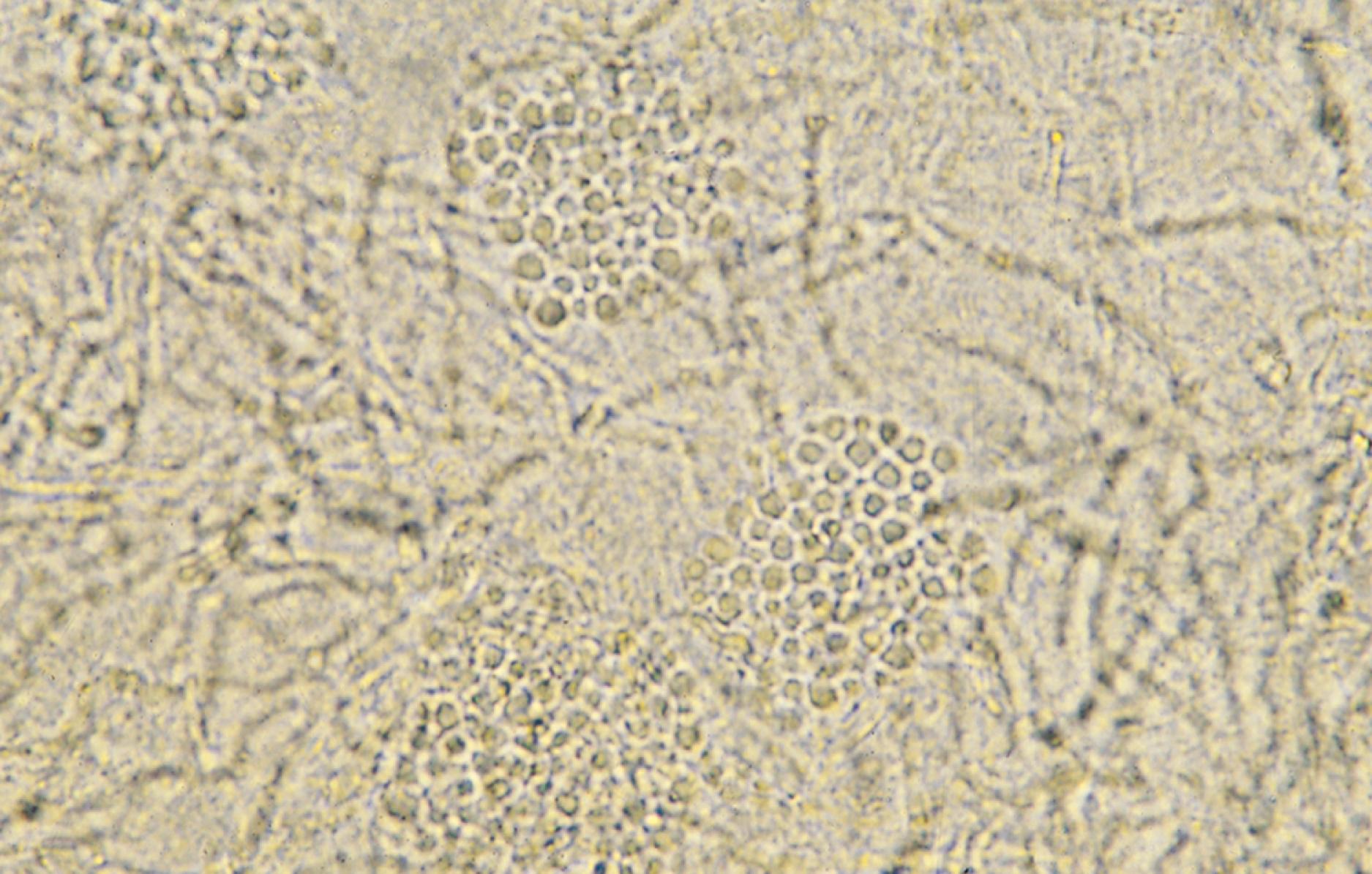
The differential diagnosis of tinea versicolor includes postinflammatory hypopigmentation and vitiligo. The history and distribution help to distinguish tinea versicolor from postinflammatory hypopigmentation; the presence of fine superficial scaling and some residual pigmentation (even in hypopigmented areas) that does not enhance with Wood lamp examination helps to rule out vitiligo.
Topical antiyeast agents such as selenium sulfide produce rapid clearing of the superficial lesions. Localized eruptions may be treated with topical antifungal creams, such as miconazole, clotrimazole, or econazole, and recalcitrant cases respond to oral fluconazole or itraconazole. Patients must be counseled about the high risk of recurrence, which often necessitates ongoing prophylactic selenium sulfide washes for several days each month. They should also be reminded that pigmentary changes may take months to clear, even after eradication of the fungus.
Because the diaper area is warm, often moist, and frequently contaminated by feces laden with organisms, diaper dermatitis is one of the most common skin disorders of infancy and early childhood.
The diaper area is a prime target for irritant dermatitis because it is bathed in natural irritants and then occluded. Failure to change diapers frequently is a major predisposing factor because it provides time for fecal bacteria to form ammonia by splitting the urea in urine. Harsh soaps, irritant chemicals, and detergents can contribute to the process. Moderate to severe diarrhea is another predisposing condition. The erythema, scaling, and, at times, maceration characteristic of irritant diaper dermatitis are usually confined to the convex surfaces of the perineum, lower abdomen, buttocks, and proximal thighs, sparing intertriginous areas ( Fig. 8.42 ). When neglected, this may progress, with further skin breakdown and ulceration. Frequent diaper changes; gentle, thorough cleansing of the area; and thick application of lubricants and zinc oxide barrier pastes usually result in clearing of the dermatitis. A short course of low-potency steroids may hasten resolution, but this must be discontinued after a week or so and then followed by prevention with thick, unfragranced zinc oxide pastes as a barrier. The author discourages use of combination topical steroid plus topical antifungal preparations because the strength of the topical steroid in these preparations often exceeds what would be considered safe in the occluded, thin skin of the diaper area.
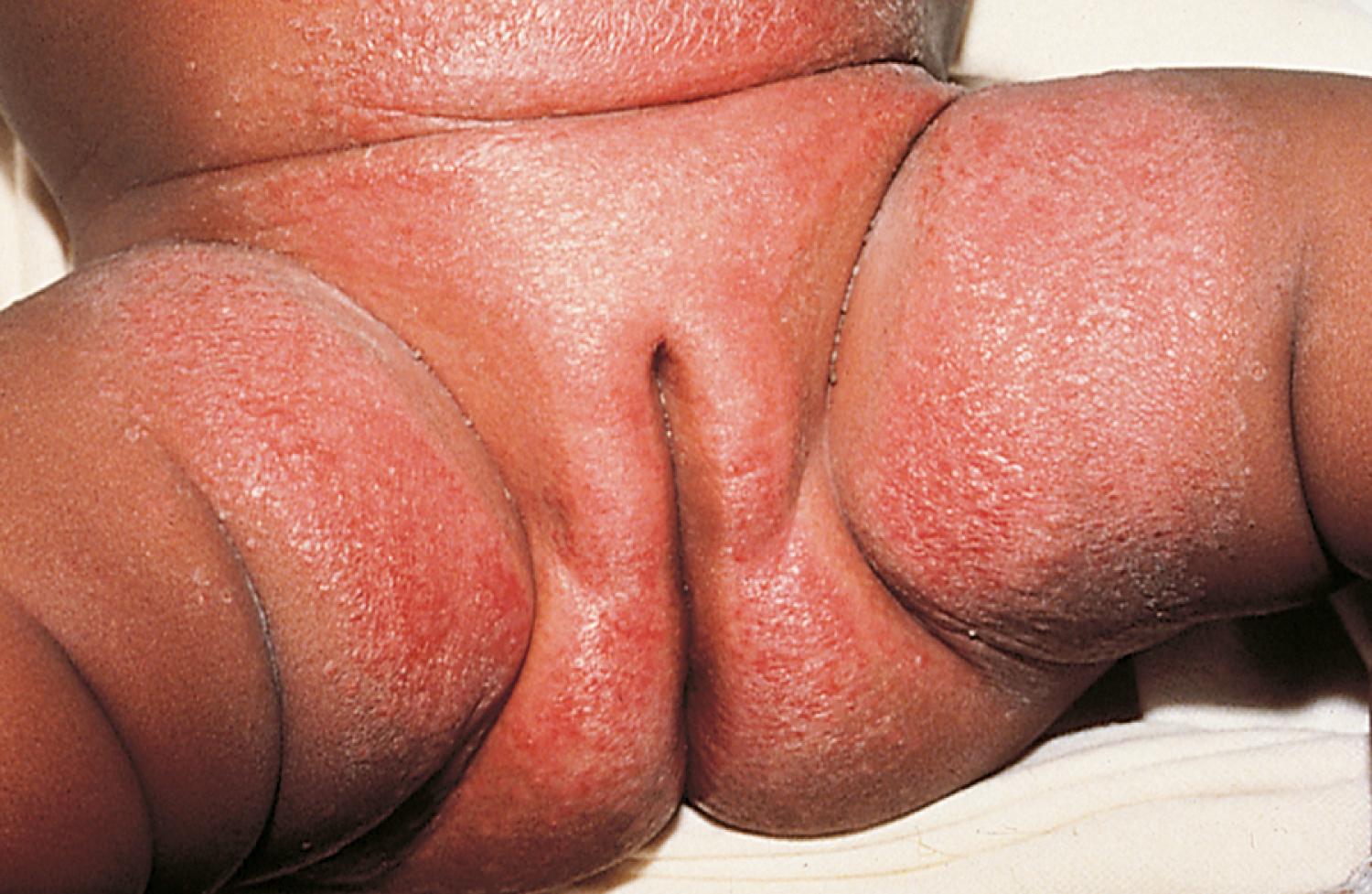
Persistent diaper dermatitis that does not resolve with conservative therapy may be due to other disorders, such as contact dermatitis to the blue dyes present in the diaper or to the MCI/MI in the moist wipes (this has become increasingly common), candidiasis, seborrheic dermatitis, psoriasis, or in rare cases Langerhans cell histiocytosis (see Fig. 8.88 ). These should be suspected particularly when intertriginous areas are involved.
Candidal diaper dermatitis appears as a bright red eruption, often with sharp borders and pinpoint satellite papules and pustules ( Fig. 8.43 ). Examination of pustule contents by KOH preparation reveals the typical budding yeasts and pseudohyphae of Candida organisms ( Fig. 8.44 ). Candidal diaper dermatitis is occasionally associated with oral thrush, and it is a common sequela of oral or parenteral antibiotic therapy. One should suspect a secondary invasion by Candida albicans whenever intertriginous areas are involved or when a diaper rash fails to respond to symptomatic treatment. Most cases respond well to topical antifungal therapy, but the occasional resistant case may require a brief course of oral medication. Again, Langerhans cell histiocytosis should be considered in the differential diagnosis of severe or recalcitrant intertriginous diaper dermatitis, especially when the papules become more crusted or are accompanied by petechiae and/or systemic symptoms.
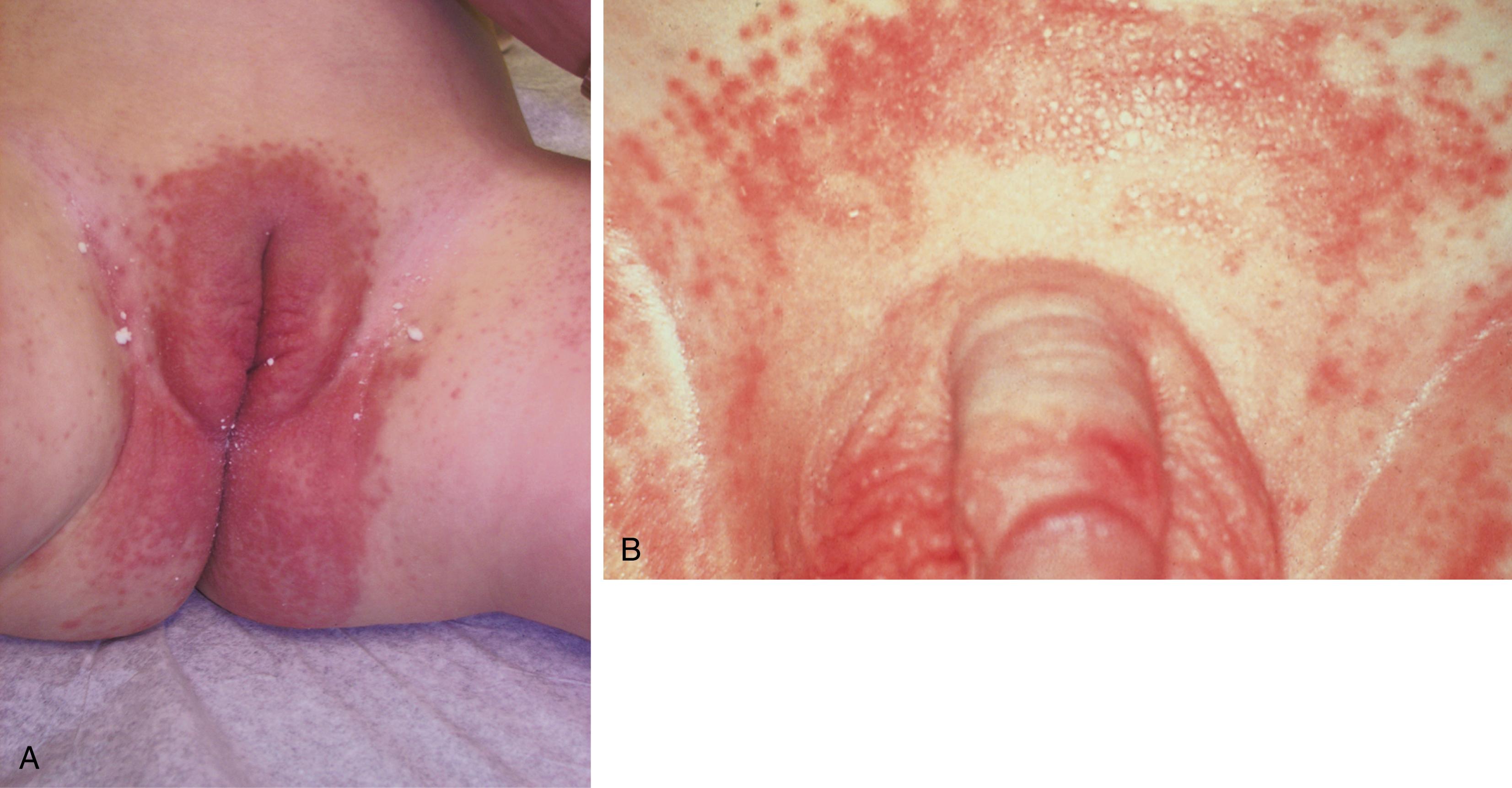
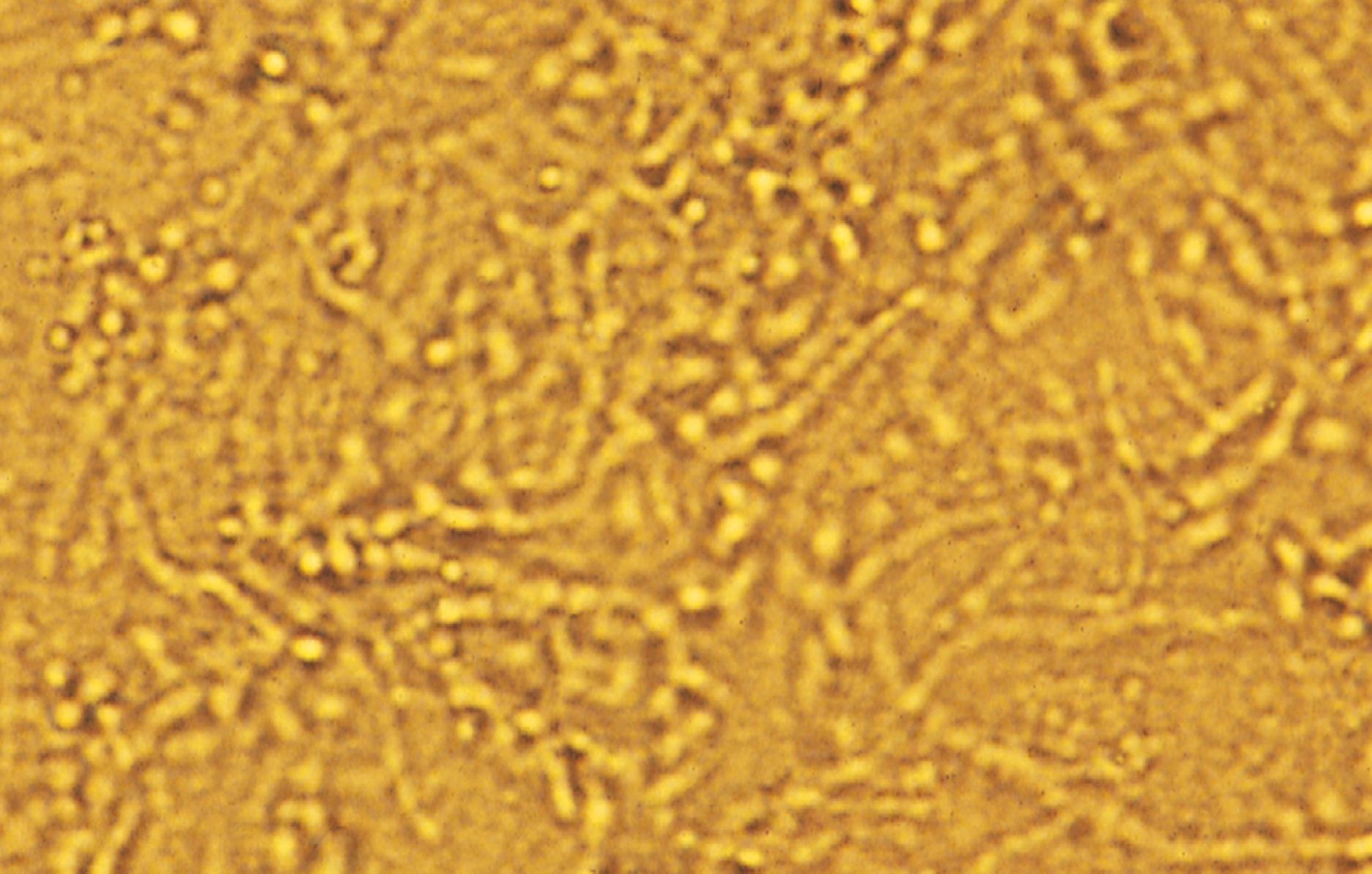
Irritant diaper dermatitis is frequently complicated by secondary staphylococcal infection, or pustules may appear as primary lesions, especially in the first few weeks of life. The presence of thin-walled pustules on an erythematous base (larger and more discrete than those seen with candidiasis) alerts the clinician to the diagnosis. Typically, these rupture rapidly and dry, producing a collarette of scaling around the denuded red base ( Fig. 8.45 ). A Gram stain of pustule contents demonstrates neutrophils and clusters of gram-positive cocci. Bacterial cultures are confirmatory but are rarely necessary. Early diagnosis and treatment with oral and topical antibiotics result in rapid resolution.
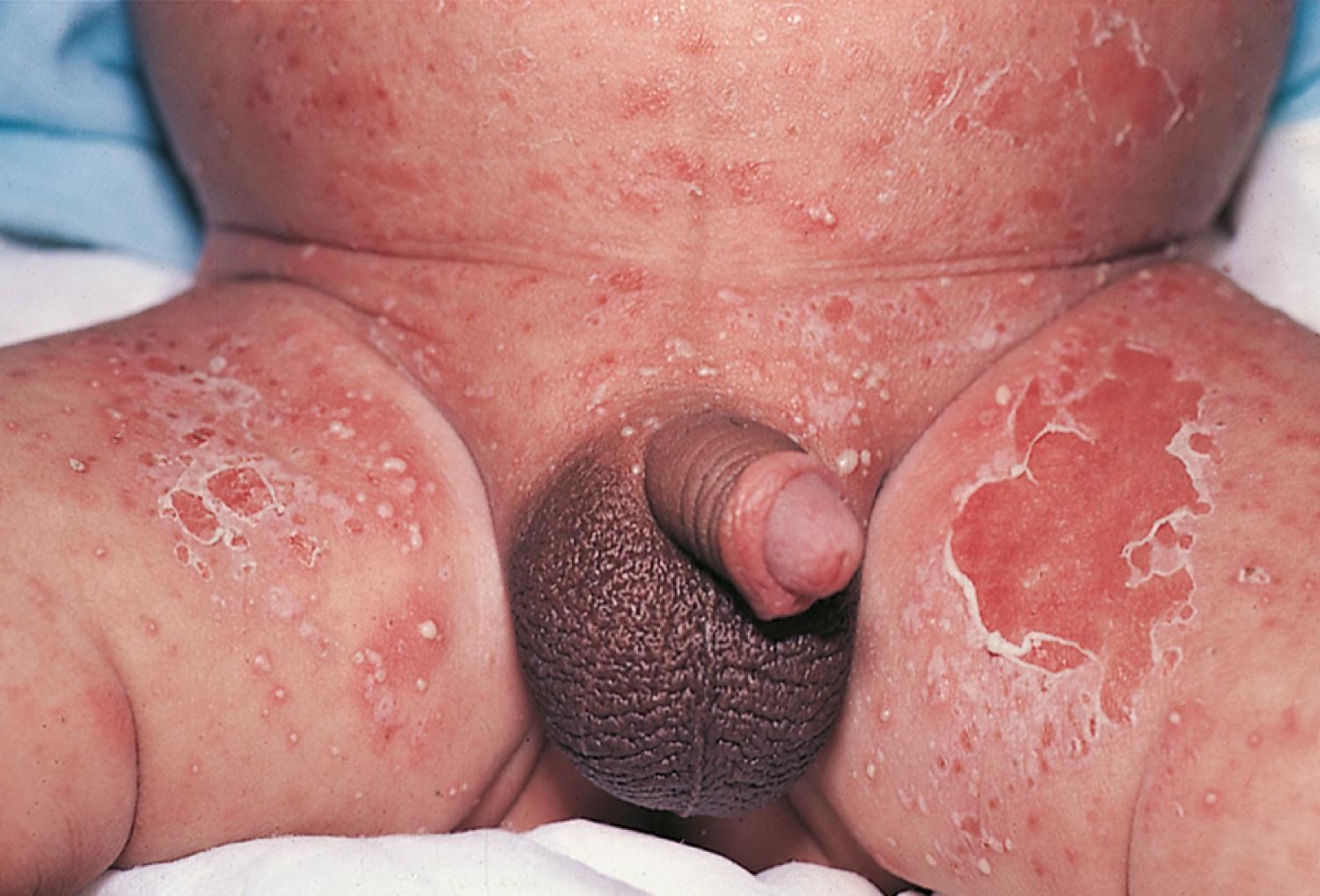
Perianal streptococcal dermatitis most commonly presents among children aged 6 months to 10 years, and it is characterized by a superficial, bright red perianal erythema with sharply defined margins extending 2 to 4 cm ( Fig. 8.46 ). These lesions commonly present with perianal itching, painful defecation, constipation, and blood-streaked stools, and they may be accompanied by superficial perianal fissures and mucoid discharge. The majority of cases described in the pediatric literature are caused by group A β-hemolytic streptococci (GAS), although infection with other groups of β-hemolytic streptococci are not uncommon. Concurrent or recent GAS pharyngitis has been reported in some cases, and oral-anal spread has been well documented as one route of transmission. Because the differential for perianal dermatitis is broad, delays in diagnosis and treatment are common. Perivaginal dermatitis may present with similar lesions, but it can be differentiated as a more widespread rash that is loosely centered around the anus. Bacterial culture of perianal and perineal swabs should be performed to confirm suspected cases, although an initial rapid antigen detection test for GAS may also be used to facilitate early diagnosis. Treatment with oral antibiotics for at least 14 days has been demonstrated to be an effective therapy. Due to the high recurrence rate, some patients may require a repeated course of antibiotics.
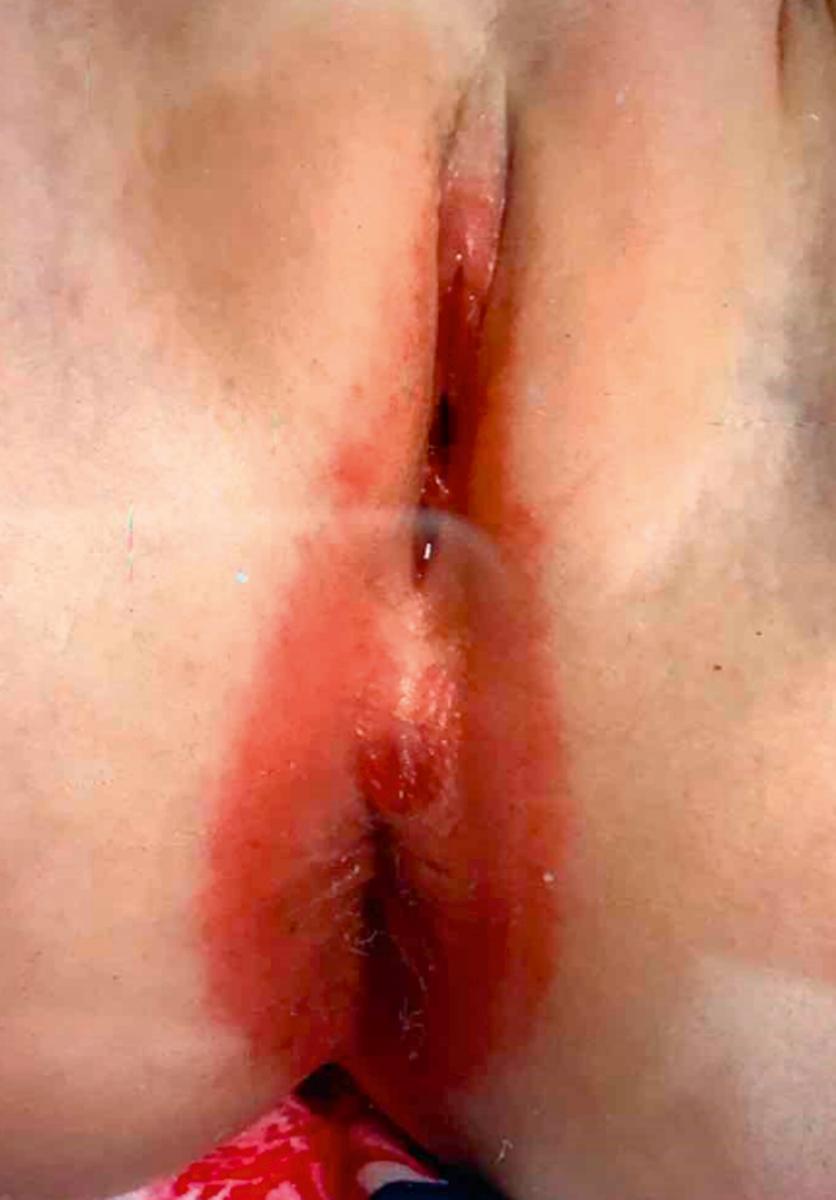
Seborrheic diaper dermatitis is characterized by confluent salmon-colored plaques with a yellowish scale. The rash is particularly prominent in the intertriginous areas (see Fig. 8.23B ). Although concurrent infection with Candida or Pityrosporum is likely, discrete satellite lesions are usually not seen. Typically, seborrheic dermatitis of the scalp, face, and postauricular areas is seen in association with this form of diaper dermatitis.
Psoriasis occasionally begins as an erythematous, scaling eruption in the diaper area ( Fig. 8.47 ), which is clinically indistinguishable from severe seborrheic diaper dermatitis. Perhaps because the diaper area is moist, the thick silvery scale typical of psoriatic lesions at other sites is not seen. Although lesions may develop subsequently on the trunk and extremities, the rash may persist for months in the diaper area alone. Failure of a seborrheic-like diaper rash to respond to empiric therapy over several weeks or months should raise psoriasis as a diagnostic possibility. Skin biopsy is the only way to confirm the diagnosis.
Although less common than the other dermatitides in the differential diagnosis of diaper dermatitis, tinea must be kept in mind when examining a scaly perineal rash. Its characteristic features are those of a recalcitrant scaly eruption with an elevated or “active” scaly border ( Fig. 8.48 ), from which scales can be scraped and tinea demonstrated on KOH preparation. It responds well to topical antifungals alone and should not be treated with topical steroids or with topical steroid plus antifungal combination products.
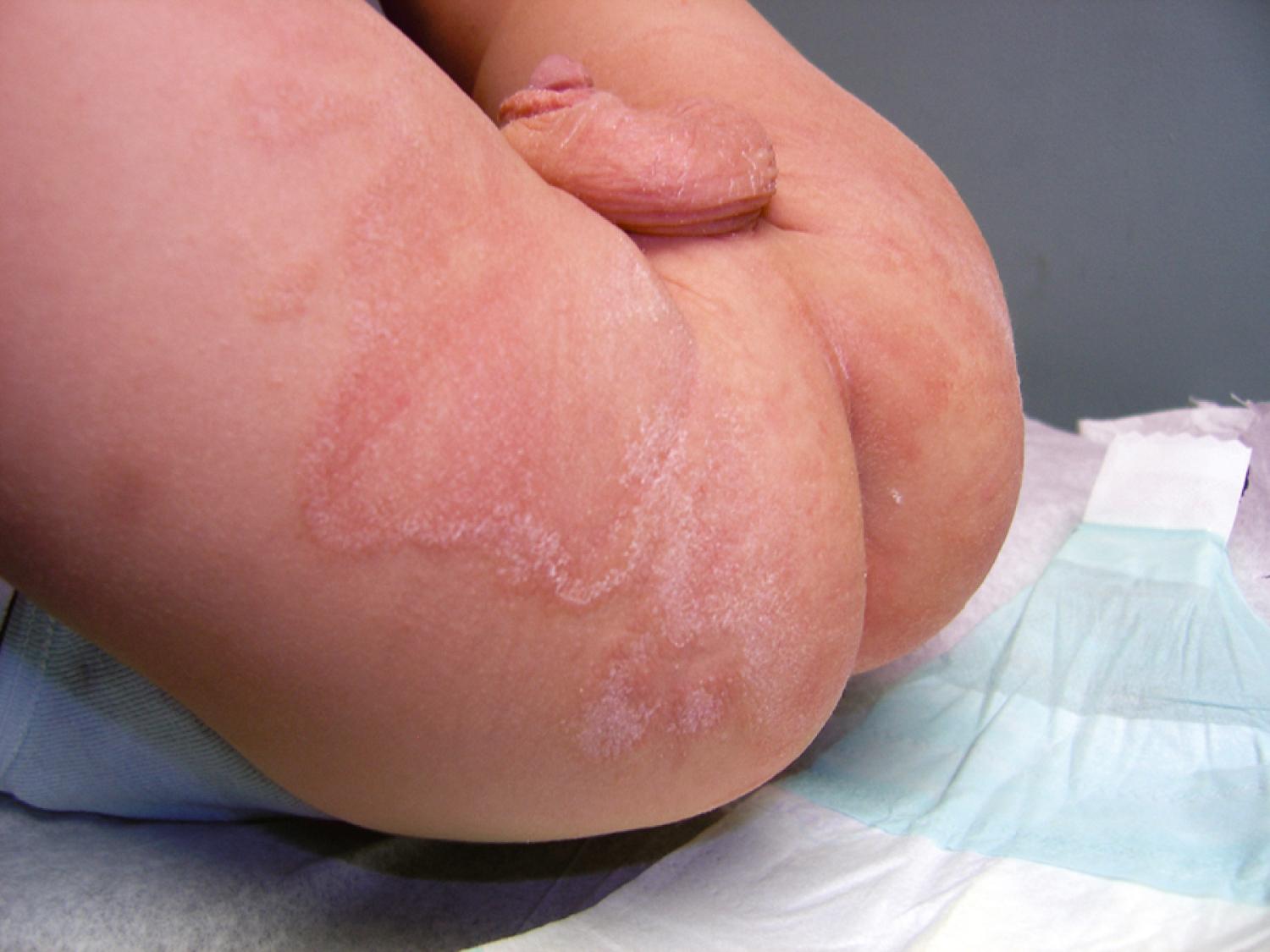
Lichen planus is the prototypic lichenoid inflammatory eruption in that it displays flat-topped pruritic polygonal violaceous papules and plaques, which have a fine lacy pattern (Wickham striae) over their outer surfaces. They are often noted first over the dorsal surfaces of the extremities and can display koebnerization at sites of prior trauma ( Fig. 8.49 ). The disorder may involve the nails (leading to dystrophy), as well as the oral and genital mucosa, where lesions appear as lacy white plaques. Topical steroids are the mainstay of initial treatment. After resolution of primary lesions, a prolonged period of postinflammatory hyperpigmentation can be expected (see Fig. 8.116 ).
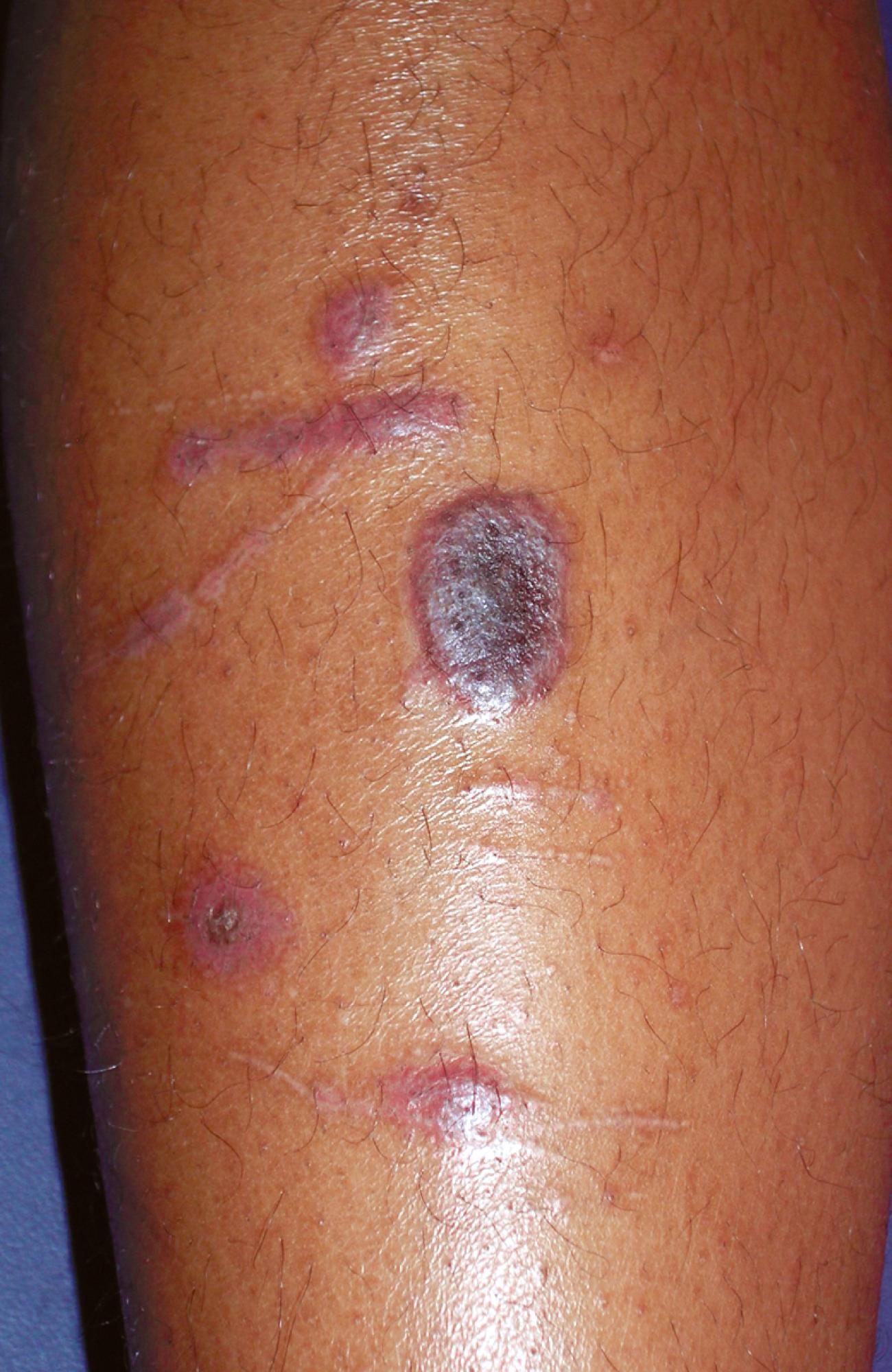
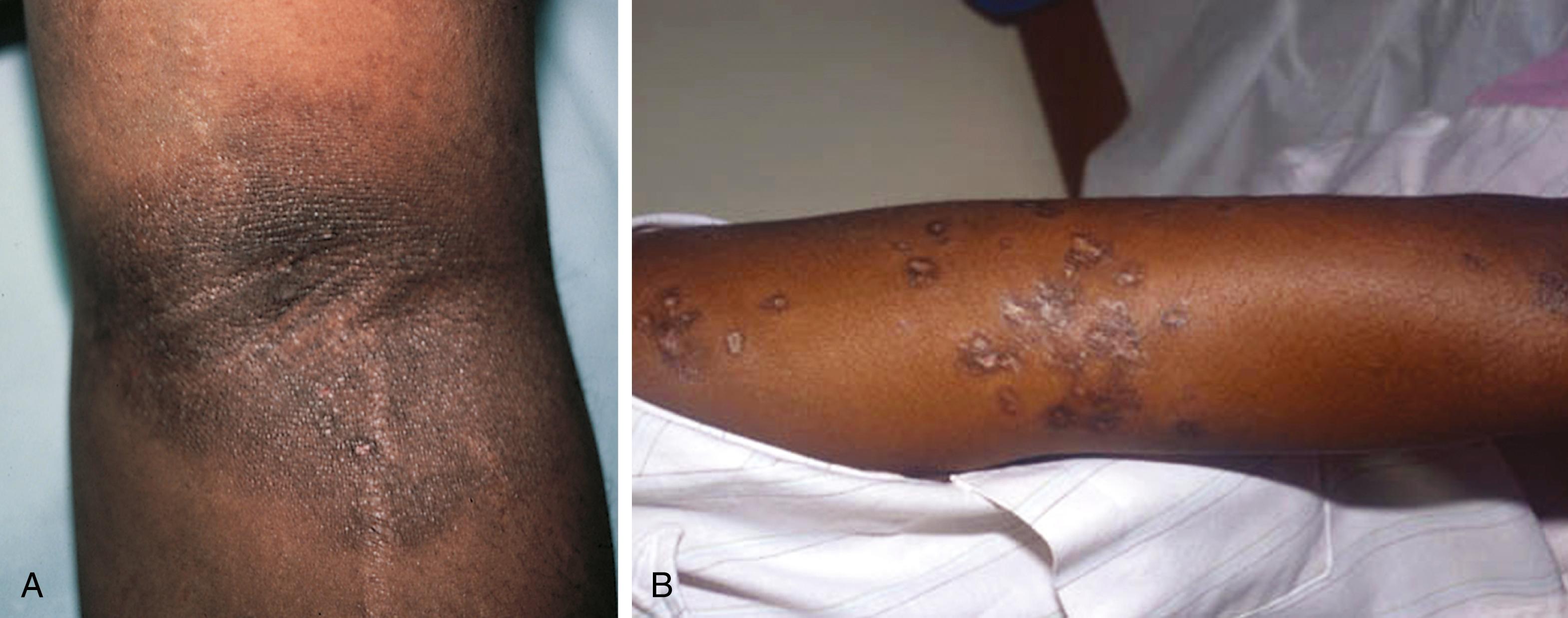
Lichen striatus is one of the more common and distinctive lichenoid papulosquamous eruptions. Lesions consisting of flat-topped papules appear fairly abruptly, usually in a linear or sometimes swirled distribution along the lines of Blaschko. Although they may involve any portion of the skin, they are more typically located on the extremities, neck, or upper back. They may initially be slightly erythematous but often progress through an often-prolonged phase of hypopigmentation, and their surfaces are covered with fine scale ( Fig. 8.50 ). When lesions form on a digit, lichen striatus can lead to a temporary linear nail dystrophy. The cause of this otherwise asymptomatic disorder, which has its peak incidence in school-age children, is unknown, but it is hypothesized that molecular mimicry between a virus and antigens on a single line of keratinocytes is to blame. Spontaneous resolution within 1 to 3 years is the norm.
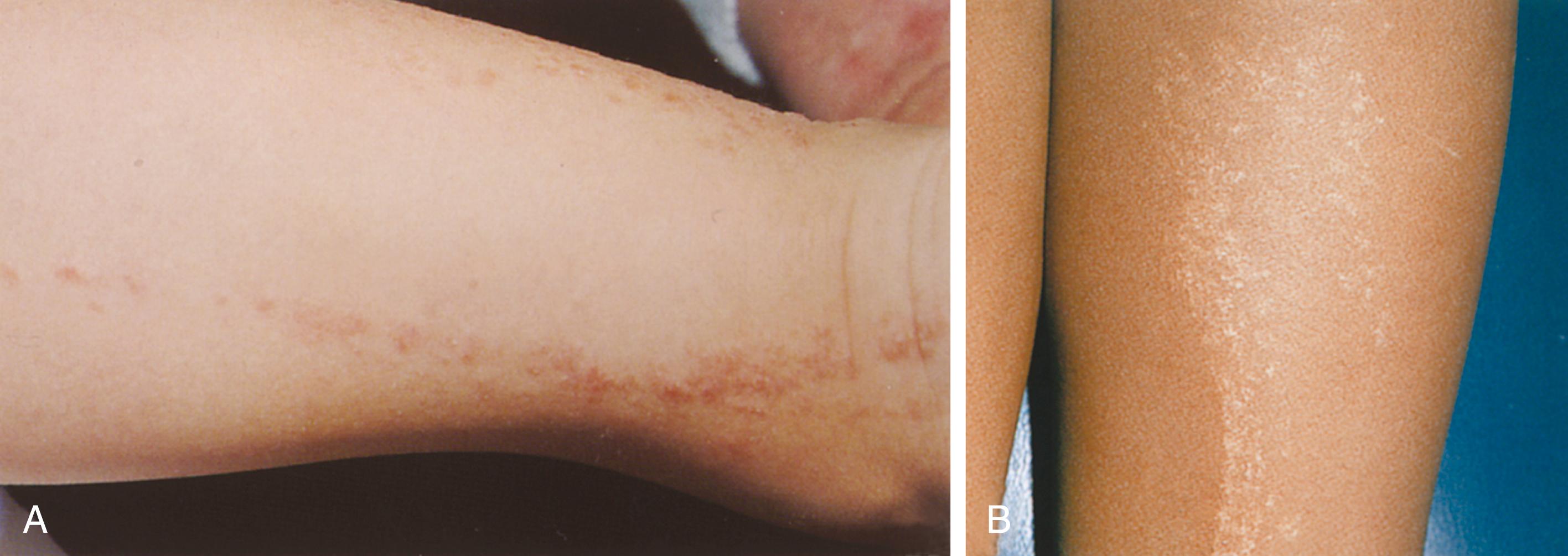
Vesiculopustular eruptions range from benign, self-limited conditions to life-threatening diseases. Early diagnosis, especially in the young child, is mandatory. Systematic evaluation of the clinical findings and a few rapid diagnostic techniques allow these various disorders to be readily differentiated from one another.
Viral infections including herpes simplex and varicella-zoster produce characteristic vesiculopustular eruptions, which are discussed in Chapter 13 . However, the technique of confirming the suspicion of a herpetic lesion by preparing a Tzanck test is discussed here.
The Tzanck smear is obtained by removing the roof of a vesicle with a scalpel or scissors and scraping the cells at its base. This is then spread onto a glass slide with the scalpel blade, air dried, and stained with Giemsa or Wright stain. The diagnostic finding in viral blisters is the multinucleated giant cell ( Fig. 8.51 ). This is a syncytium of epidermal cells with multiple, overlapping nuclei; hence it is much larger than other inflammatory cells. Unfortunately, a positive Tzanck test cannot be used to differentiate one blistering viral exanthem from another, and a viral culture, the more rapid direct fluorescent antibody test, and/or polymerase chain reaction (PCR) should be done when the clinical situation mandates precise or more rapid identification.
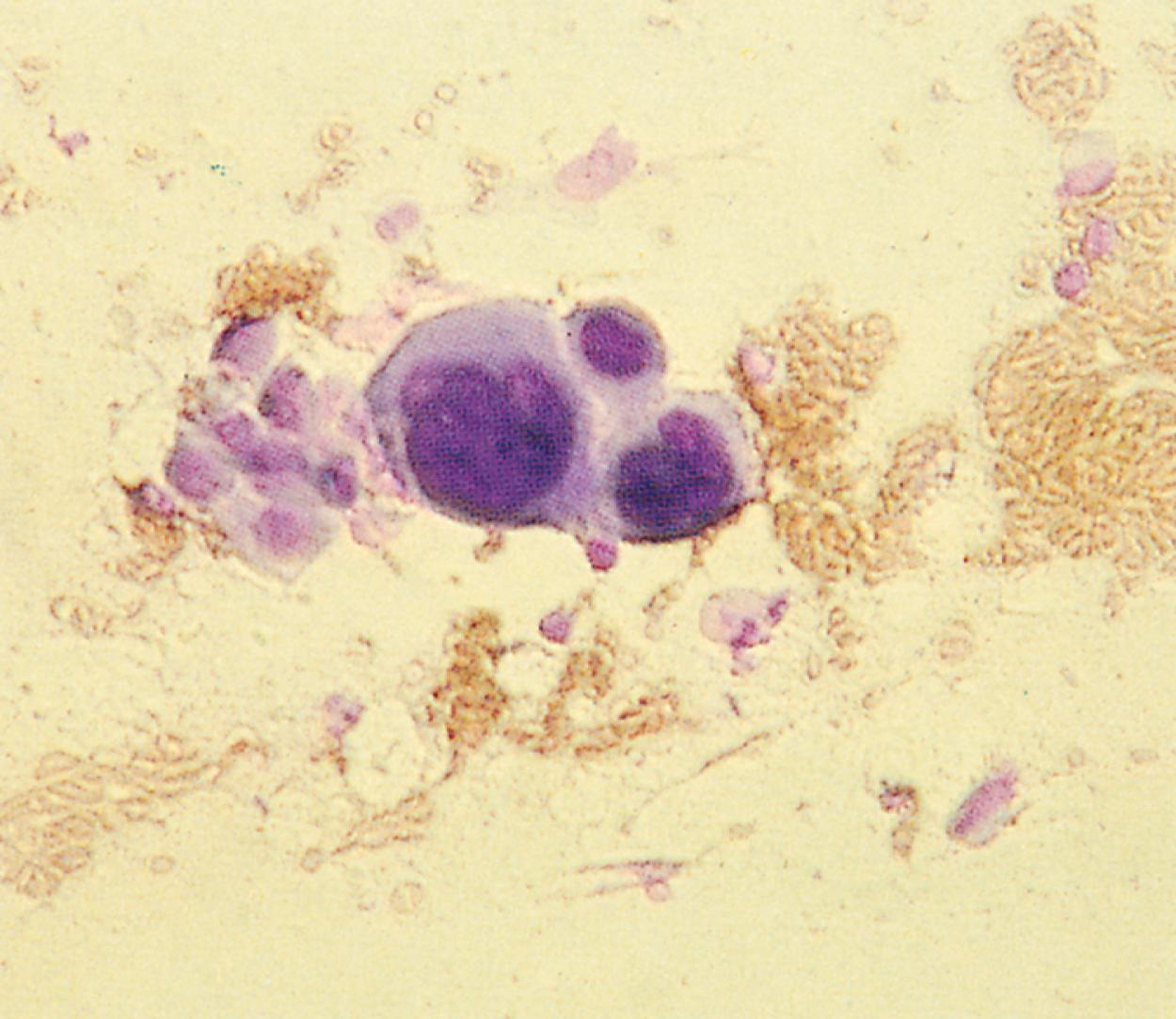
Several common cutaneous bacterial infections present with vesiculopustular reactions as well. In impetigo, the eruption tends to be discrete and localized, whereas in staphylococcal scalded skin syndrome (SSSS) it tends to be associated with a diffuse erythroderma. A Gram stain of material aspirated from bullae or removed from the base of an impetiginous lesion is positive for organisms. However, in patients with SSSS, the organism must be sought from distant cutaneous sites or from any of a number of possible noncutaneous colonized locations (nasopharynx, conjunctivae, sinuses) because the diffuse cutaneous erythema and blistering is due to elaboration of the toxin epidermolysin by the infecting organism and not to the organism’s direct action within individual lesions (see Chapter 13 ).
Blistering distal dactylitis is a superficial bacterial infection involving the tips of the pads of fingers or toes. Lesions consist of tense blisters 0.5 to 1 cm in diameter that are filled with thin purulent fluid and surrounded by a narrow erythematous rim. With evolution, they may coalesce and extend proximally along the lateral aspect of the nail fold. On rupture, a thick crust forms ( Fig. 8.52 ). GAS are the usual causative organisms and are detected by Gram stain and culture of vesicular fluid. On occasion, group B streptococci and S. aureus are isolated. The disorder can be distinguished from a paronychia by the distal location of initial lesions; from a herpetic whitlow by the larger size of the initial vesicles and Gram stain of the purulent fluid; and from burns by the purulence of the vesicular fluid and Gram stain revealing white blood cells and bacteria.
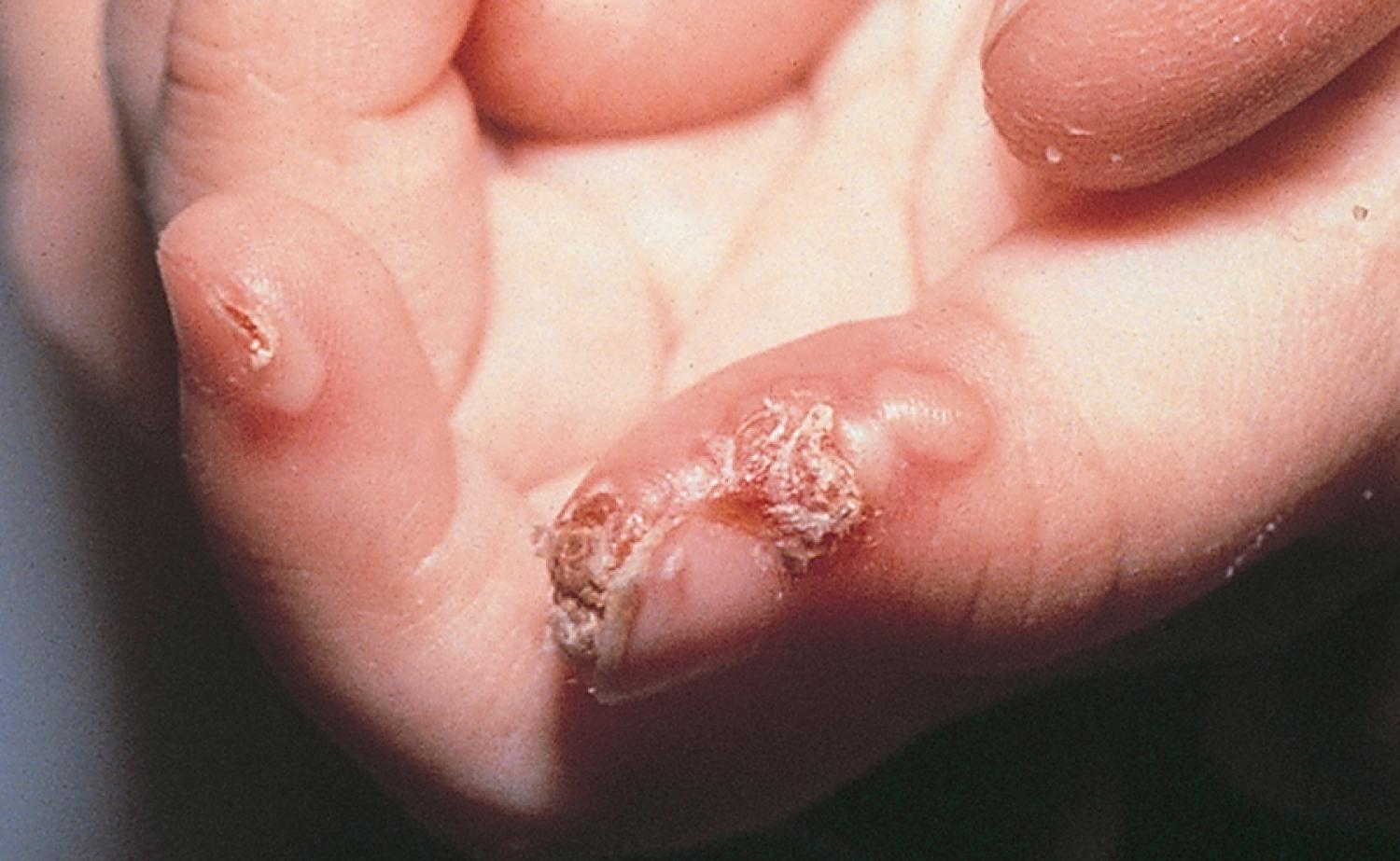
Mycoplasma pneumoniae is a common cause of atypical pneumonia, particularly among young patients, and infection is associated with mucocutaneous eruptions. Because of its extensive mucosal involvement and vesiculobullous lesions, Mycoplasma -induced rash and mucositis (MIRM) may be challenging to distinguish from drug-induced EM and Stevens-Johnson syndrome (SJS)/toxic epidermal necrolysis (TEN). However, key differences in morphologic and clinical outcomes distinguish MIRM as a distinct syndrome.
Patients with MIRM almost universally present with prodromal symptoms 1 week prior to eruption, including cough, malaise, and fever. Eruptions are characterized by predominant mucositis, with oral, ocular, and urogenital involvement possible ( Fig. 8.53 ). Although cutaneous involvement may be severe, over half of reported cases had sparse and scattered lesions; when present, vesiculobullous or targetoid morphologies with an acral and extremity-predominant distribution are most common. Histopathology of biopsied lesions reveal keratinocyte apoptosis and mucosal necrosis that is largely indistinguishable from EM or SJS. The predominance of MIRM among young males, extensive mucosal involvement with sparse cutaneous findings, and a more benign disease course distinguish this disorder from other mucocutaneous eruptions. Genital and oral erosions resembling MIRM may be secondary to Chlamydia pneumoniae infection; hence screening for chlamydia should also be included in the workup.
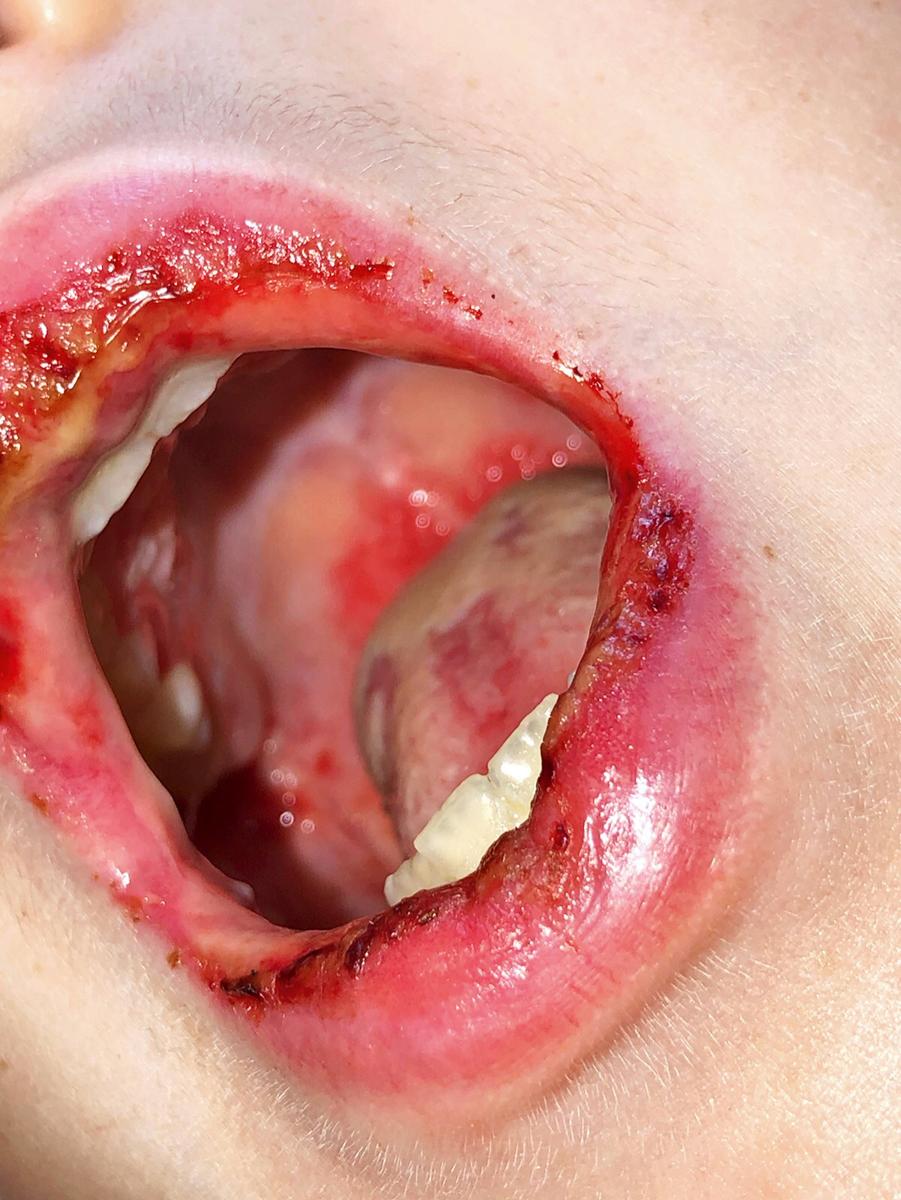
Although no evidence-based therapy for MIRM has yet been established, oral antibiotics and systemic glucocorticoids are commonly administered, particularly in the context of an ongoing respiratory infection. The efficacy of these therapies in reducing the severity of skin findings remains unclear, and supportive care is generally the mainstay of treatment.
Become a Clinical Tree membership for Full access and enjoy Unlimited articles
If you are a member. Log in here